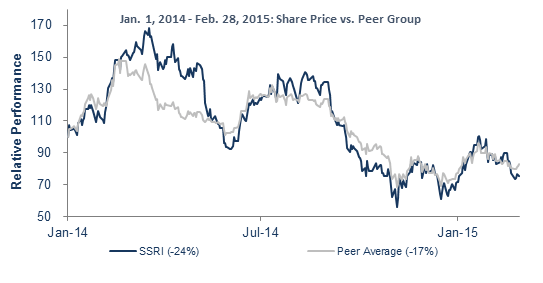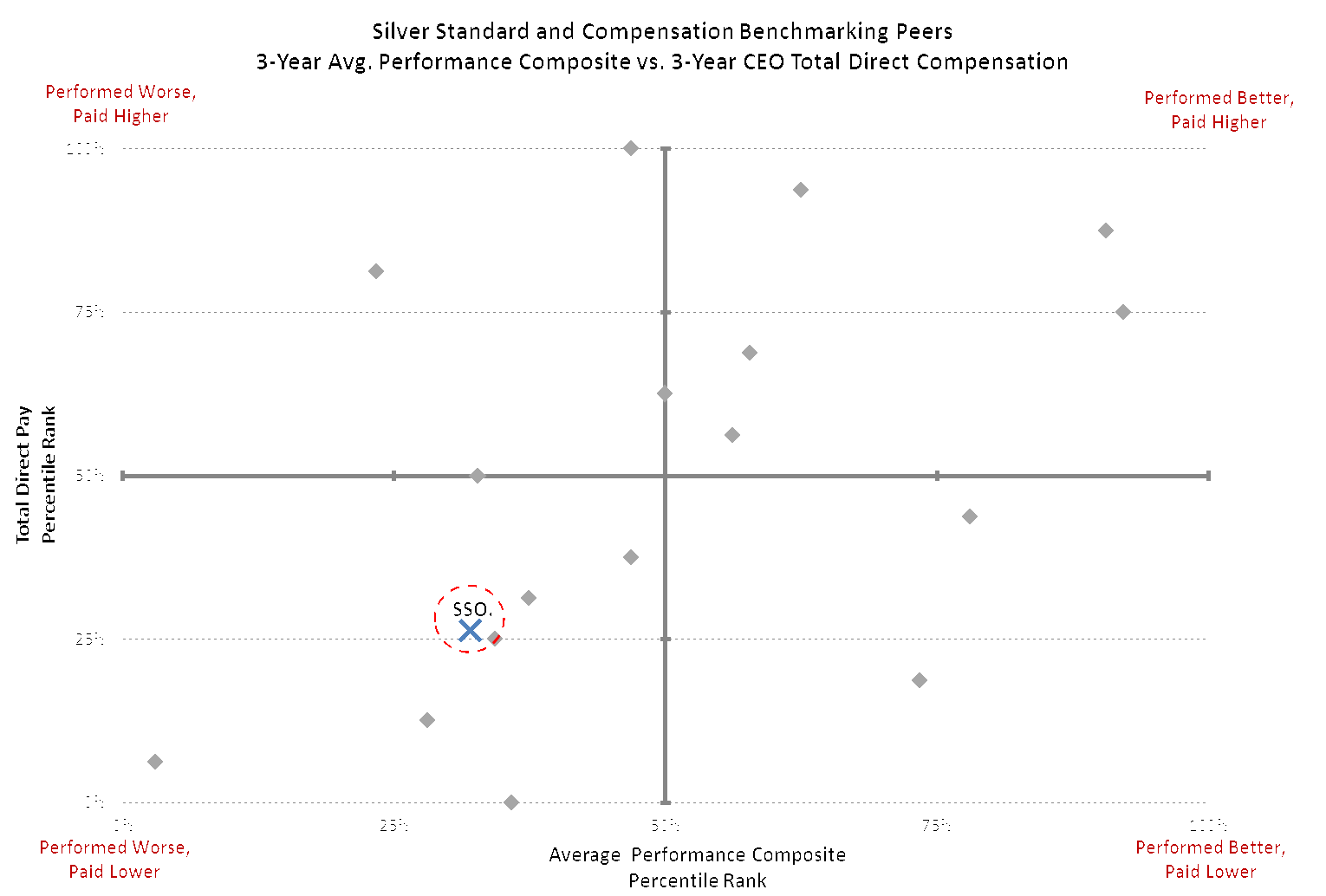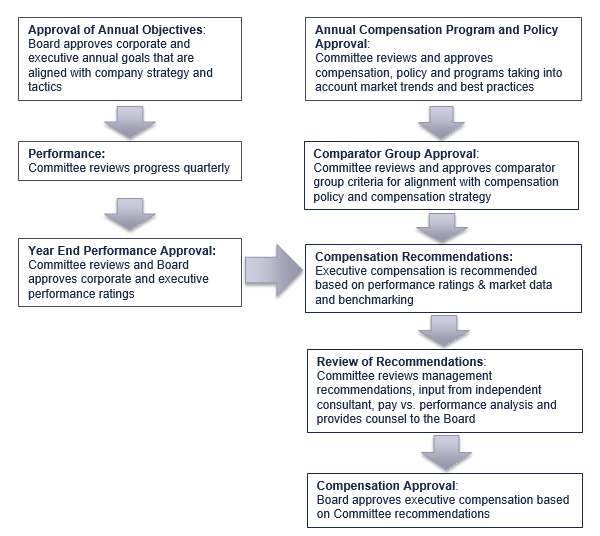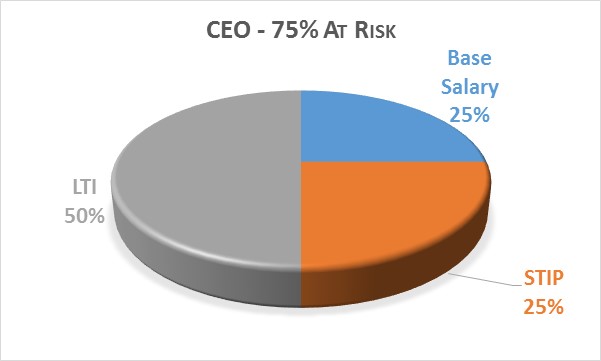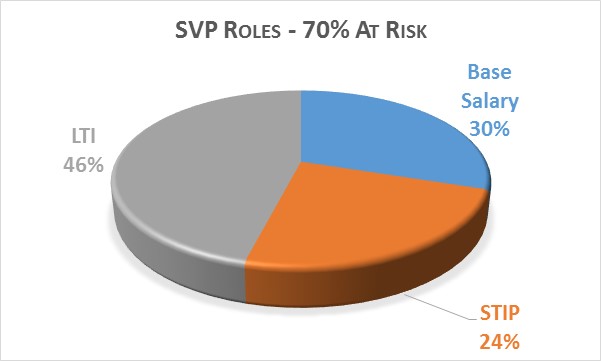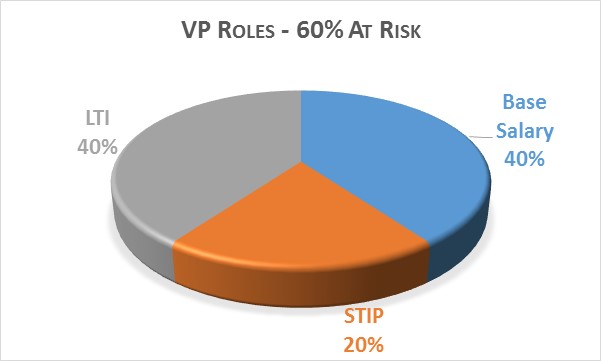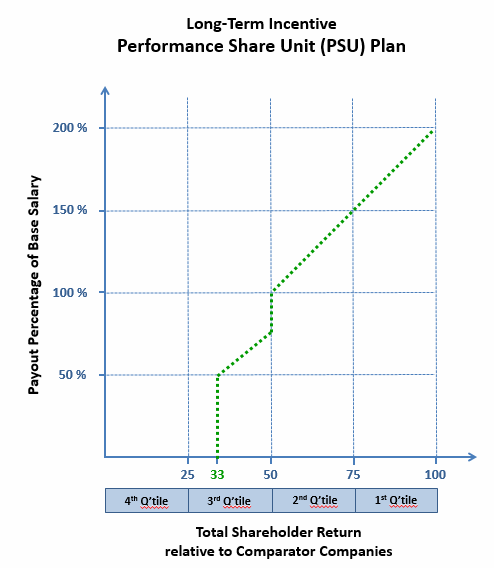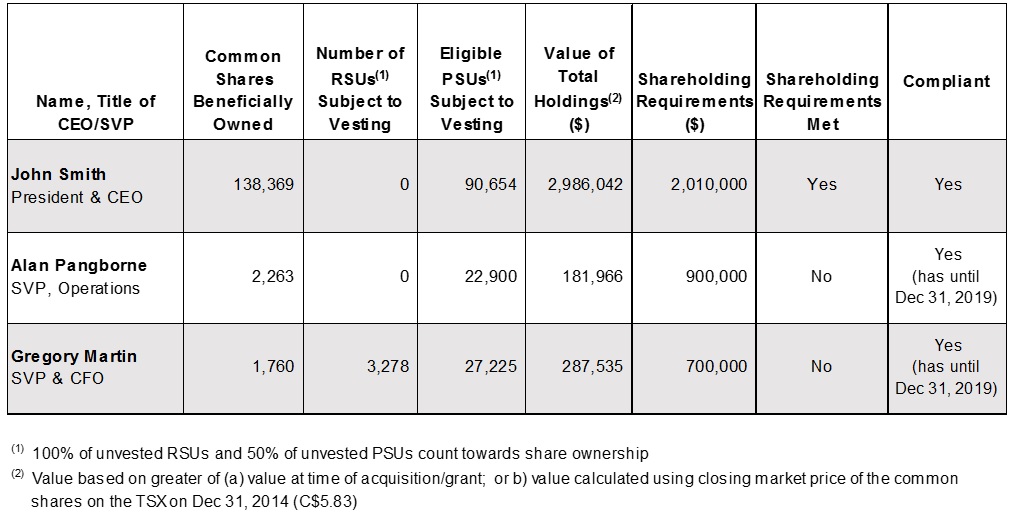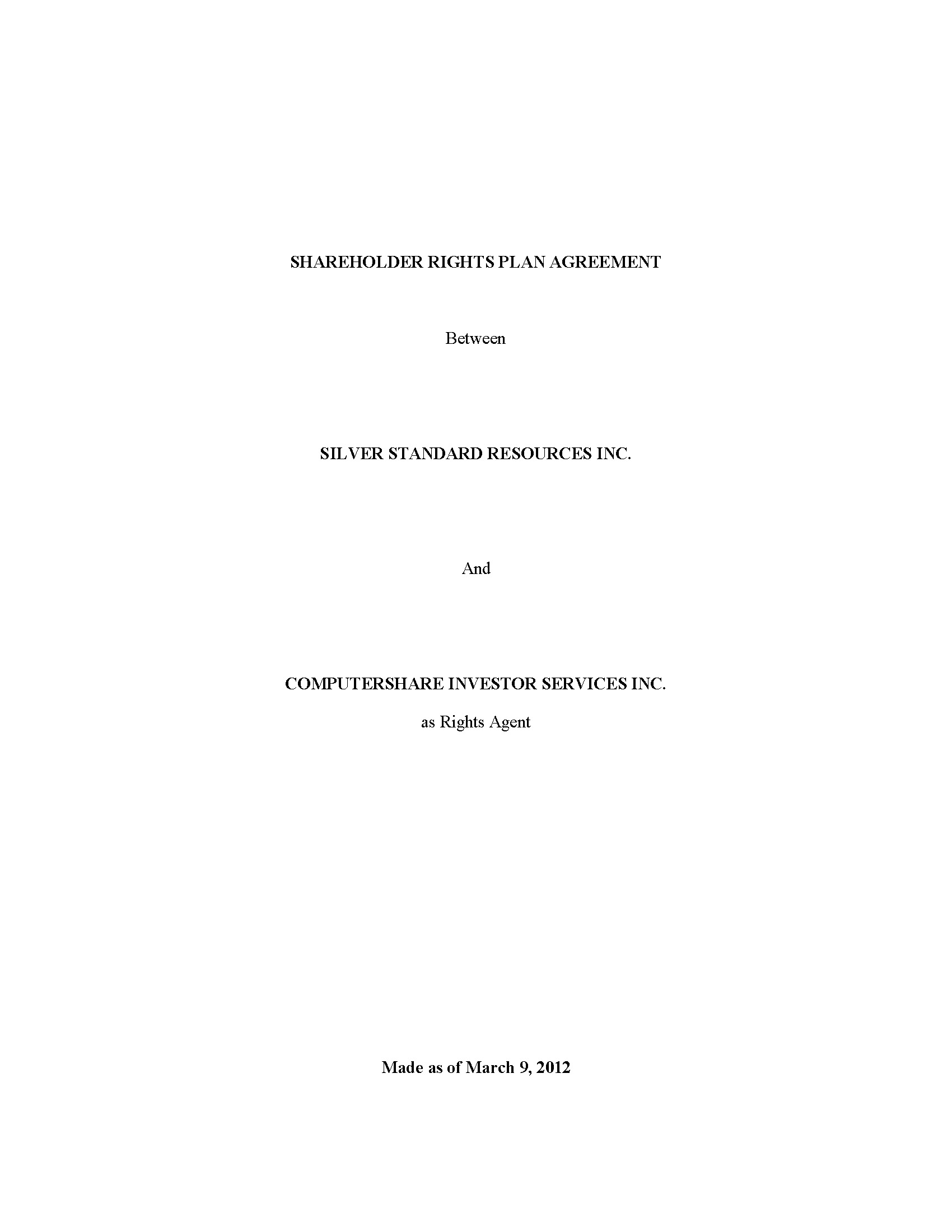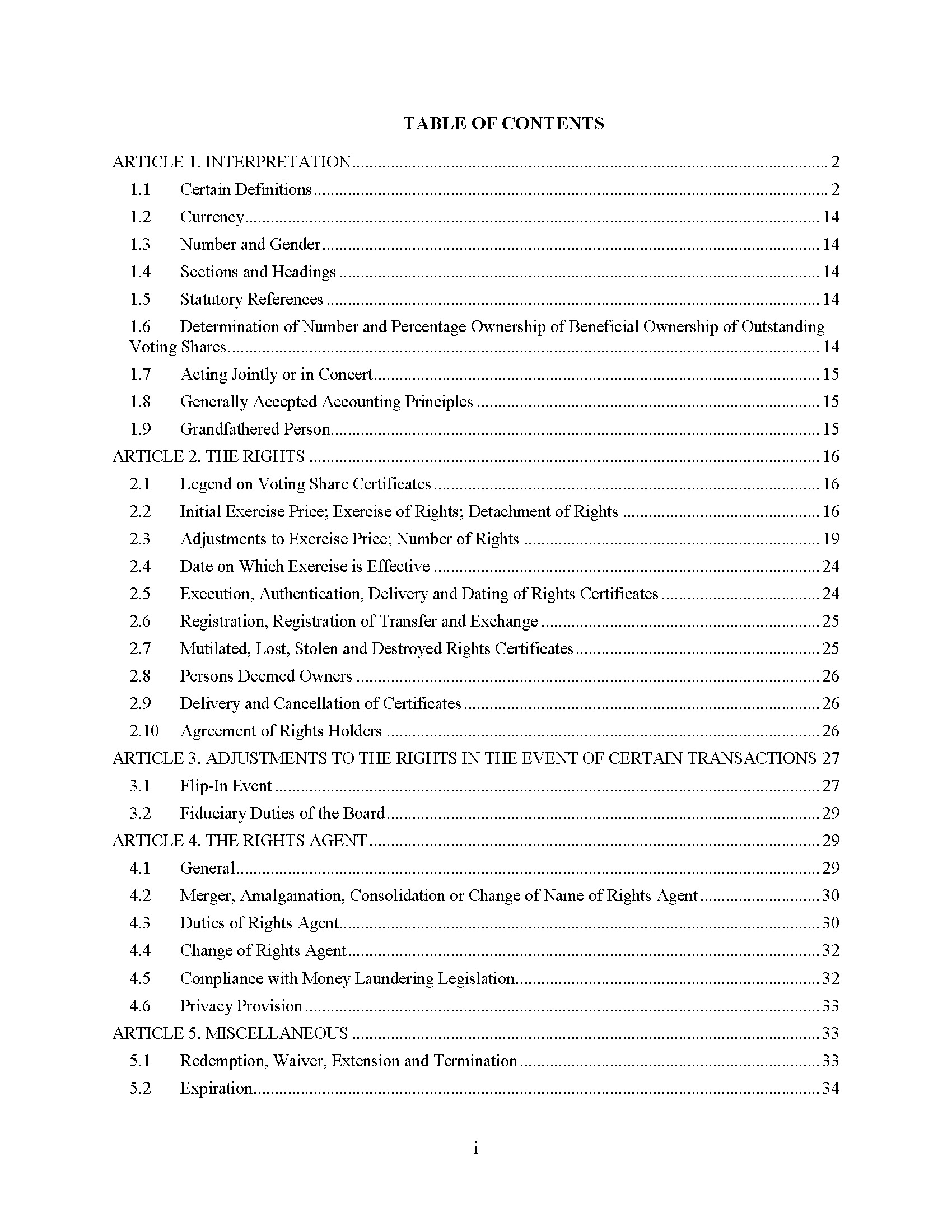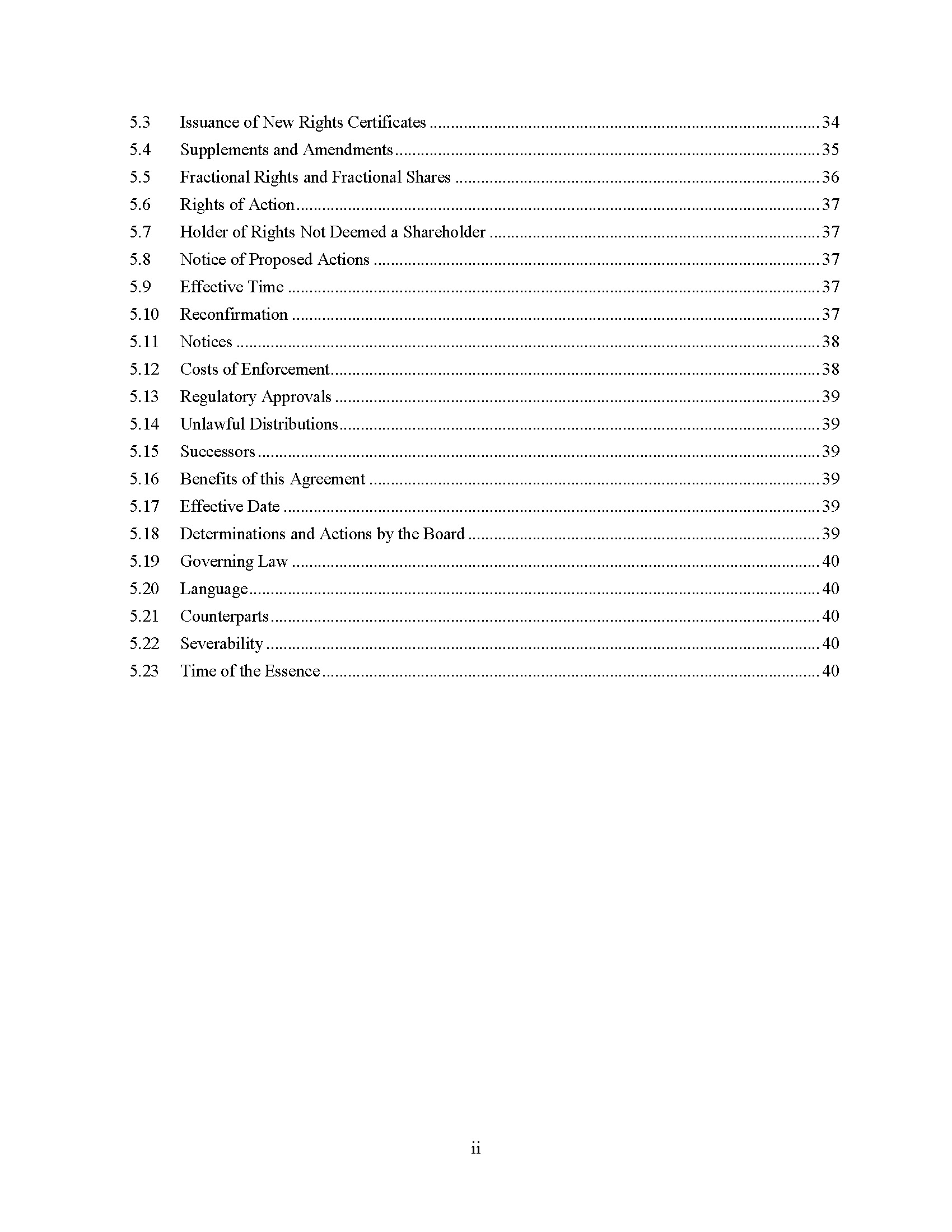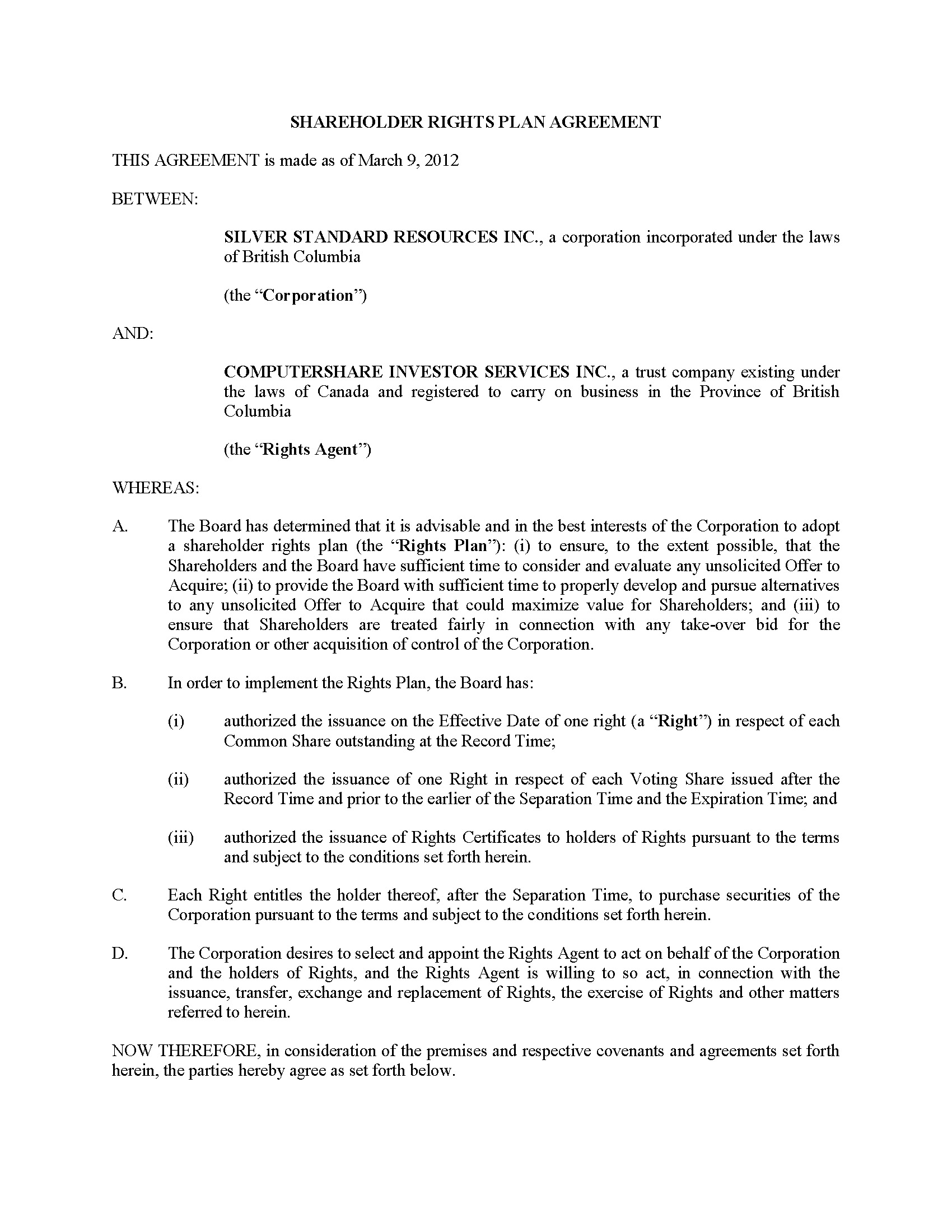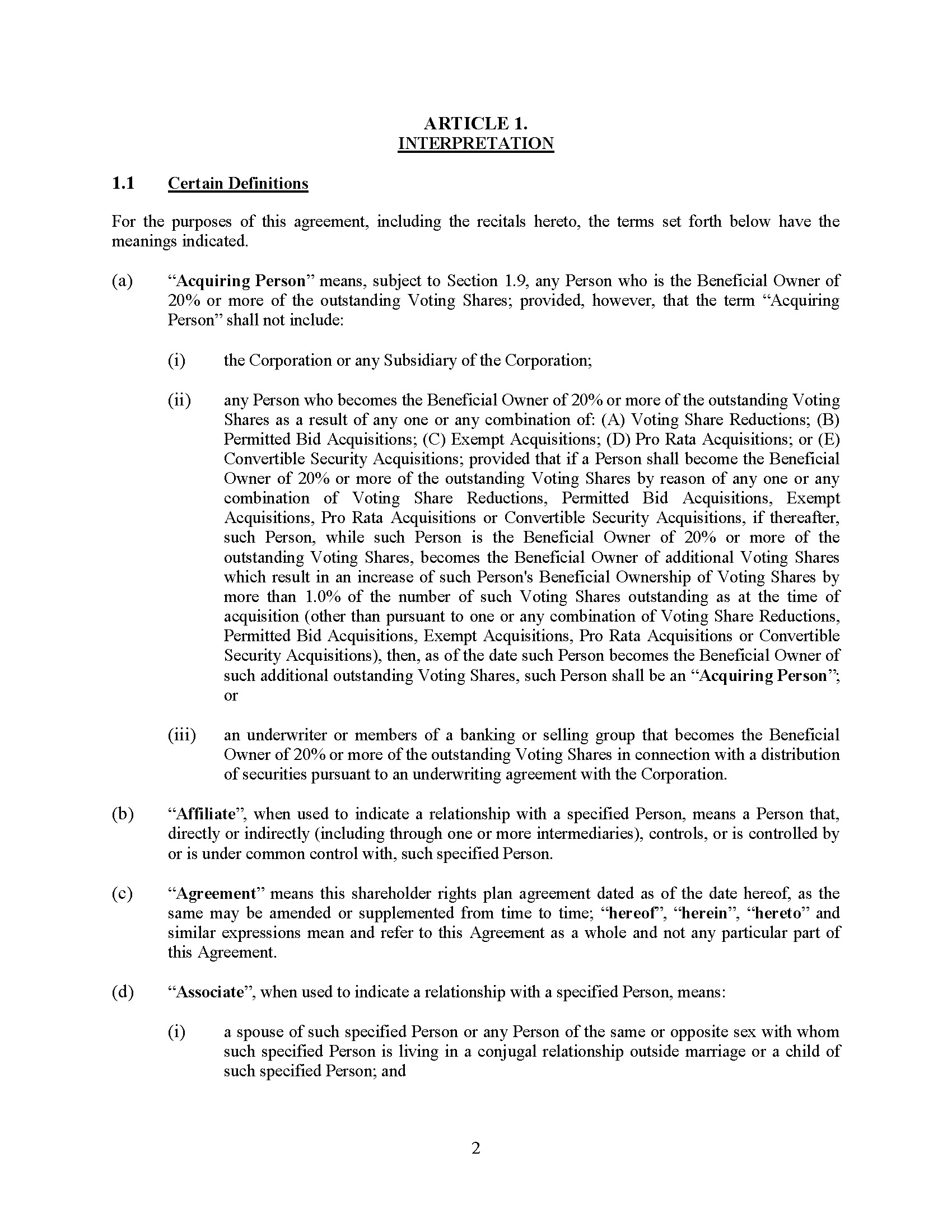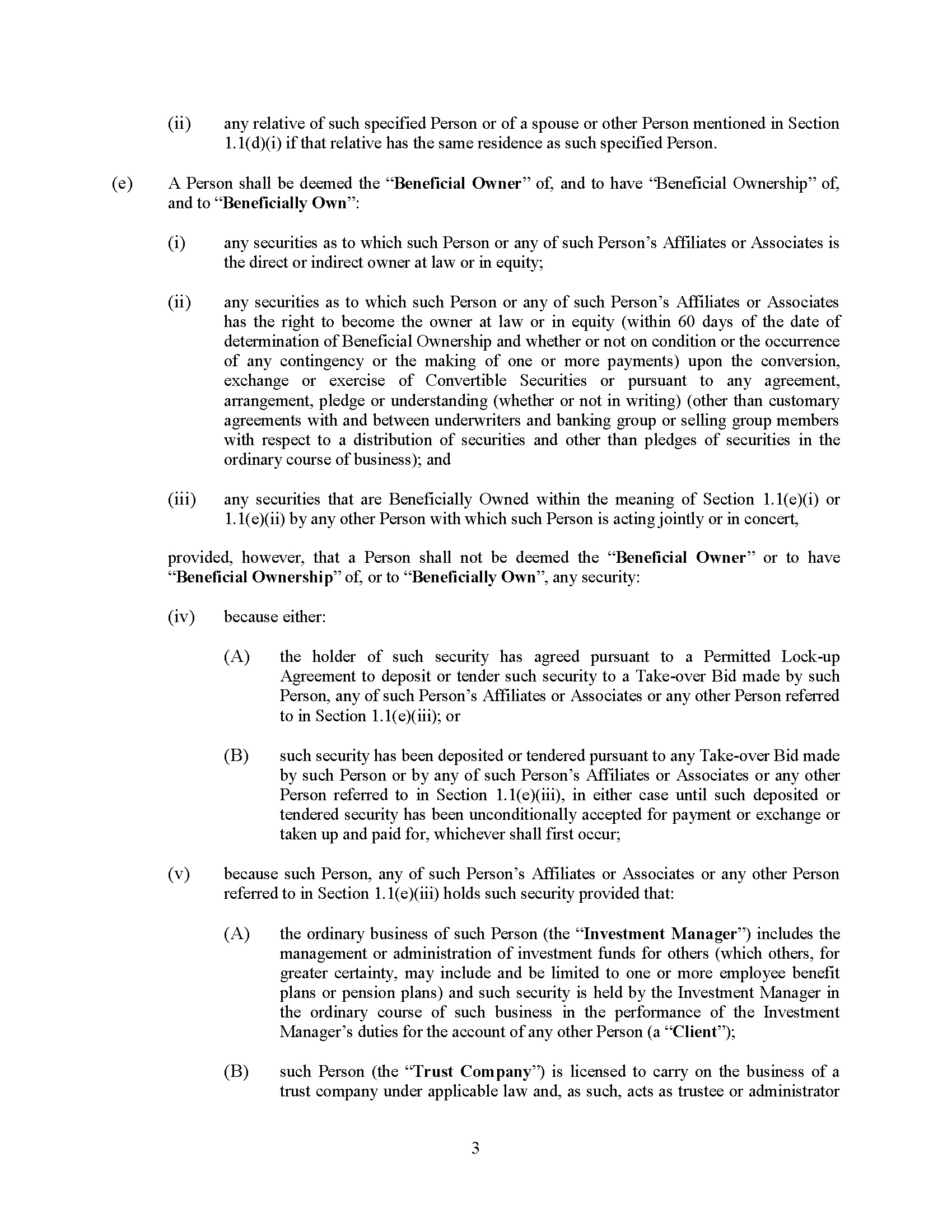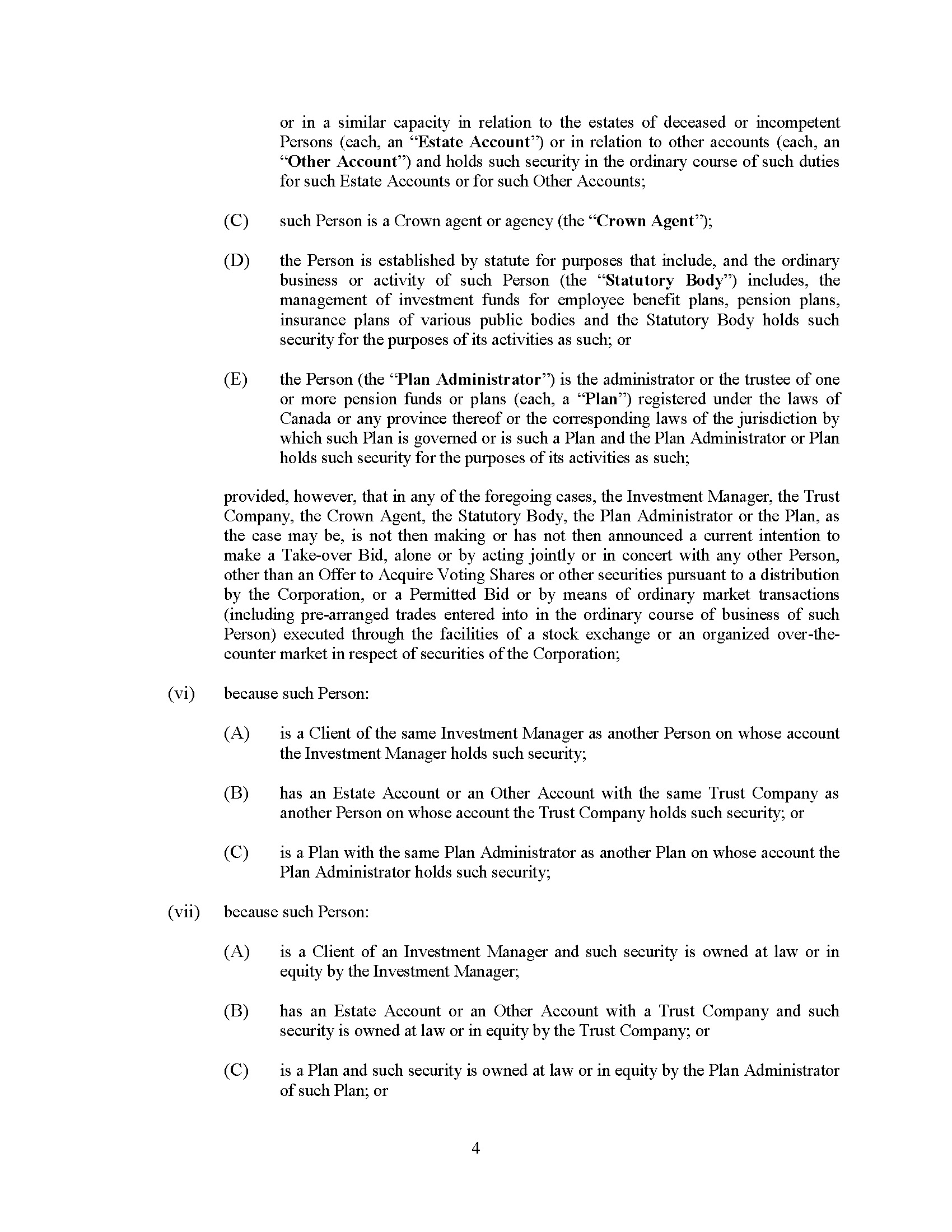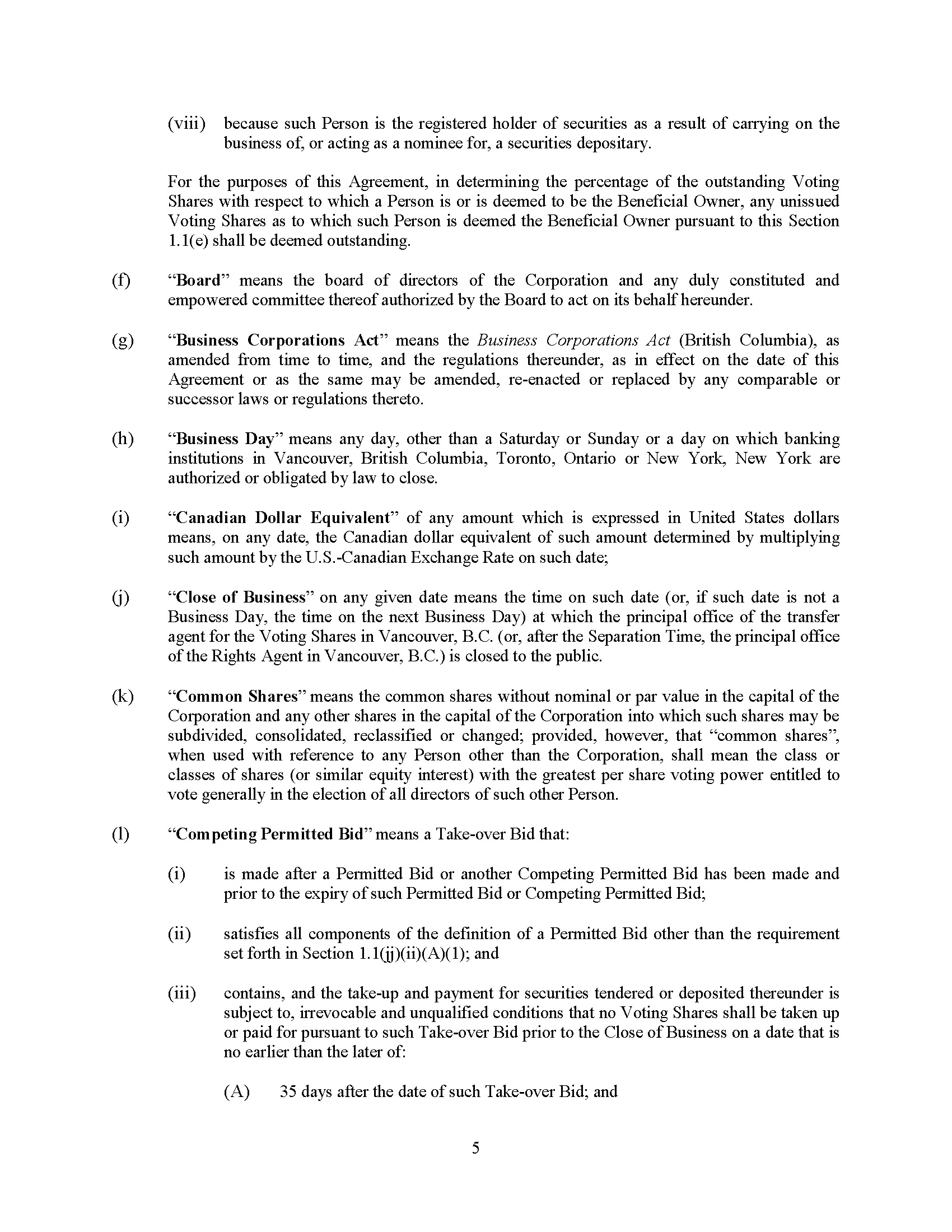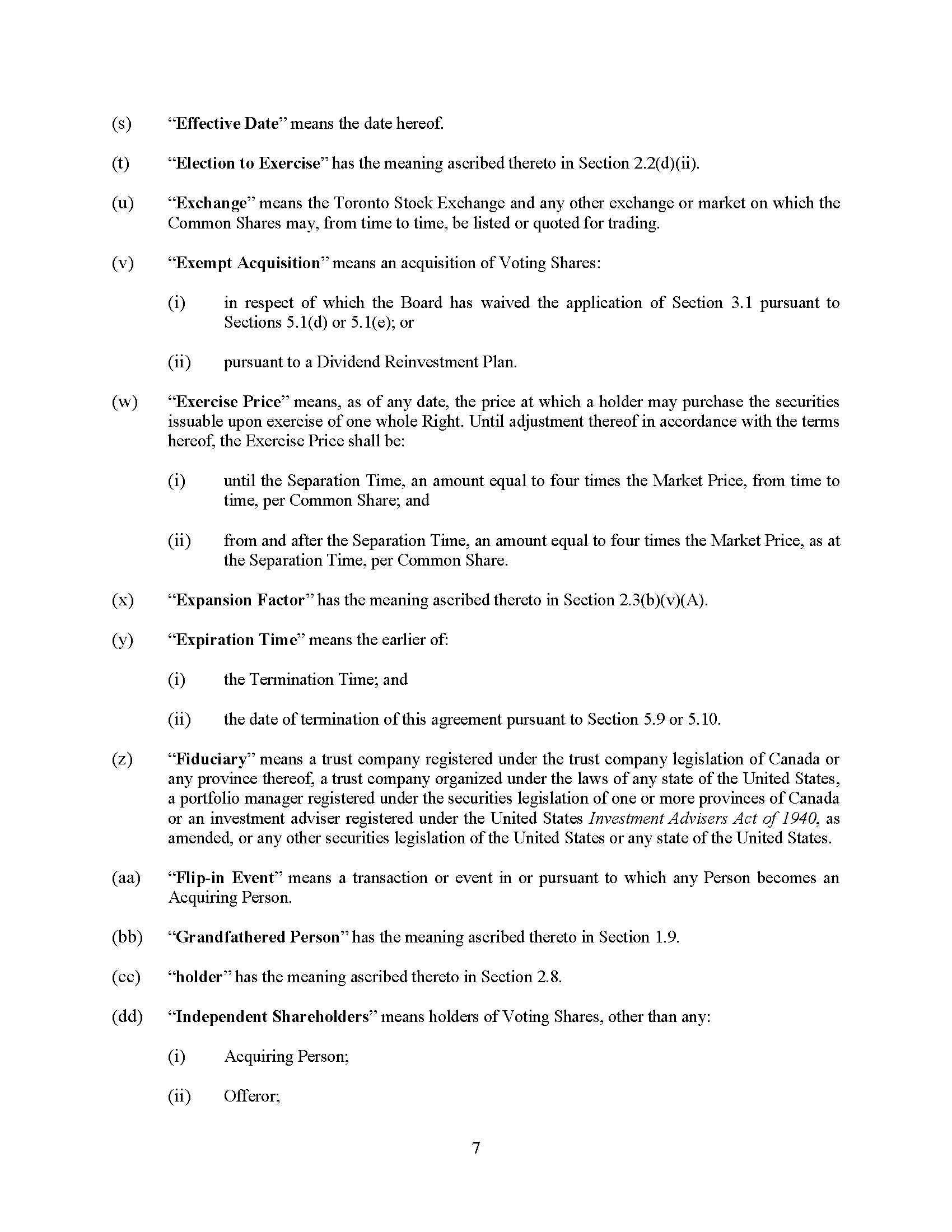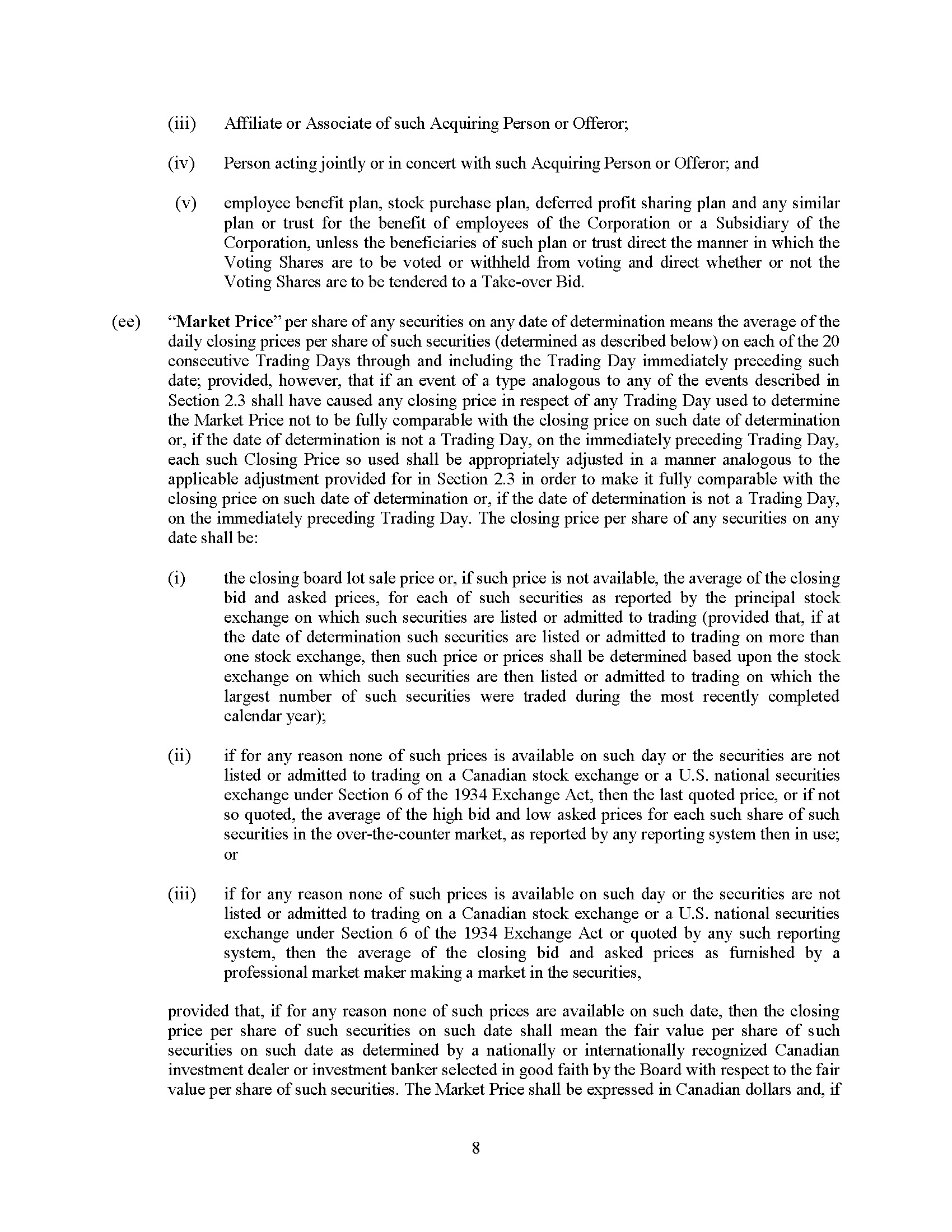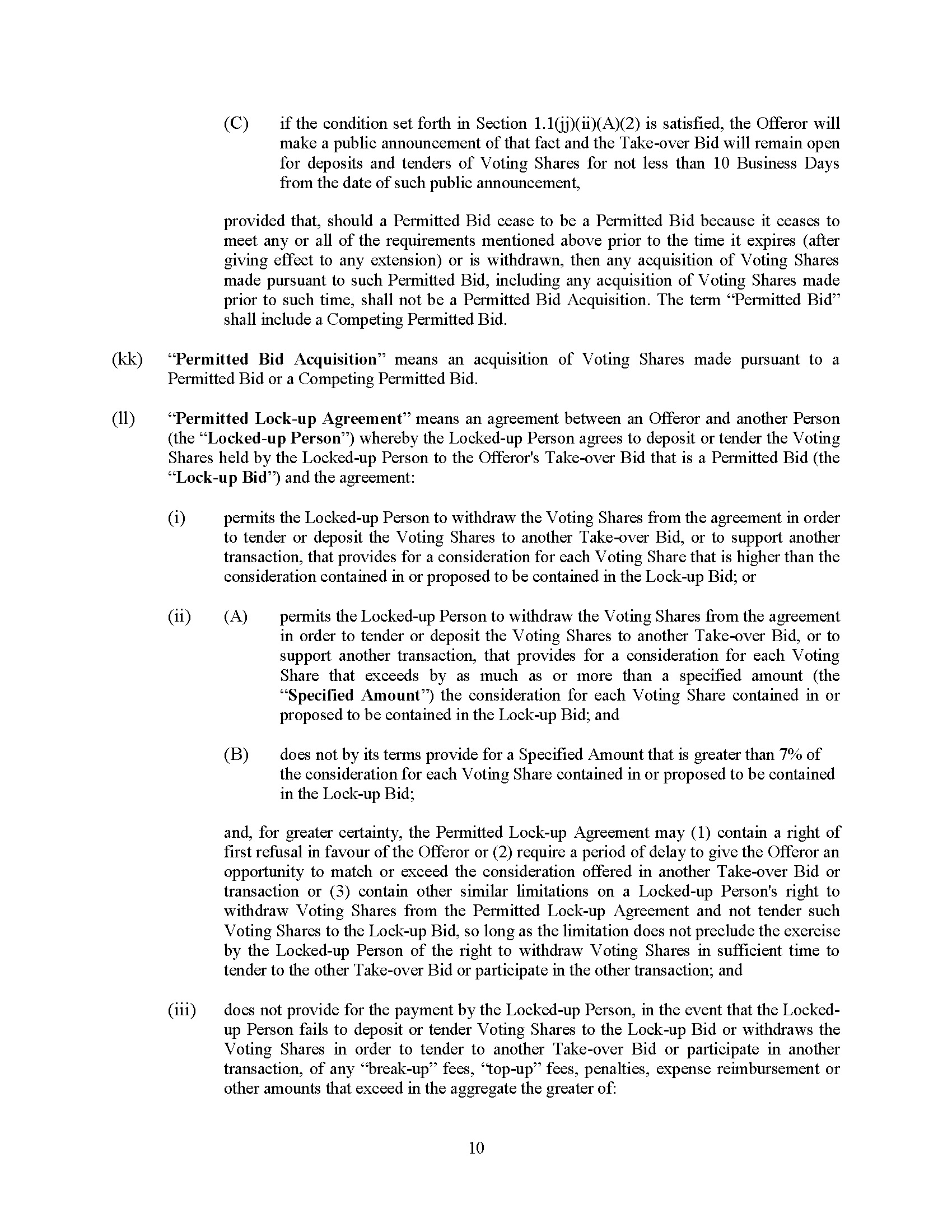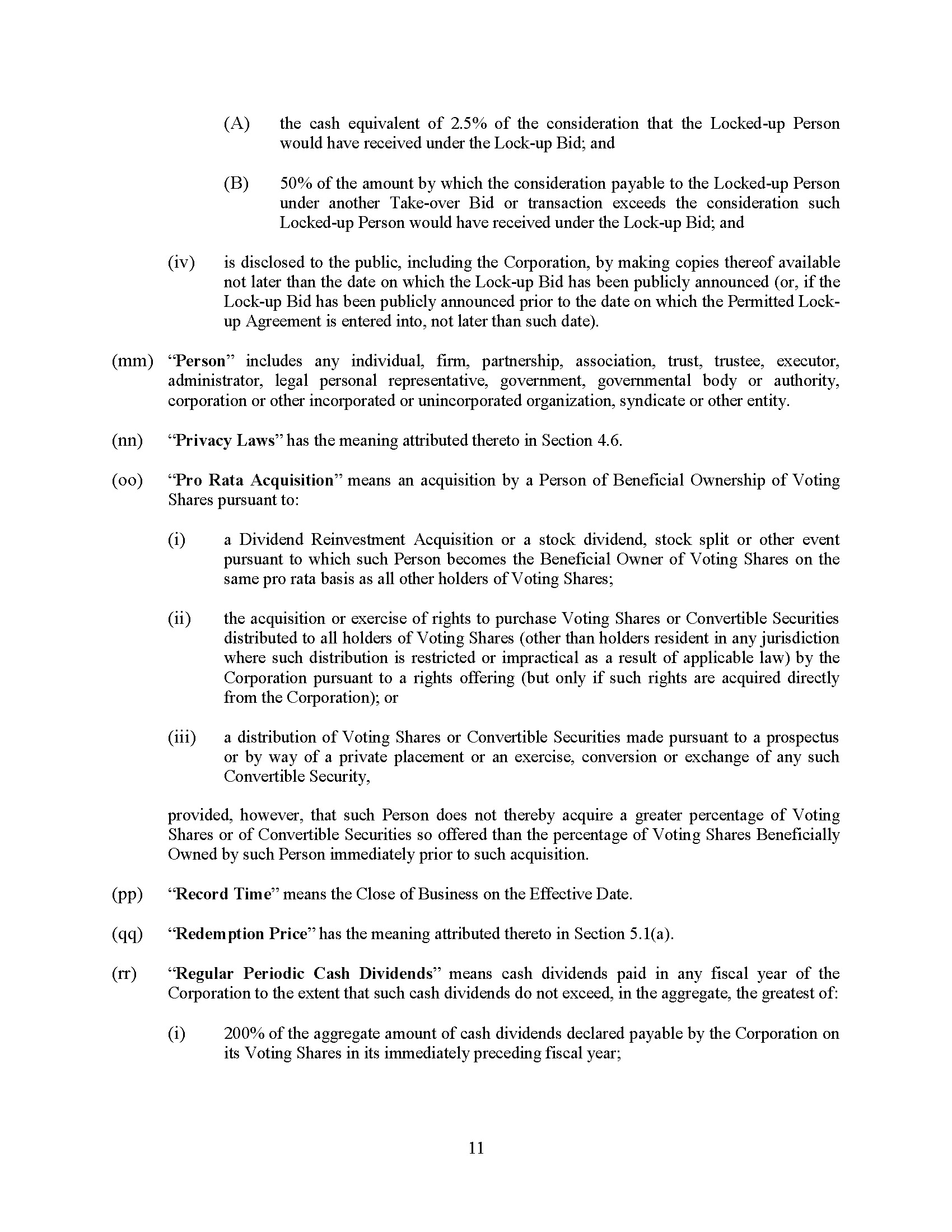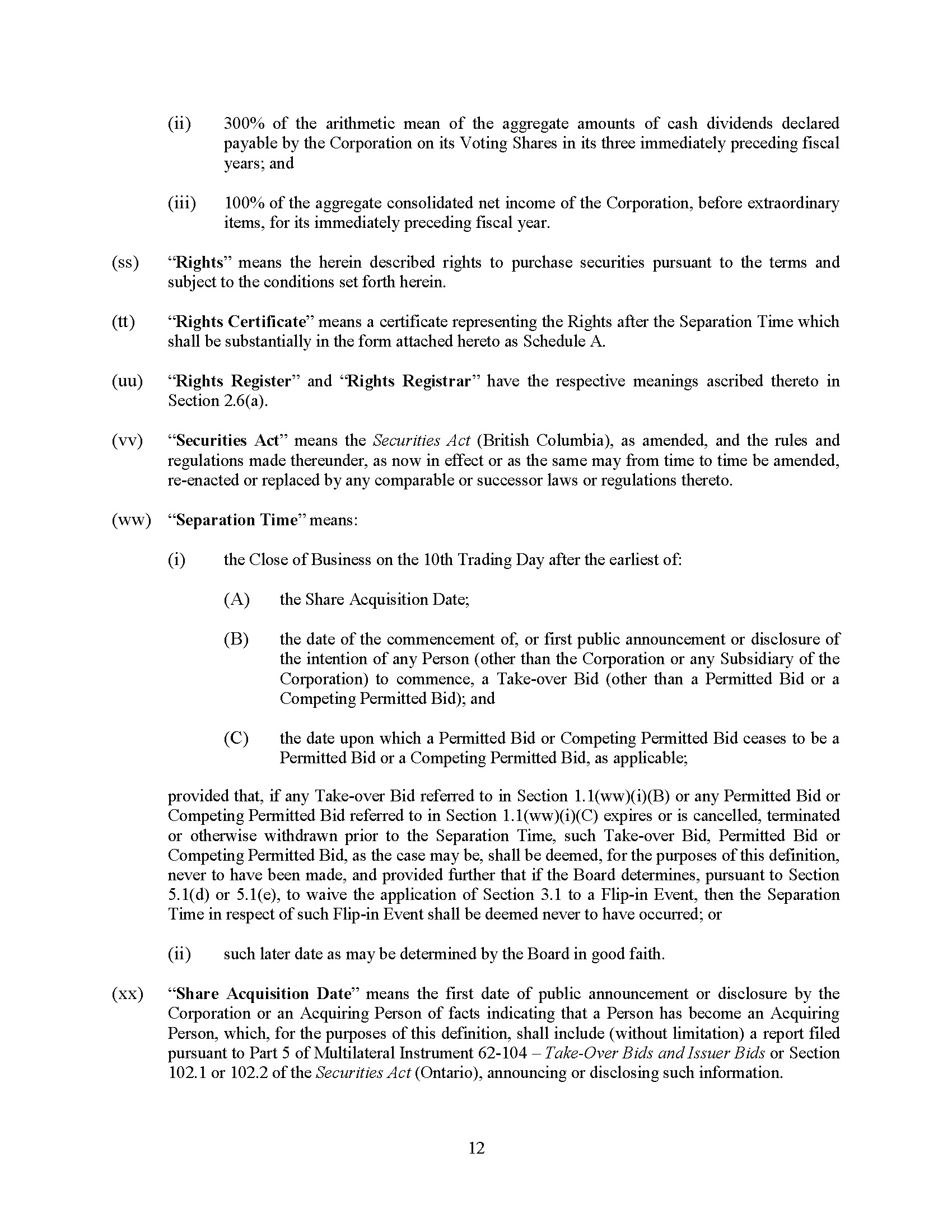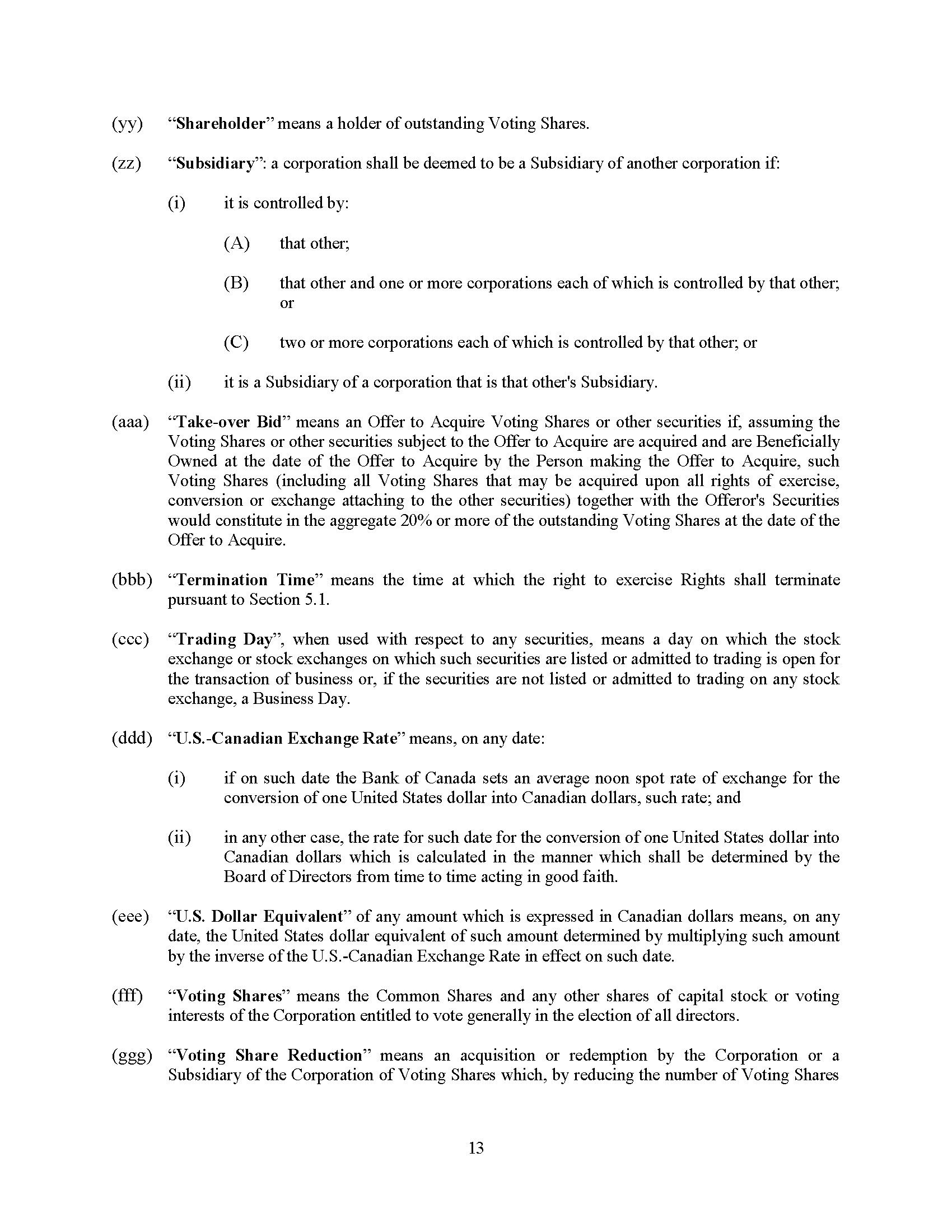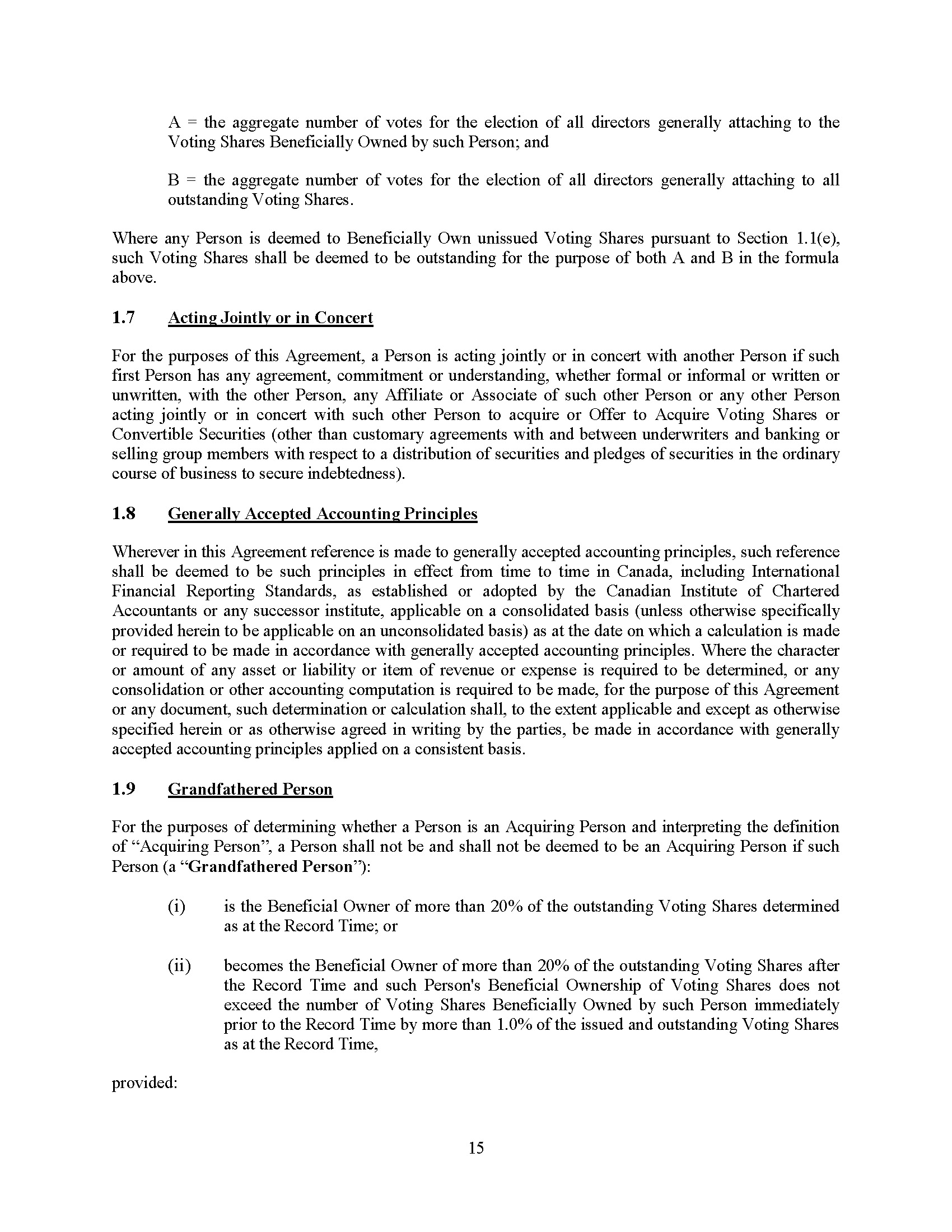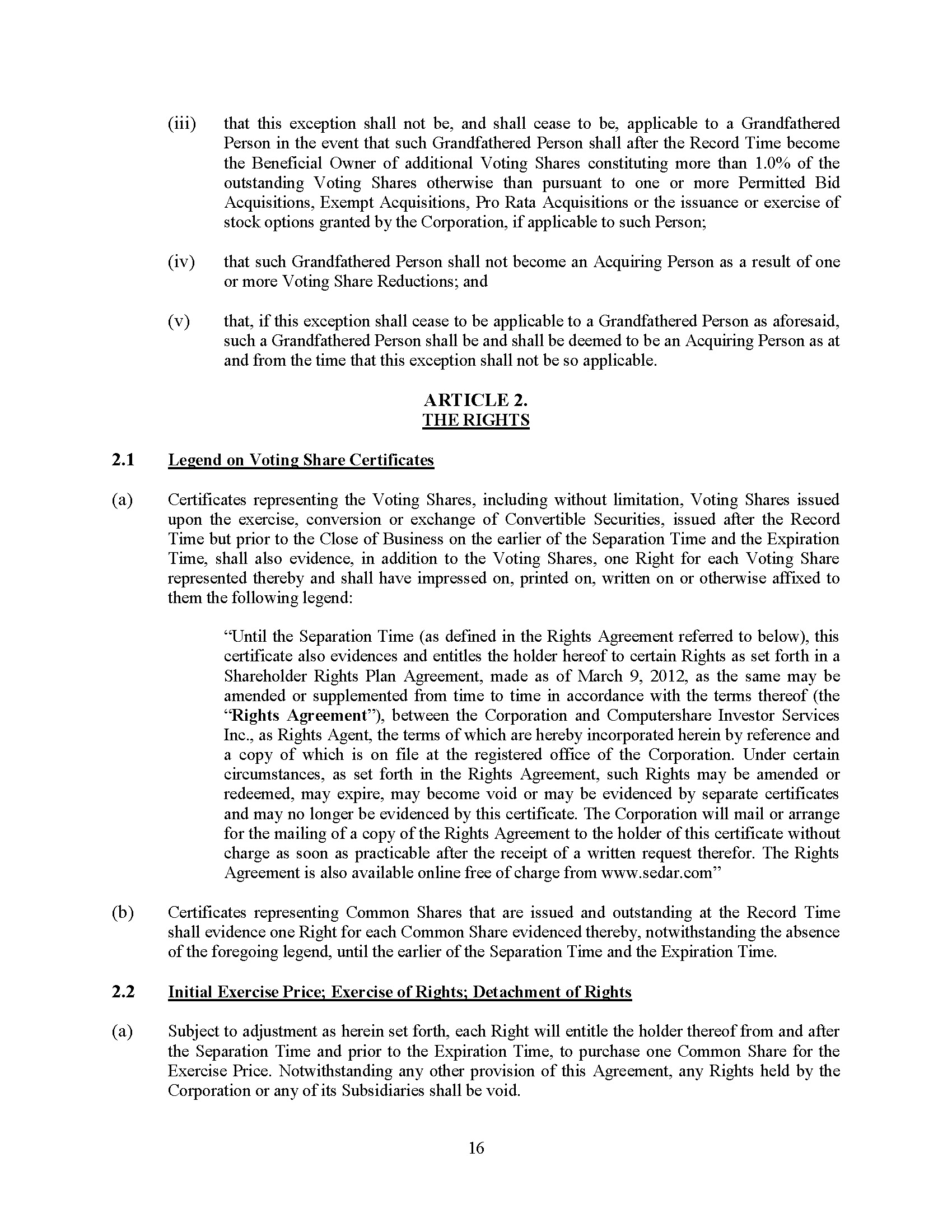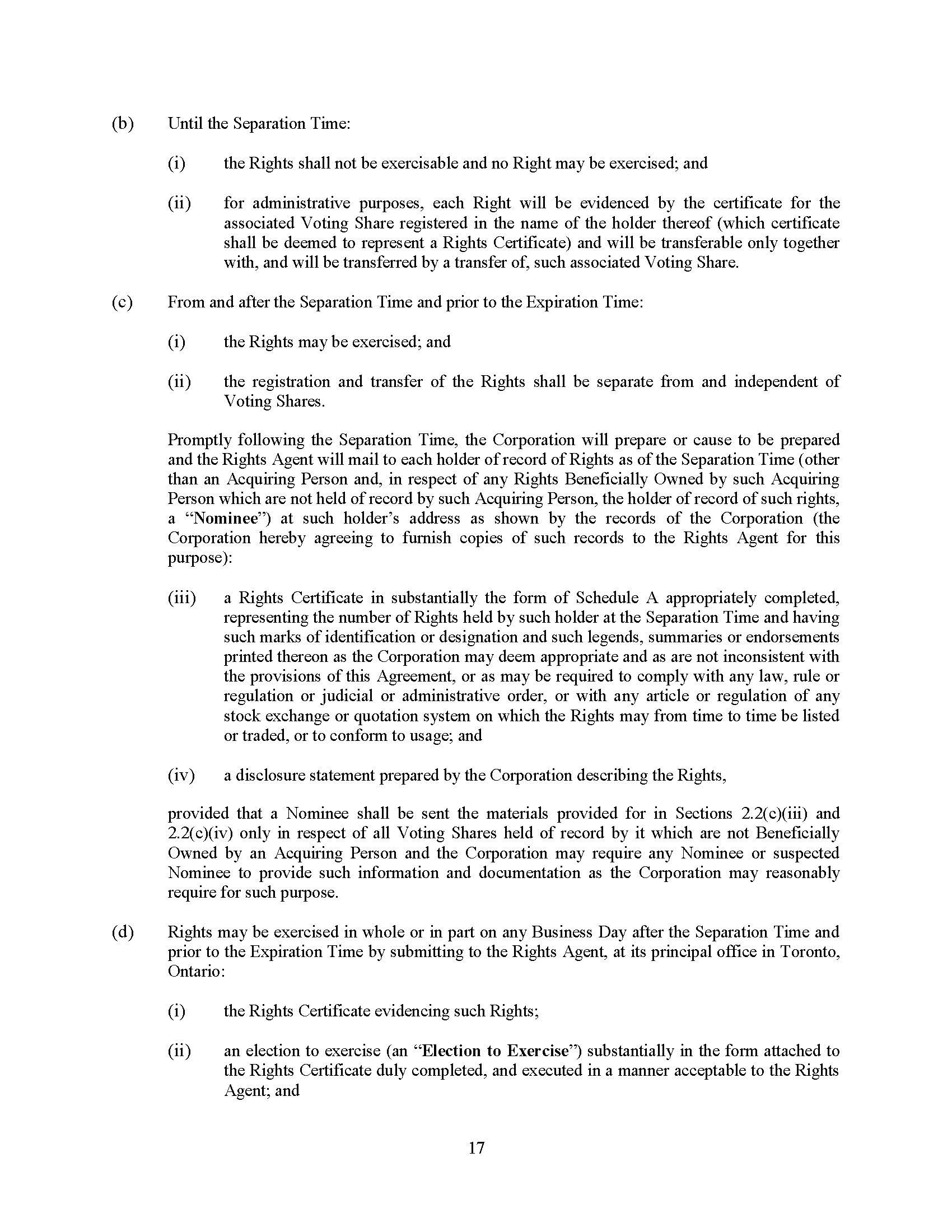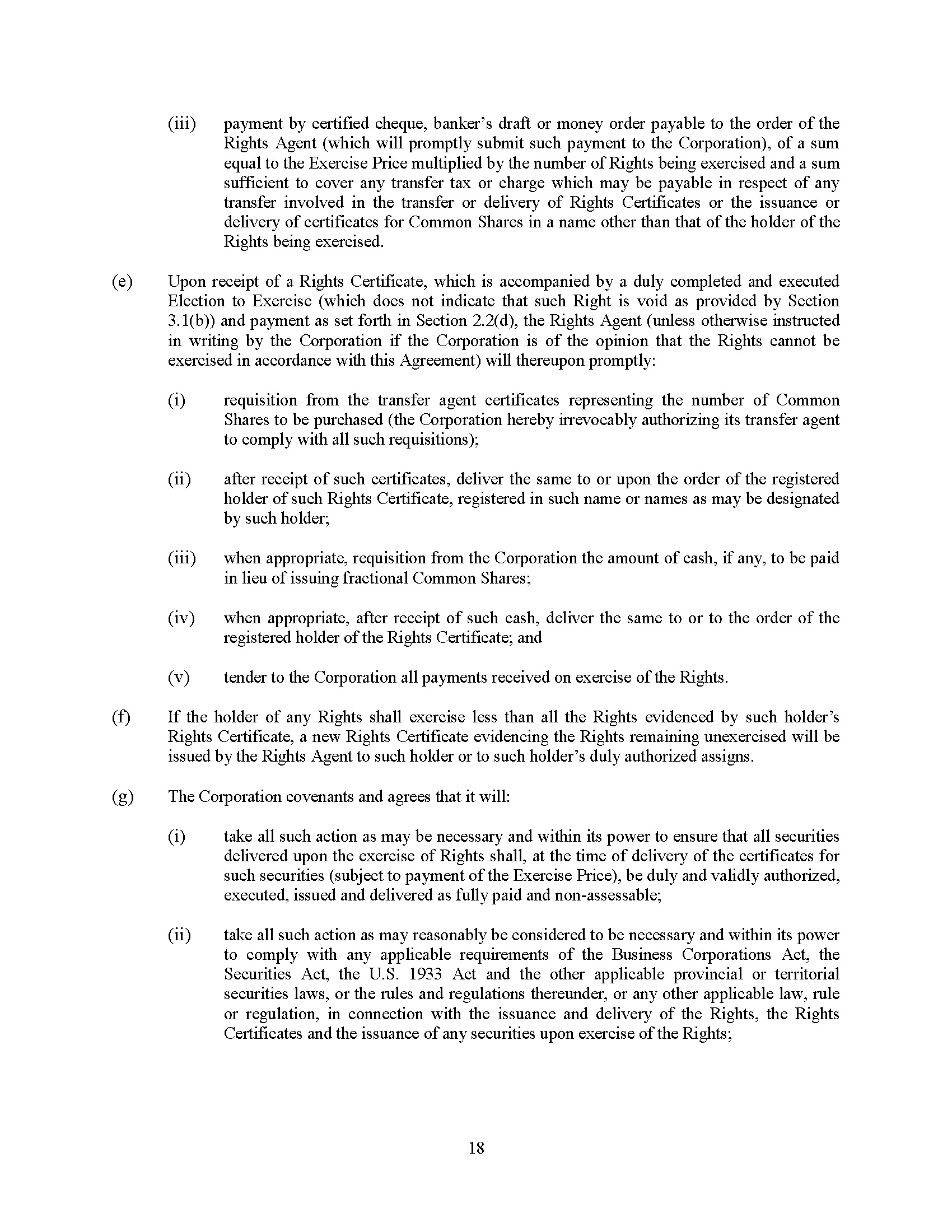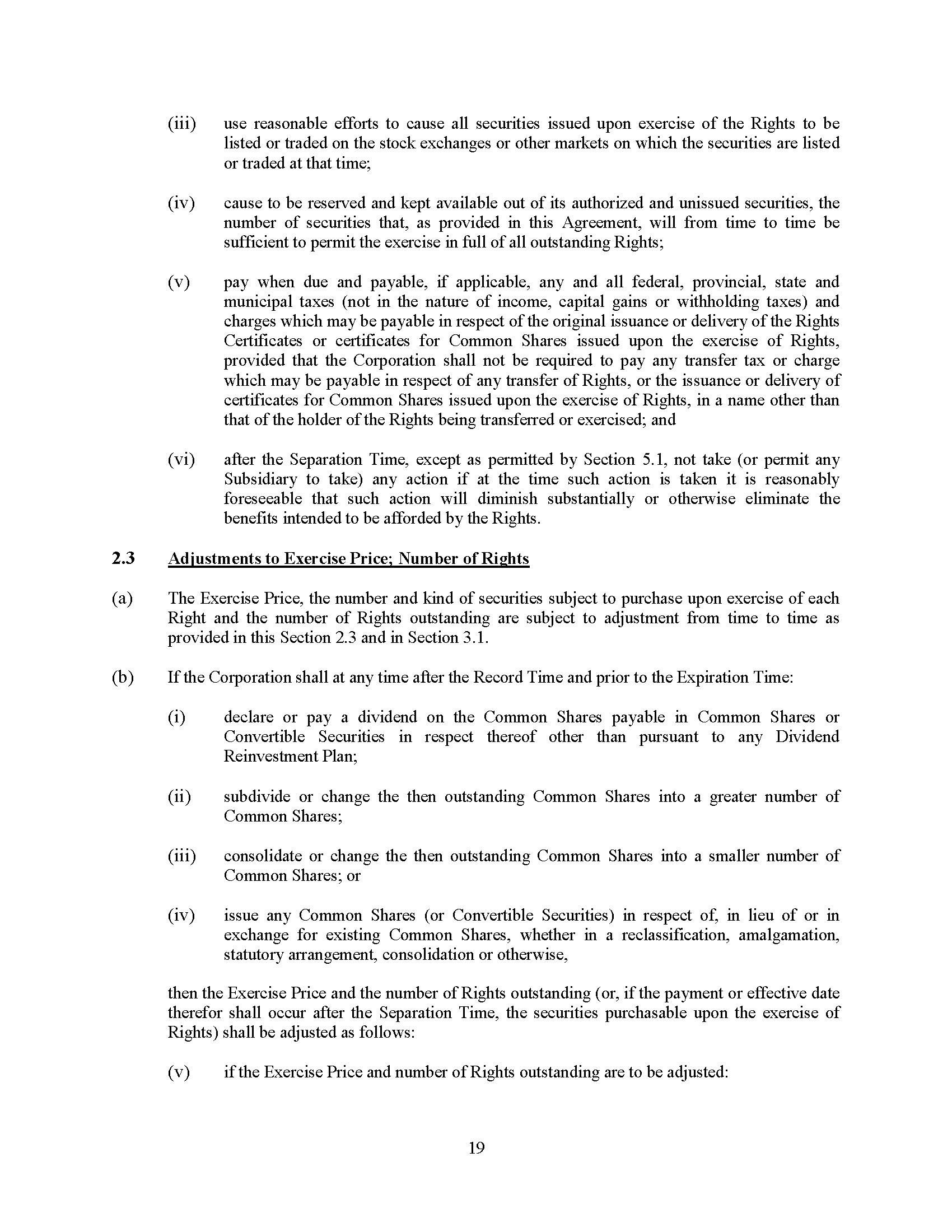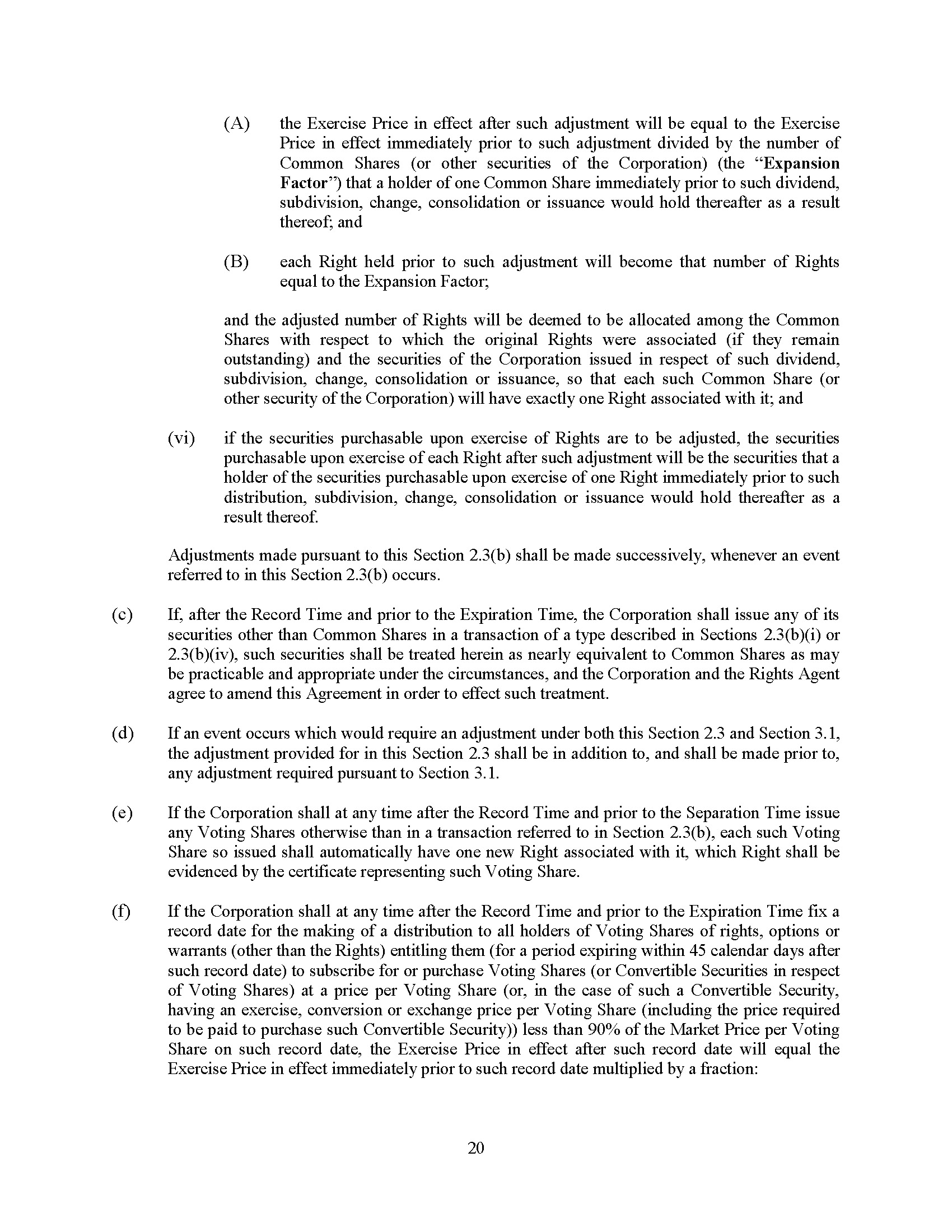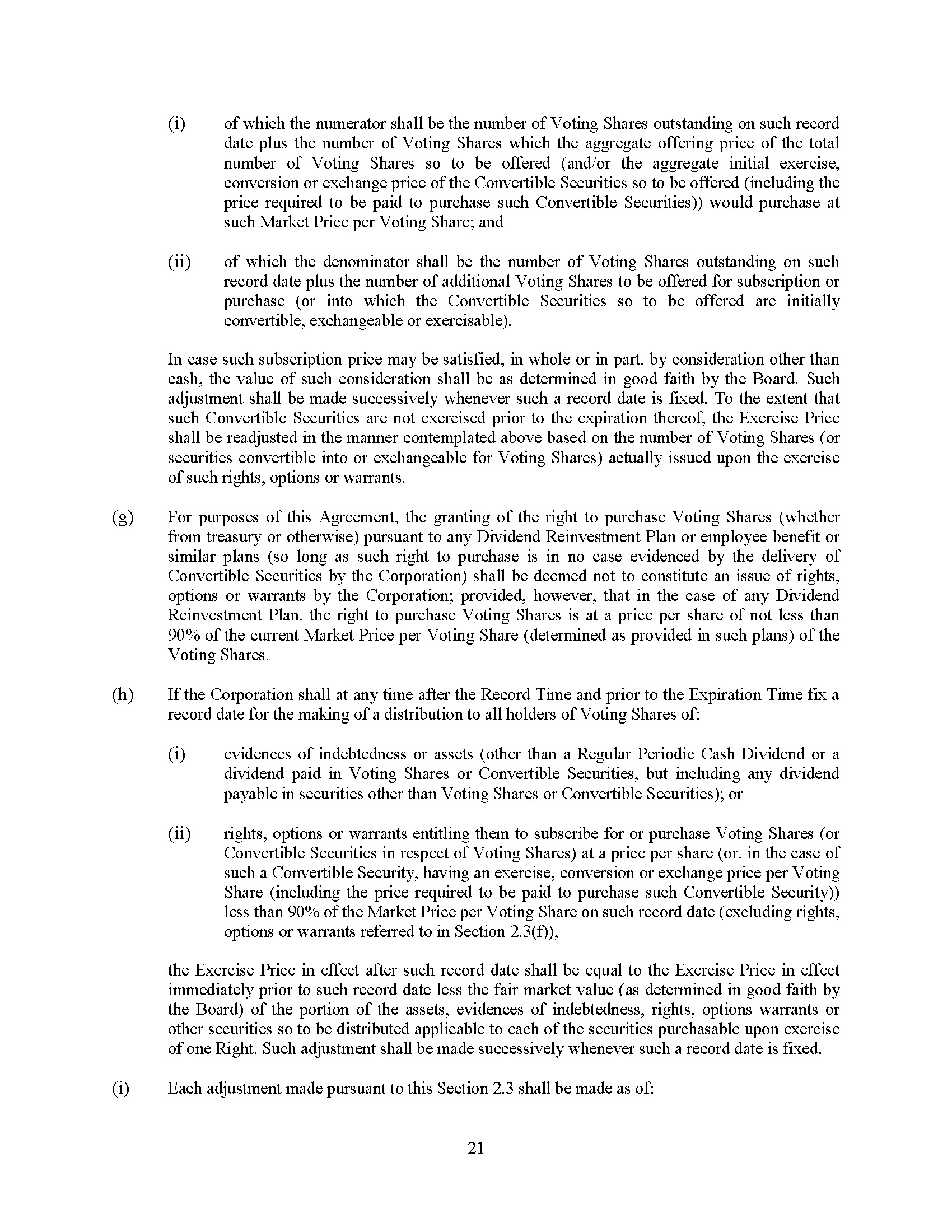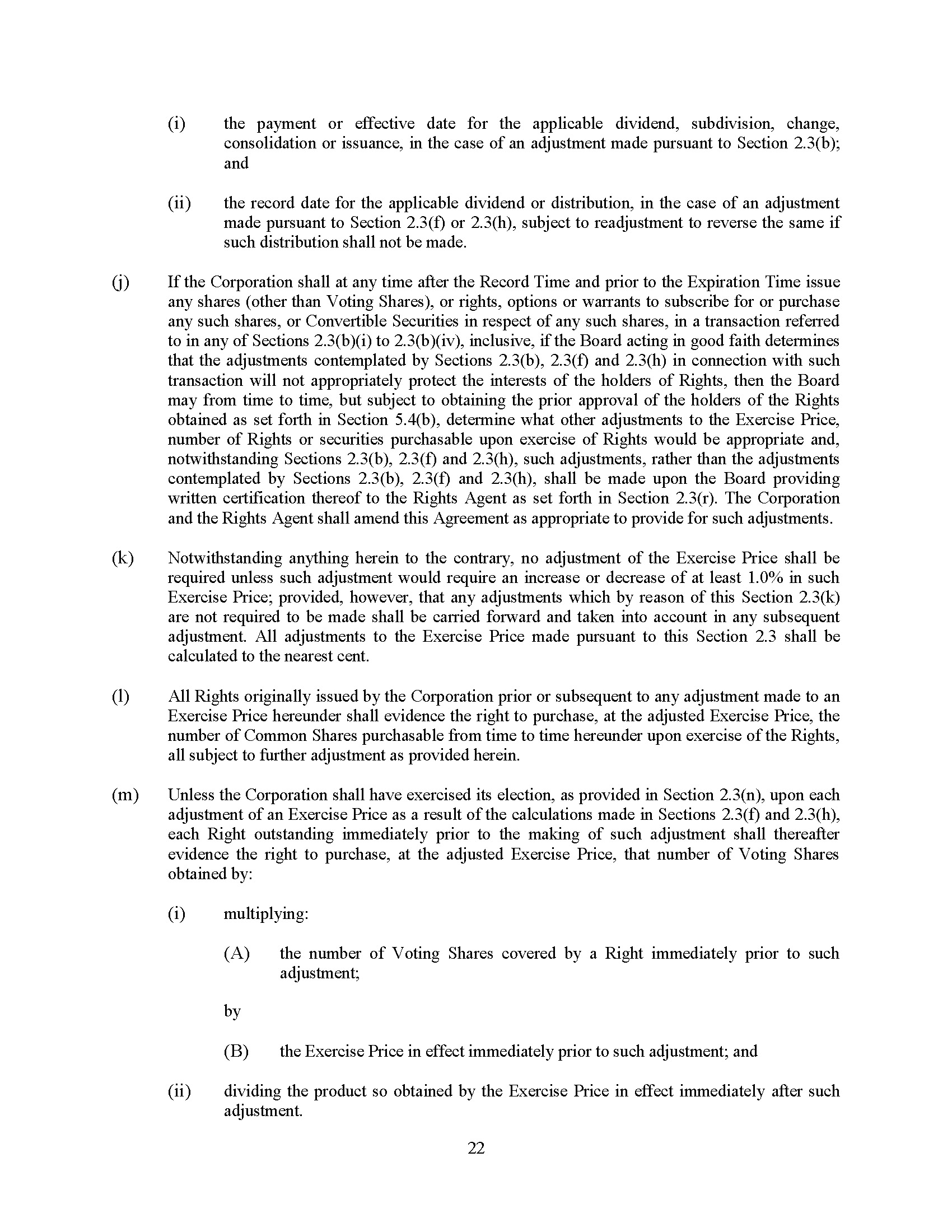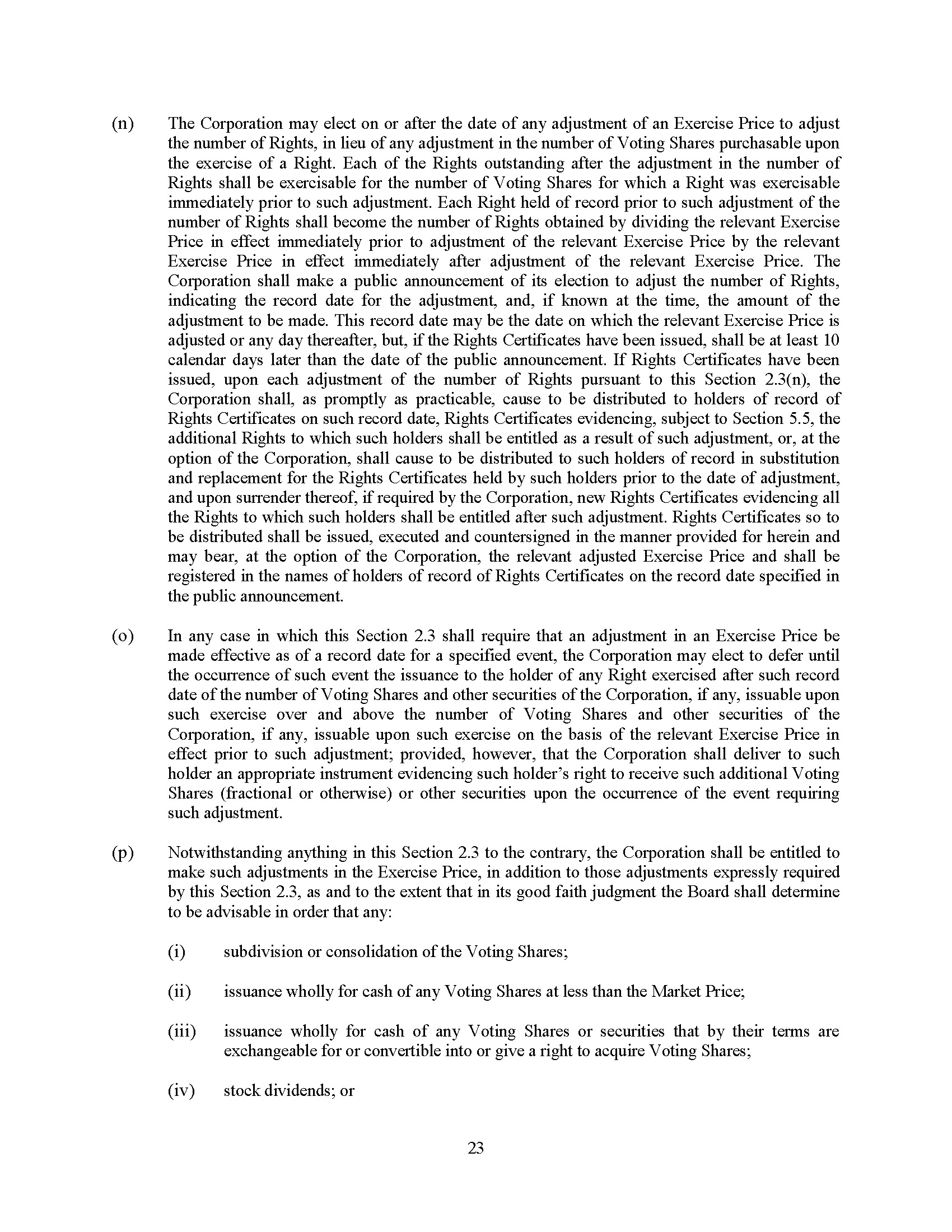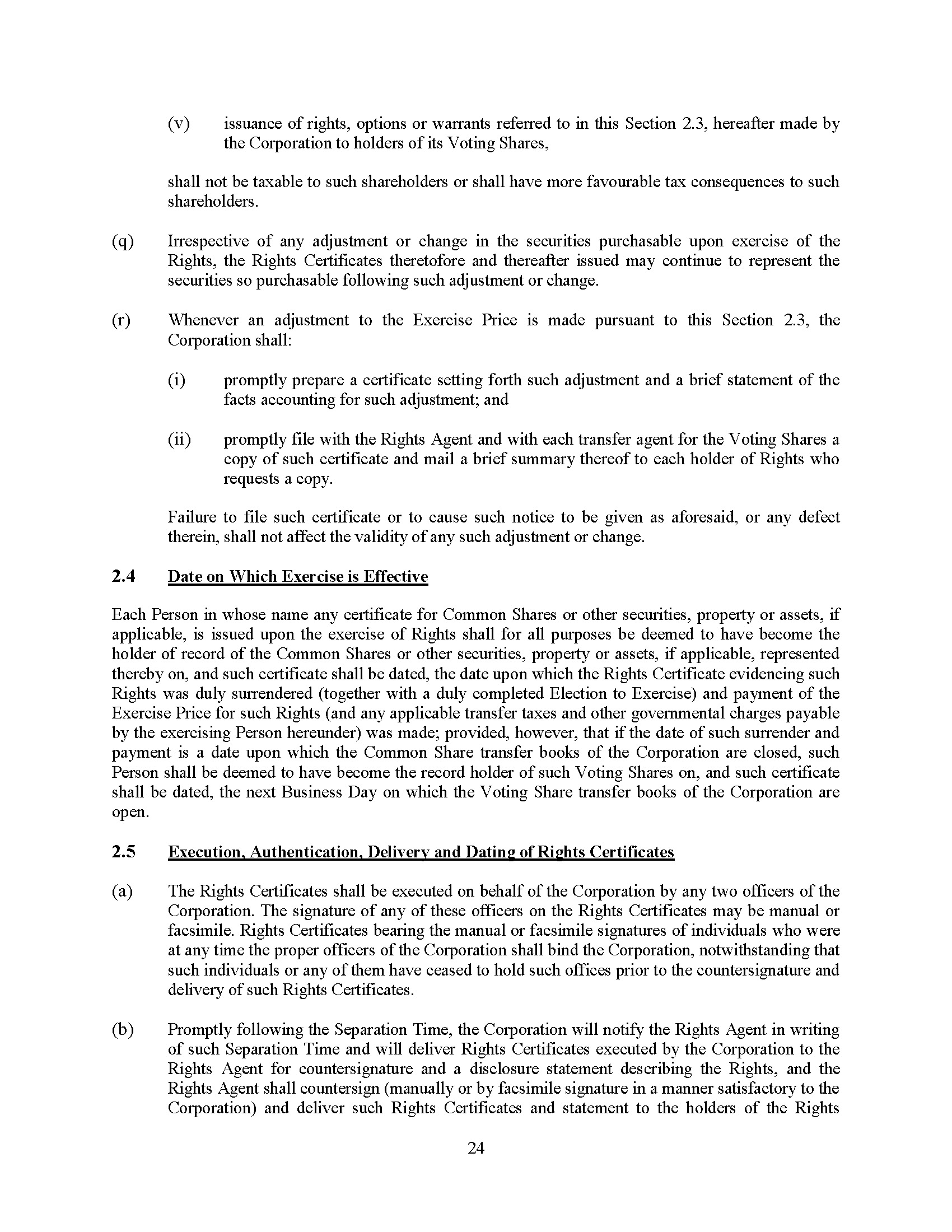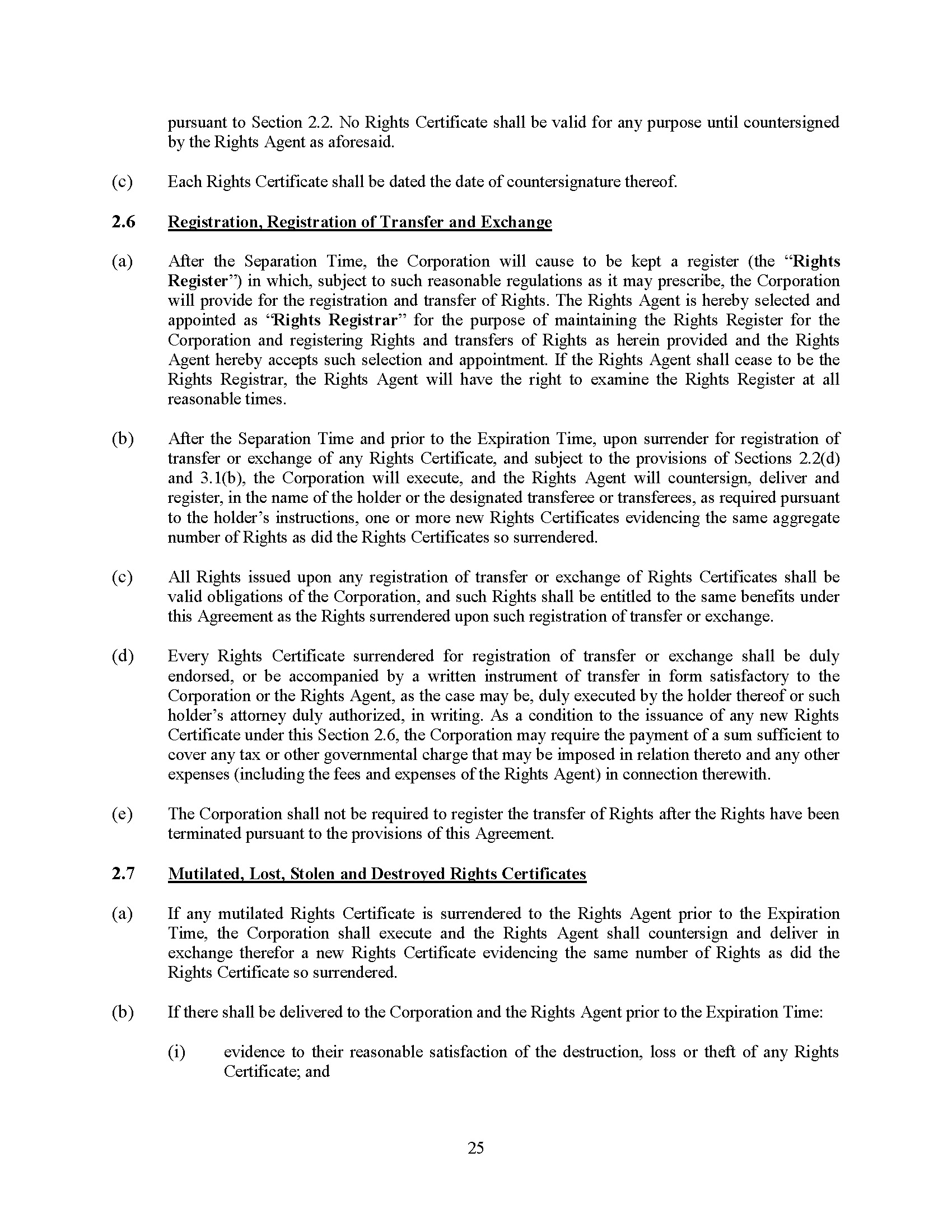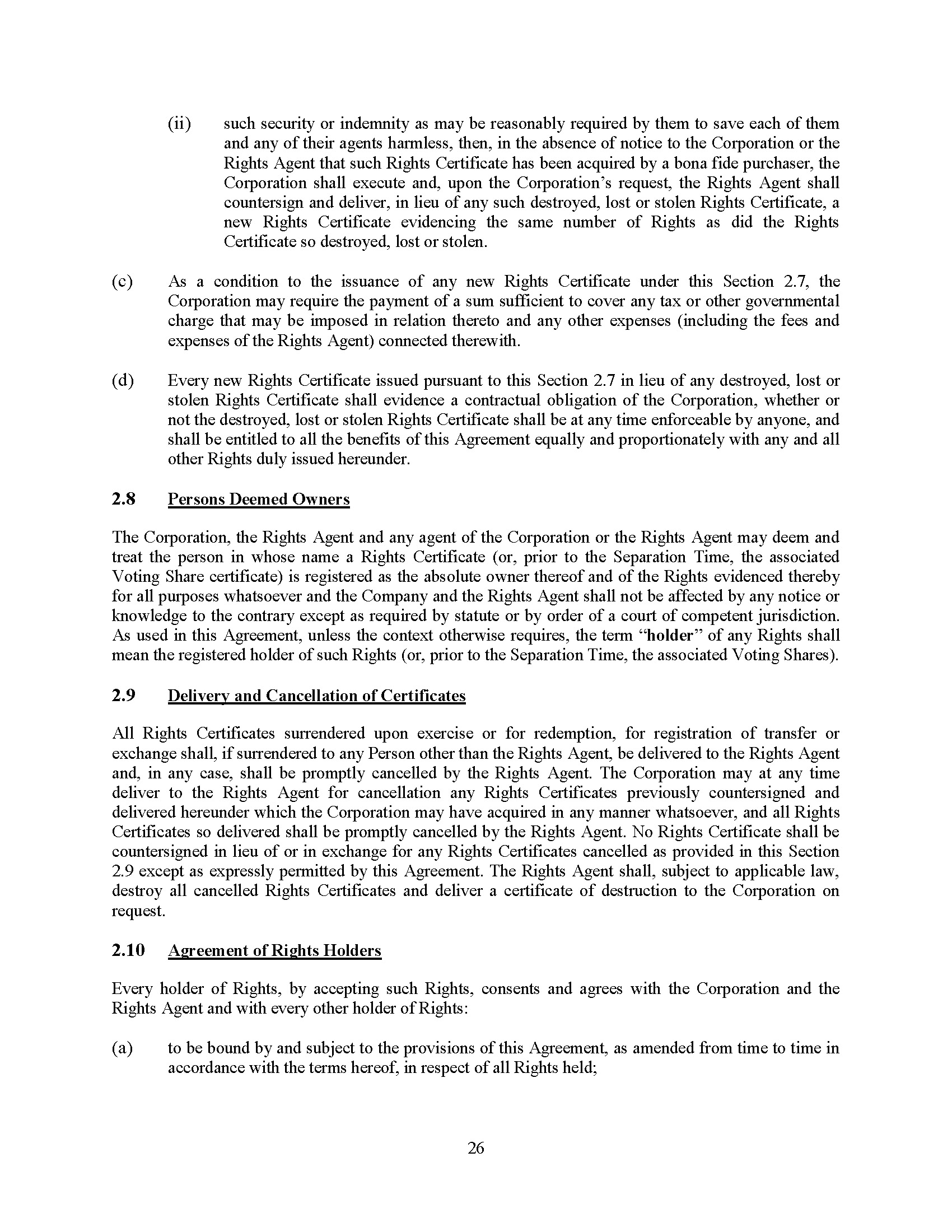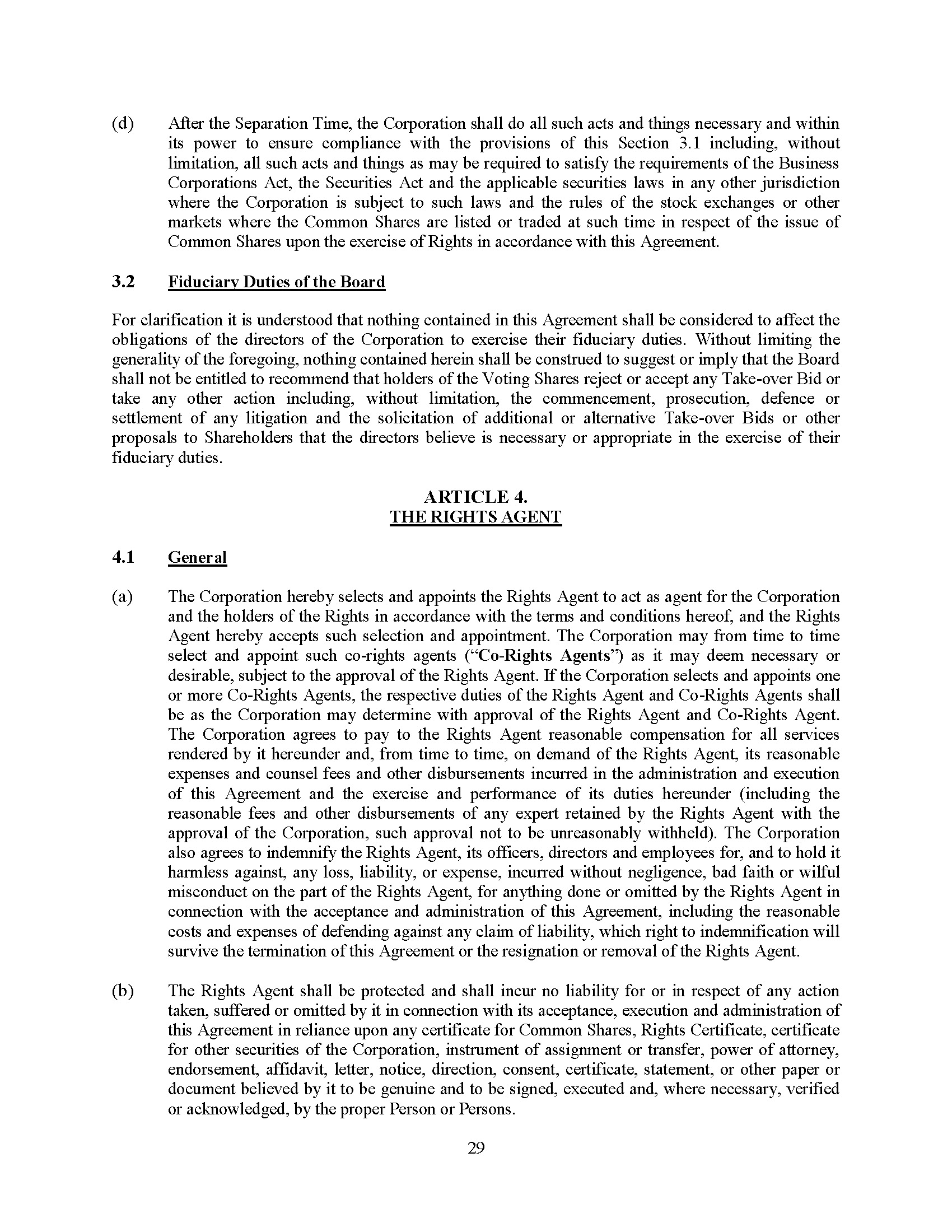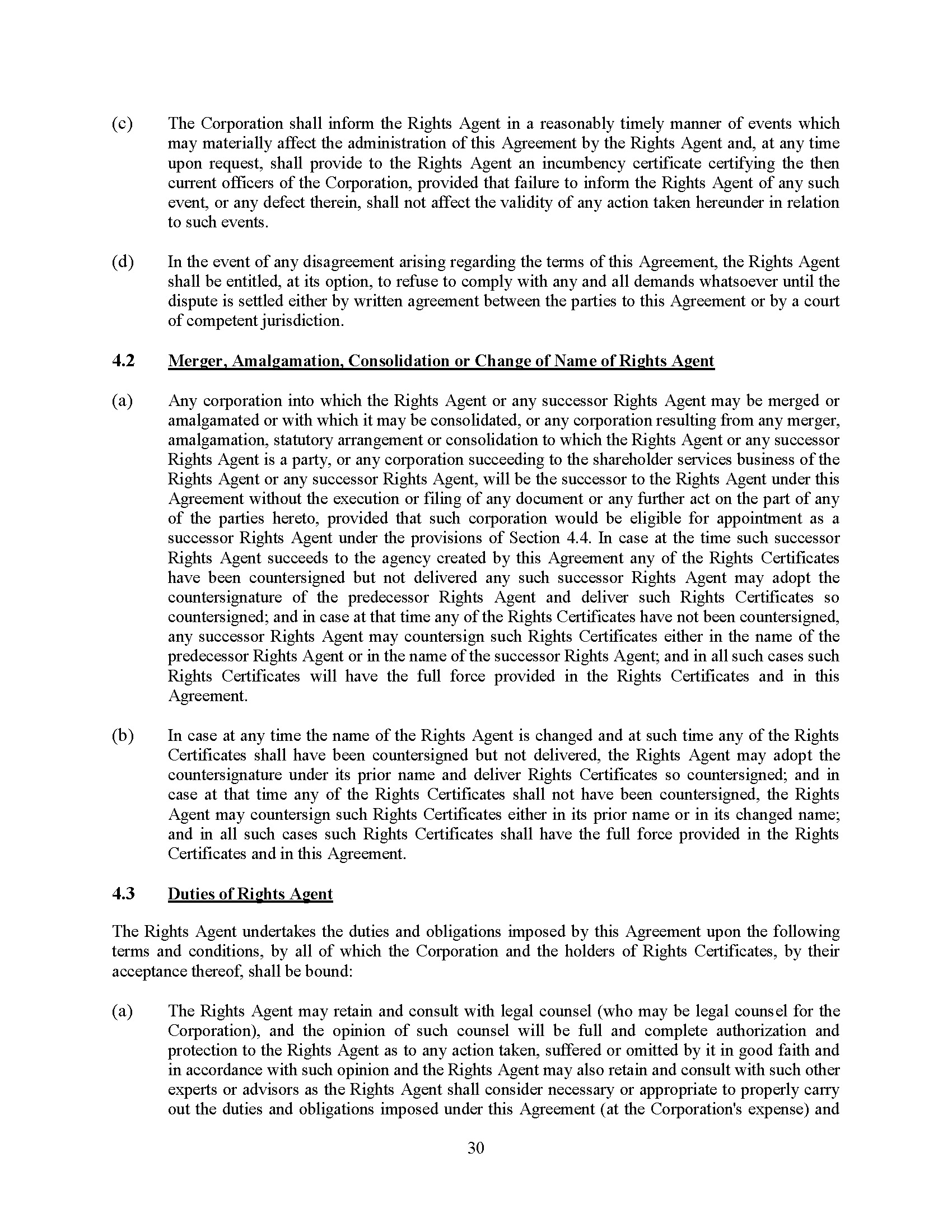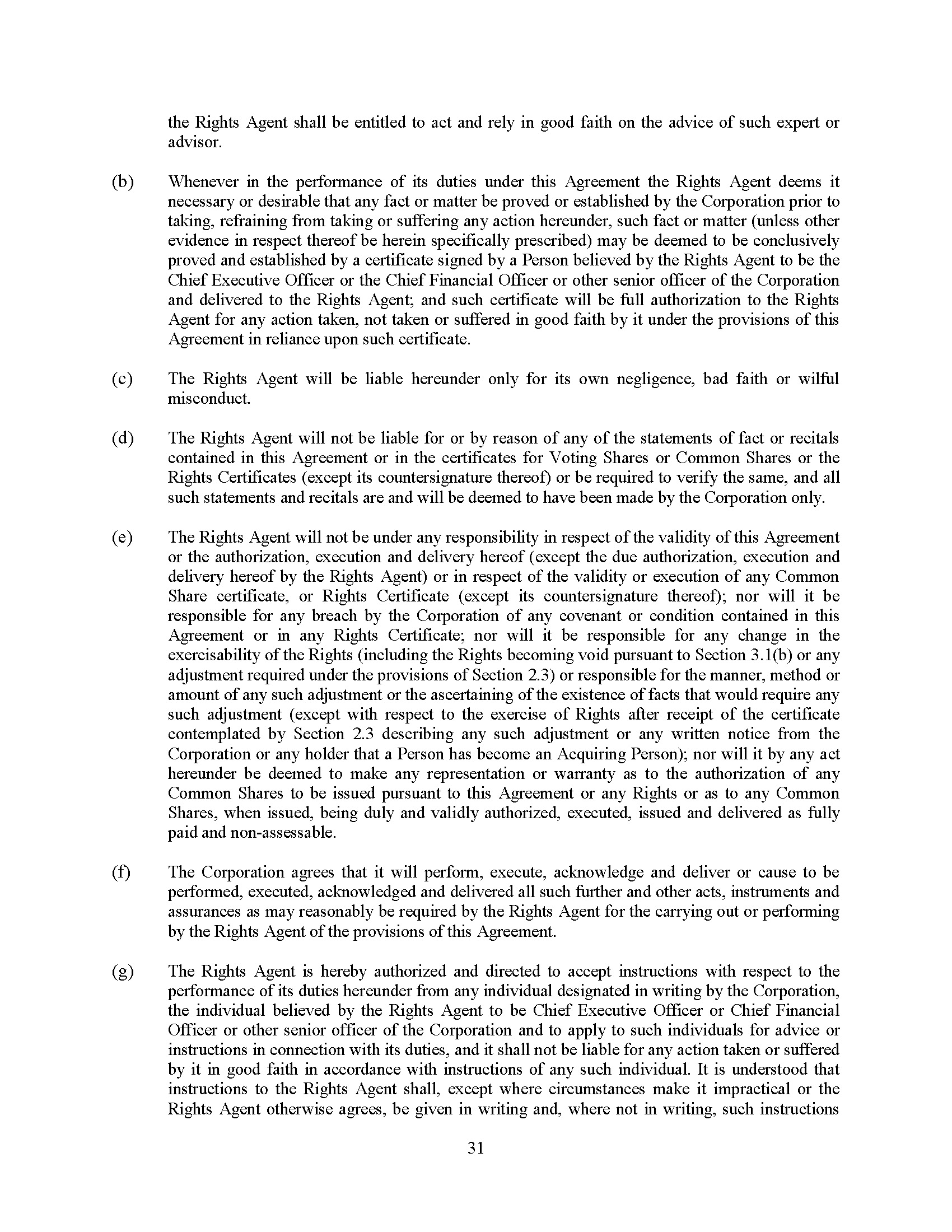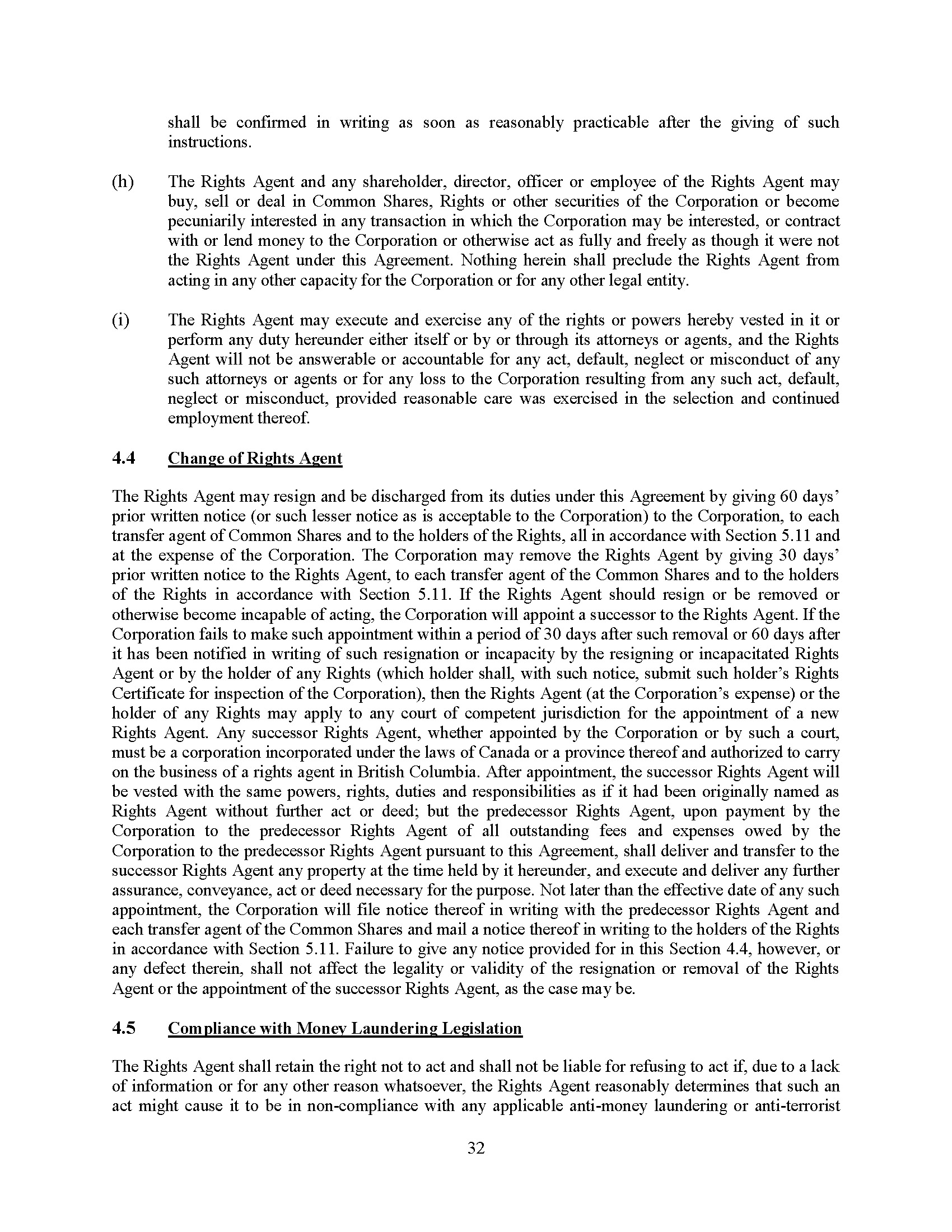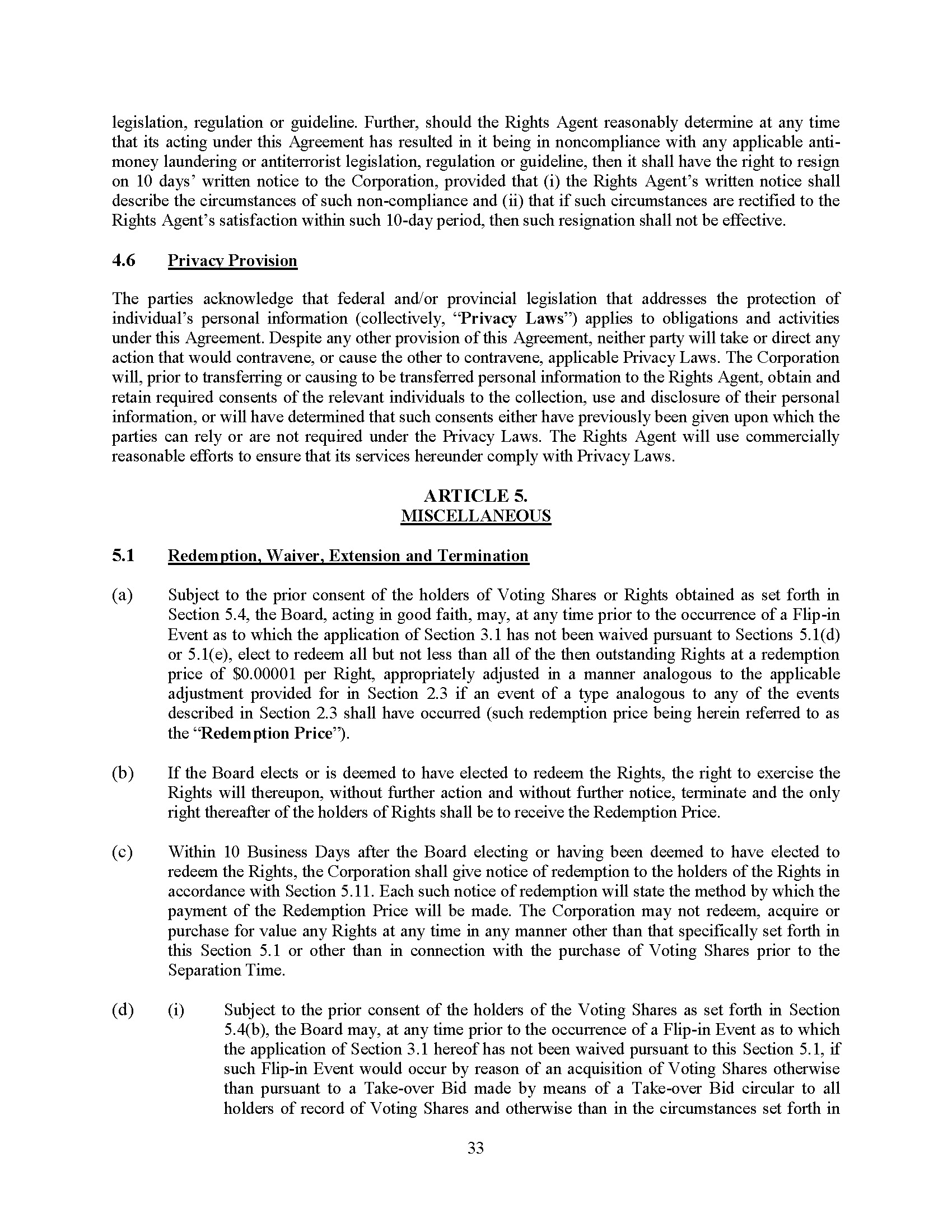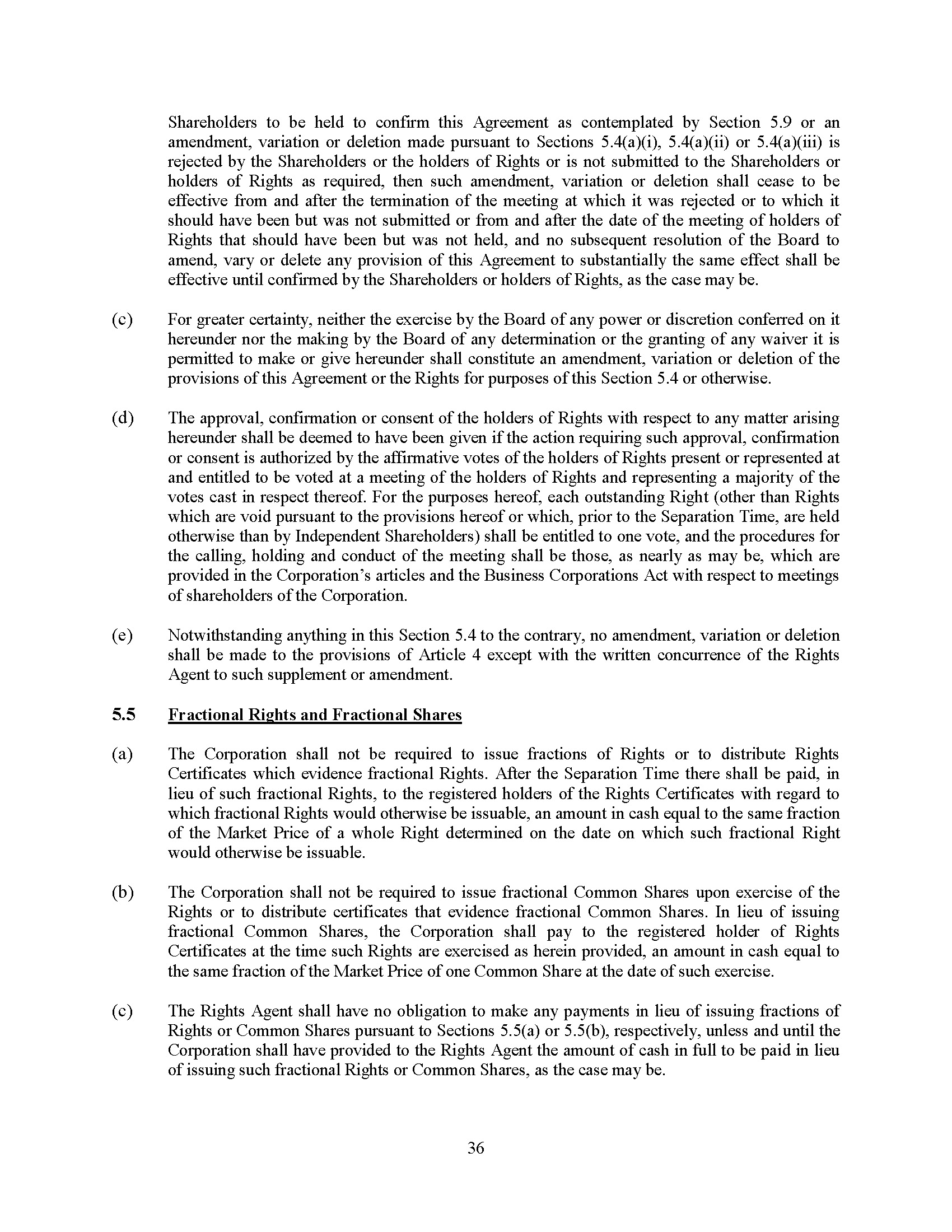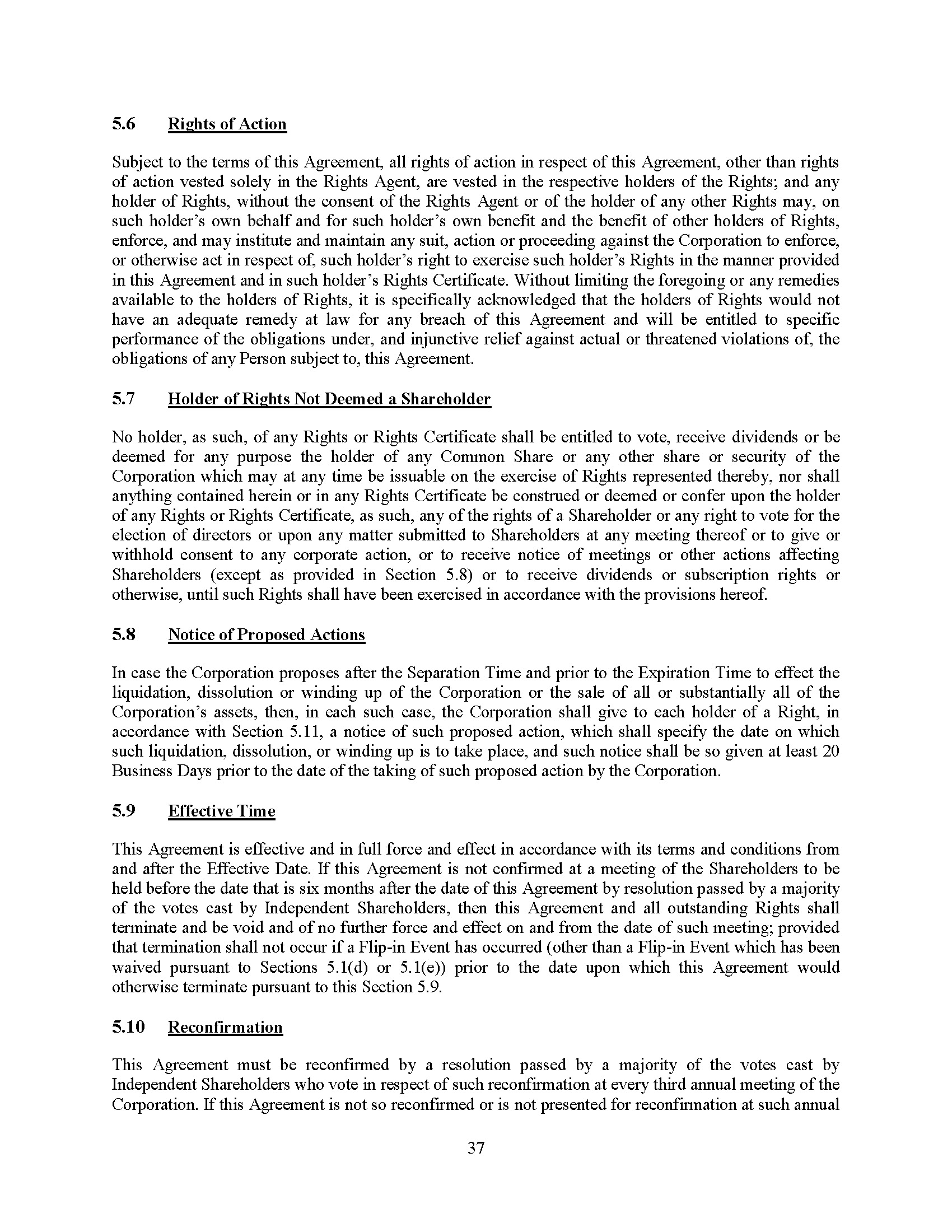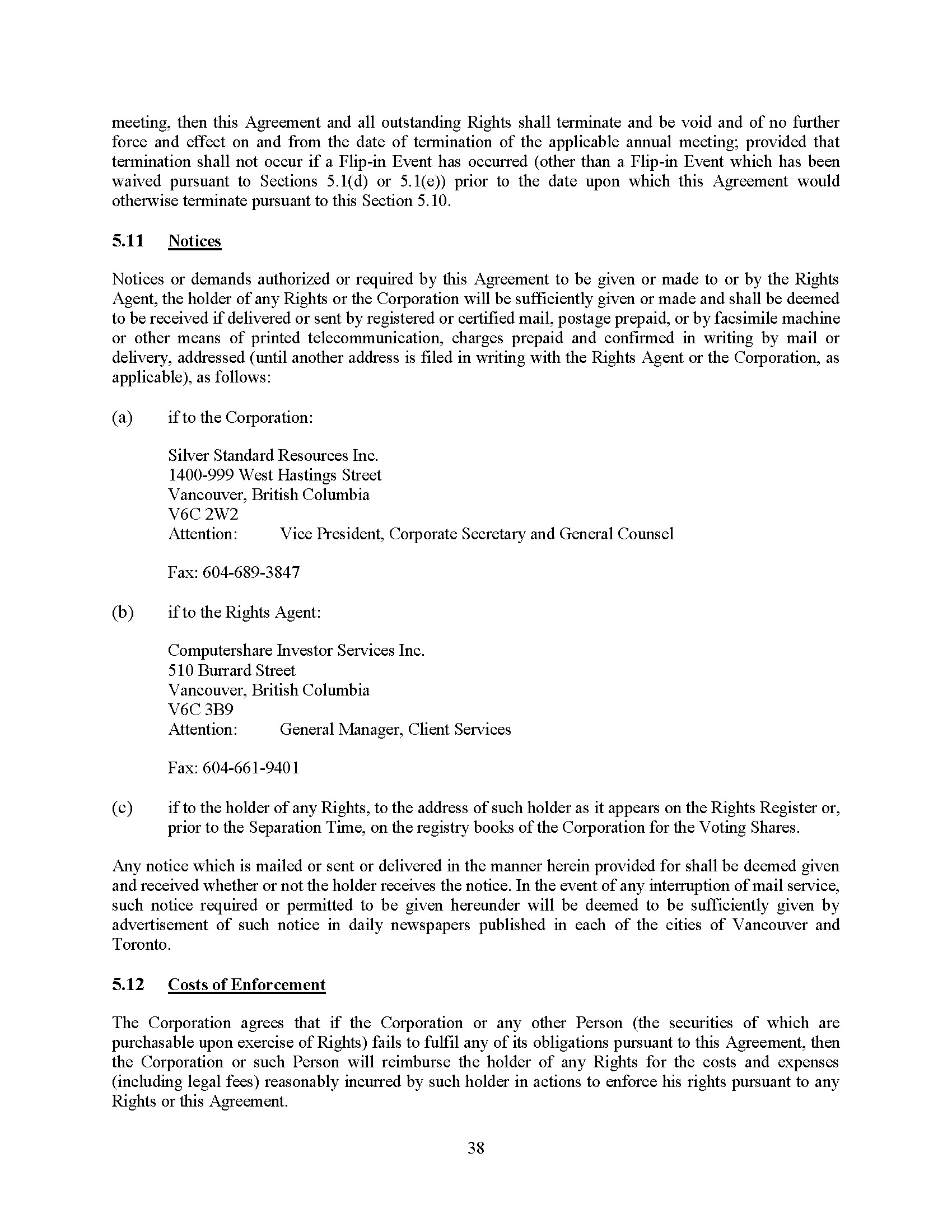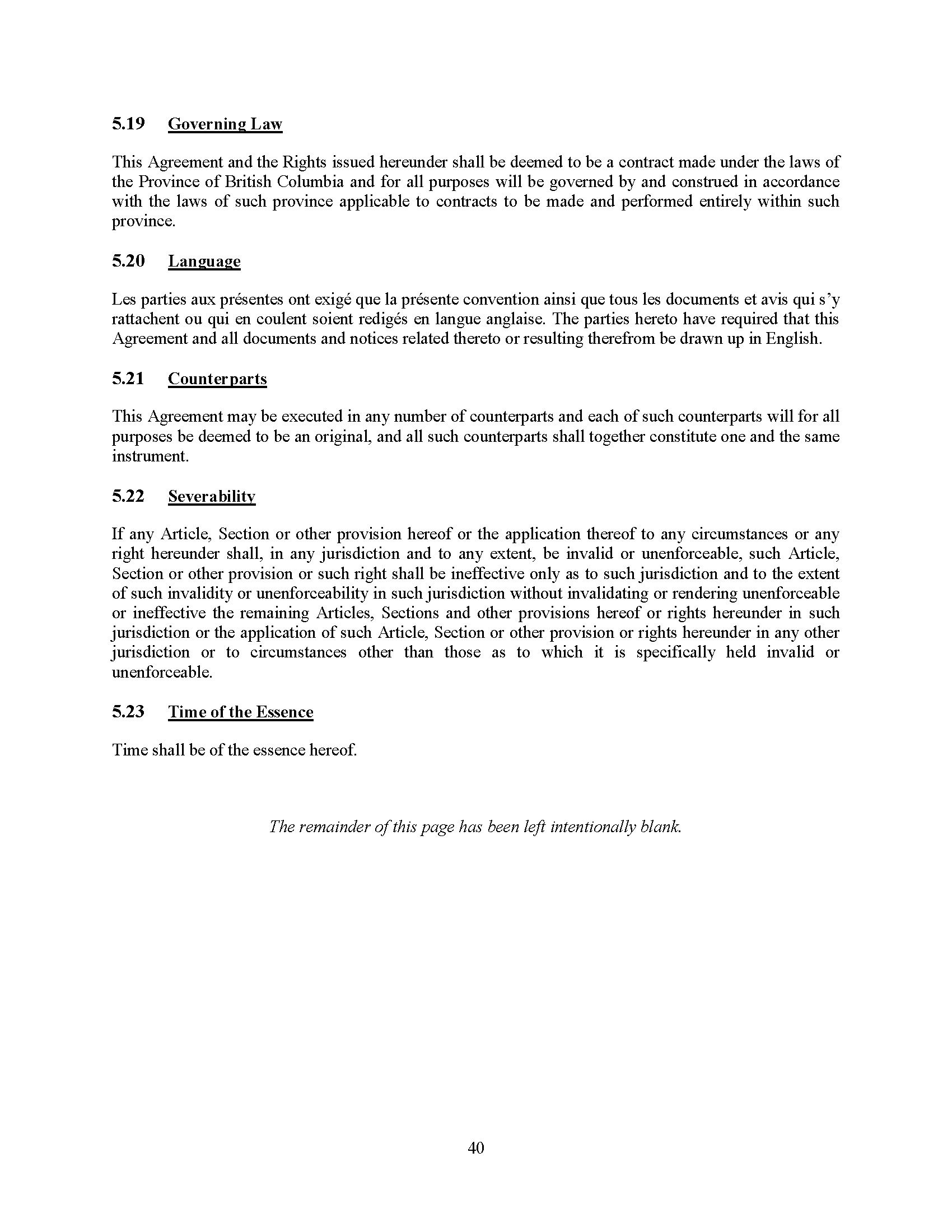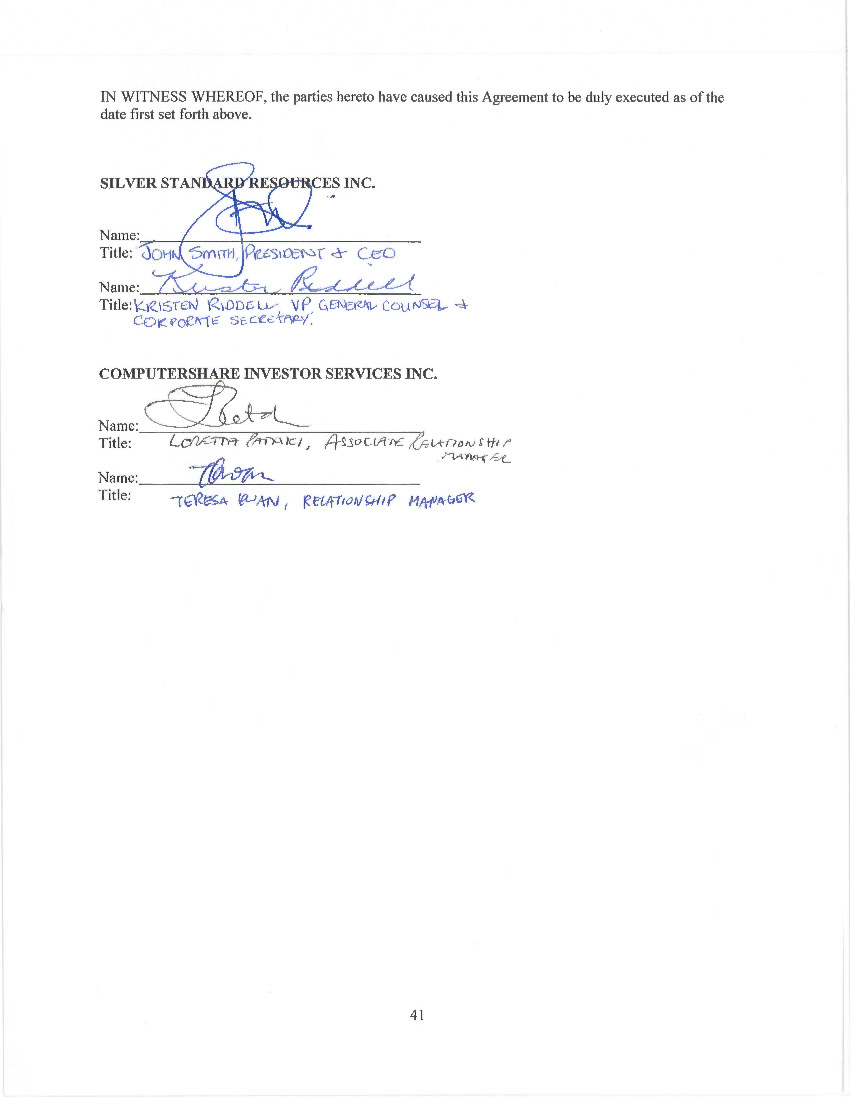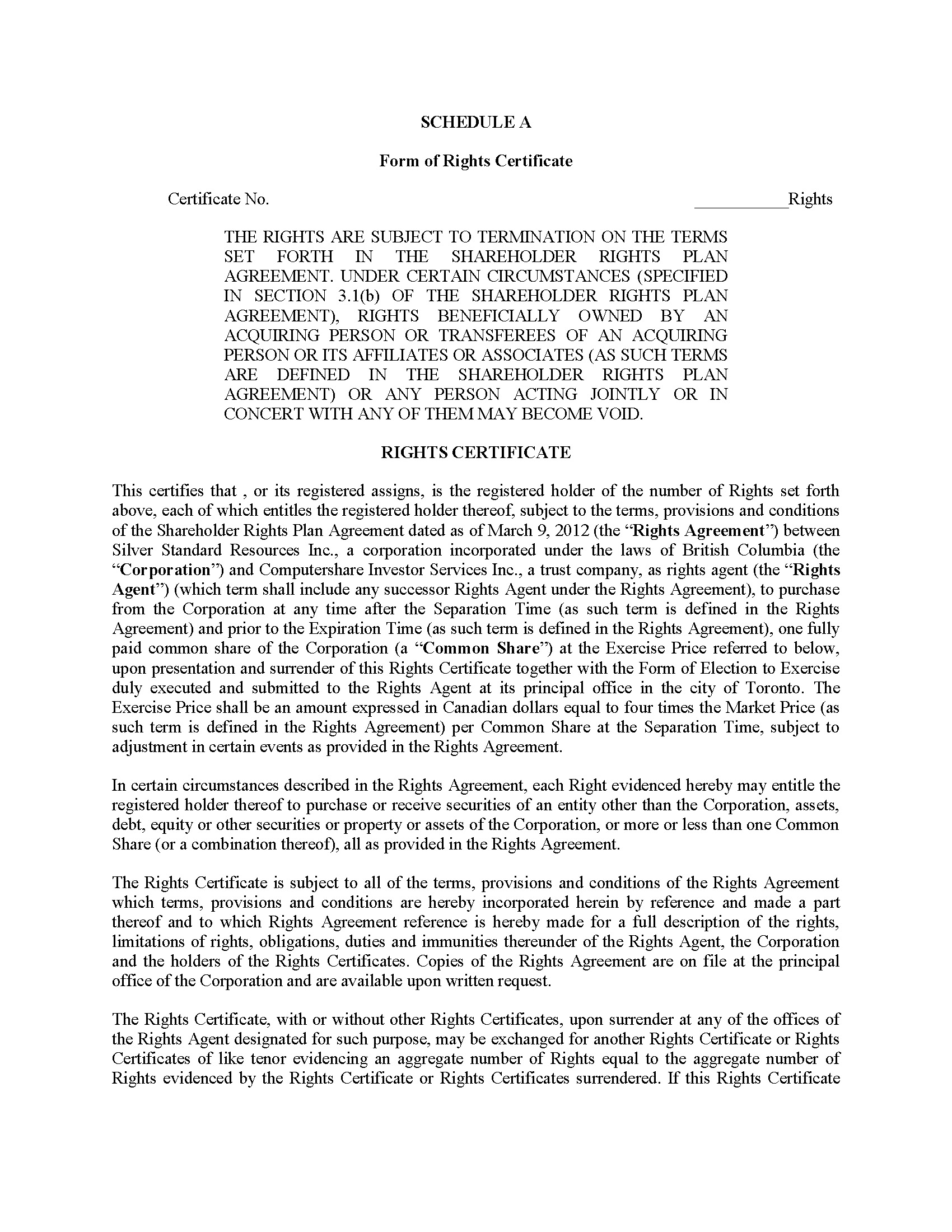2015 MANAGEMENT INFORMATION CIRCULAR
This management information circular (the “Circular”) has been prepared to provide information to shareholders of Silver Standard Resources Inc. (“Silver Standard” or the “Company”) as of the close of business on March 16, 2015, the “record date” for the 2015 annual and special meeting of shareholders to be held on Wednesday, May 13, 2015 (the “Meeting”).
The Board and management of Silver Standard encourage you to vote your shares at the Meeting. Proxies may be solicited by mail, telephone, email, facsimile or other electronic means as well as by newspaper or other media advertising. Proxies may also be solicited personally, by telephone, email or facsimile by regular employees of the Company, at nominal cost. The Company may also engage other agents, representatives or investment dealers to solicit proxies. The cost of solicitation of proxies will be paid by the Company.
All information in this Circular is as at March 16, 2015 unless otherwise noted. All dollar amounts in this Circular are expressed in United States dollars, and Canadian dollars are referred to as “C$”.
Receiving documents
Pursuant to applicable securities laws, we have chosen to provide our Notice of Meeting, management information circular, the proxy form/voting instruction form (collectively, the “Meeting Materials”), our financial statements and our management’s discussion and analysis for the year ended December 31, 2014 to shareholders using the notice-and-access provisions under National Instrument 54-101 – Communications with Beneficial Owners of Securities of a Reporting Issuer and under National Instrument 51-102 – Continuous Disclosure Obligations.
On or about March 31, 2015 will mail to Shareholders of record as of the close of business on March 16, 2015 a Notice (the “N&A card”) containing instructions on how to access our Meeting Materials, our financial statements and our management’s discussion and analysis for the year ended December 31, 2014 and how to vote. Shareholders who have requested printed copies of our comparative financial statements and management’s discussion and analysis for the year ended December 31, 2014 will continue to receive them by mail.
If you received the N&A card by mail, you will not receive a printed copy of the Meeting Materials, our financial statements or our management’s discussion and analysis for the year ended December 31, 2014 in the mail. Instead, the N&A card instructs you how to access and review all of the important information contained in those documents. The N&A card also instructs you on how you may submit your proxy over the Internet or by telephone. If you received the N&A card by mail and would like to receive a printed copy of the Meeting Materials, our financial statements or our management’s discussion and analysis for the year ended December 31, 2014, you should follow the instructions for requesting such materials included in the N&A card.
Copies of the Meeting Materials are also available on the Internet at www.sedar.com and at www.sec.gov/edgar.shtml and on our website at http://ir.silverstandard.com/index.cfm. You may request a paper copy of the Meeting Materials by contacting the Corporate Secretary at 604-484-8217 or toll free at 1-888-338-0046.
Registered and Beneficial Shareholders
The N&A card and the proxy form/voting instruction form are being sent to both registered and beneficial shareholders of Silver Standard.
As a shareholder, you may request printed copies of our annual and interim financial statements and management’s discussion and analysis by completing the enclosed card to send us your instructions.
Additional Information
Additional information relating to the Company is available on the SEDAR website at www.sedar.com.
You can find financial information relating to the Company in our consolidated financial statements, management’s discussion & analysis and Annual Information Form (or Form 40-F) for the most recently completed financial year. These documents are available on our website (www.silverstandard.com), on SEDAR (www.sedar.com), and on EDGAR (www.sec.gov/edgar.shtml). You can also request copies of these documents by contacting the Corporate Secretary at 604-484-8217 or toll free at 1-888-338-0046.
If you have any questions about the Meeting or the Meeting Materials, please call our Corporate Secretary at 604-484-8217 or toll free at 1-888-338-0046.
Our Board of Directors has approved the contents of this Circular and authorized us to send it to you.
ON BEHALF OF THE BOARD
“John Smith”
John Smith
President and Chief Executive Officer
March 24, 2015
ABOUT THE MEETING
Items of Business
We will cover the following items of business at the meeting:
| |
| 1. | Receive the audited financial statements of the Company for the year ended December 31, 2014 and the auditor’s report thereon; |
| |
| 2. | Set the number of directors at seven; |
| |
| 3. | Elect directors for the ensuing year; |
| |
| 4. | Appoint PricewaterhouseCoopers LLP, Chartered Accountants, as the Company’s auditor for the ensuing year and authorize the directors to set the auditor’s remuneration; |
| |
| 5. | Approve an ordinary resolution ratifying, confirming and approving the Company’s shareholder rights; and |
| |
| 6. | Approve the transaction of such other business as may properly come before the Meeting or any adjournment thereof. |
| |
| 1. | Receive our financial statements and the auditor’s report |
Our consolidated financial statements for the year ended December 31, 2014, and the auditor’s report, are available on our website (www.silverstandard.com), on SEDAR (www.sedar.com) and on EDGAR (www.sec.gov/edgar.shtml). A representative of PricewaterhouseCoopers LLP, the independent auditor for 2014, will be at the meeting to answer your questions.
| |
| 2. | Set the number of directors |
It is proposed to set the number of directors for the following year at seven.
The Board has nominated seven directors for election at the Meeting. The seven nominees are:
Peter Tomsett
Michael Anglin
Gustavo Herrero
Beverlee Park
Richard Paterson
Steven Reid
John Smith
Each of nominees is well-qualified to serve on the Board and has expressed willingness to do so. Directors will be elected for a one-year term, which will expire at the 2016 annual meeting.
| |
| 4. | Appoint the Company’s independent auditor and authorize the Board to set the auditor’s pay |
The Board, on the recommendation of the Audit Committee, is recommending that PricewaterhouseCoopers LLP (“PWC”) be reappointed as the independent auditor to serve until the 2016 annual meeting. PWC has been our auditor since 1998.
You will also be asked to authorize the Board to set the auditor’s pay for 2015.
| |
| 5. | Shareholder Rights Plan |
At the Company’s Annual General and Special Meeting held on May 9, 2012 shareholders approved a resolution confirming the shareholder rights plan adopted by the Board of Directors on March 9, 2012. The shareholder rights plan has successive three-year terms and will expire at the close of the Company’s 2015 annual meeting unless it is reconfirmed, ratified and approved by shareholders at such meeting. The Board has determined that the continuation of the shareholder rights plan is in the best interests of the Company and recommends that shareholders vote to reconfirm, ratify and approve the plan. See “Reconfirmation, Ratification and Approval of Shareholder Rights Plan” at page 17.
We will consider other matters that properly come before the meeting. As of the date of this Circular, we are not aware of any other items to be considered at the meeting.
Interest of Certain Persons
None of the following has a direct or indirect material interest, through beneficial ownership of securities or otherwise, in any item of business, other than electing the directors and approving the performance share unit and restricted share unit plans:
| |
| • | our directors or officers, or any person who has held a similar position since January 1, 2014; |
| |
| • | the nominees for director; or |
| |
| • | any of their associates or affiliates. |
Quorum and approval
We need a quorum of shareholders to transact business. A quorum is two persons who are, or who represent by proxy, shareholders who, in total, hold at least 33⅓% of the issued common shares entitled to vote at the Meeting.
We require a simple majority (50% plus 1) of the votes cast at the Meeting to approve all items of business, unless otherwise stated.
Shares outstanding and principal holders
Our authorized capital consists of an unlimited number of common shares without par value. We had a total of 80,754,434 common shares issued and outstanding at the close of business on March 16, 2015. We have no other classes of voting securities and we do not have any restricted securities.
Silver Standard is listed on two stock exchanges:
| |
| • | Toronto Stock Exchange (“TSX”) under the symbol SSO; and |
| |
| • | Nasdaq Global Market (“Nasdaq”) under the symbol SSRI. |
We are not aware of any shareholders who beneficially own, directly or indirectly, or exercise control or direction over, 10% or more of our outstanding common shares.
Interests of insiders in material transactions
We are not aware of any informed person or any nominee for director, or any associate or affiliate of the foregoing, who has a direct or indirect material interest in any transaction we entered into since January 1, 2014 or any proposed transaction, either of which will have a material effect on us or any of our subsidiaries.
An “informed person” means: (a) a director or executive officer of the Company; (b) a director or executive officer of a person or company that is itself an informed person or subsidiary of the Company; (c) any person or company who beneficially owns, directly or indirectly, voting securities of the Company or who exercises control or direction, directly or indirectly, over voting securities of the Company or a combination of both carrying more than 10% of the voting rights other than voting securities held by the person or company as underwriter in the course of a distribution; and (d) the Company itself, if it has purchased, redeemed or otherwise acquired any of its shares and for so long as it holds any of its shares.
VOTING
Who can vote
You are entitled to receive notice of and vote at the 2015 annual meeting to be held on May 13, 2015 if you held Silver Standard common shares as of the close of business on March 16, 2015, the record date.
Each common share that you own entitles you to one vote on each item of business at the Meeting.
How to vote
You can vote by proxy or you can attend the meeting and vote your shares in person. There are different ways to submit your voting instructions, depending on whether you are a registered or non-registered shareholder.
Voting at the meeting will be by a show of hands unless a poll is required or requested. Only registered shareholders or proxy holders are allowed to make motions or vote at the meeting.
Registered Shareholders
You are a registered shareholder if you have a share certificate registered in your name.
Peter Tomsett, Chair of the Board of Directors, or failing him, John Smith, President and Chief Executive Officer, have agreed to act as the Silver Standard proxy holders. You can appoint someone other than the Silver Standard proxy holders to attend the meeting and vote on your behalf. If you want to appoint someone else as your proxy holder, do not check their names on the enclosed proxy form. Print the name of the person you want in the space provided. This person does not need to be a shareholder.
On any ballot, your proxy holder must vote your shares or withhold your vote according to your instructions and if you specify a choice on a matter, your common shares will be voted accordingly. If there are other items of business that come before the Meeting, or amendments or variations to the items of business, your proxy holder will have the discretion to vote as he or she see fit.
If you appoint the Silver Standard proxy holders but do not tell them how to vote your shares, your shares will be voted:
| |
| • | For the nominated directors listed on the proxy form and in this Circular; |
| |
| • | For re-appointing PWC as the independent auditor and authorizing the Board to fix the auditor’s remuneration; |
| |
| • | For the ratification, confirmation and approval of the Company’s shareholder rights plan; and |
| |
| • | For the approval of the Company’s amended and restated performance share unit and restricted share unit plans. |
This is consistent with the voting recommendations by the Board and management. If there are other items of business that properly come before the Meeting, or amendments or variations to the items of business, the Silver Standard proxy holders will vote according to management’s recommendation.
If you appoint someone other than the Silver Standard proxy holders to be your proxy holder, that person must attend and vote at the meeting for your vote to be counted.
A proxy will not be valid unless it is signed by the registered shareholder, or by the registered shareholder’s attorney with proof that they are authorized to sign. If you represent a registered shareholder that is a corporation or an association, your proxy should have the seal of the corporation or association, and must be executed by an officer or an attorney who has written authorization. If you execute a proxy as an attorney for an individual registered shareholder, or as an officer or attorney of a registered shareholder that is a corporation or association, you must include the original or notarized copy of the written authorization for the officer or attorney with your proxy form.
If you are voting by proxy, send your completed proxy by fax or mail to our transfer agent, Computershare Investor Services Inc. (“Computershare”) at 9th Floor, 100 University Avenue, Toronto, Ontario, Canada M5J 2Y1, or by fax at 1-866-249-7775 in Canada and the United States and 001-416-263-9524 outside of Canada and the United States. You may also vote on the internet or by phone by following the instructions set out in the form of proxy. Computershare must receive your proxy by 2 p.m. (Vancouver time) on May 11, 2015, or two business days before the Meeting is reconvened if it is postponed or adjourned. The Chair of the Meeting has the discretion to accept late proxies.
| |
| (b) | Attending the meeting and voting in person |
Do not complete the proxy form if you want to attend the Meeting and vote in person. Simply register with a representative from Computershare when you arrive at the Meeting.
Non-registered shareholders
You are a non-registered (or beneficial) shareholder if your shares are registered in the name of:
| |
| • | your bank, trust company, securities dealer or broker, trustee, administrator, custodian or other intermediary, who holds your shares in a nominee account; or |
| |
| • | a clearing agency like Canadian Depository for Securities Limited (CDS). |
We must send the N&A card with the voting instruction form to your intermediary so they or their service company (typically, Broadridge Financial Solutions, Inc.) can forward them to you, unless you have indicated that you do not wish to receive certain proxy-related materials. The package should include a voting instruction form for you to complete with your voting instructions. Your intermediary is responsible for properly executing your voting instructions. A voting instruction form cannot be used to vote at the Meeting.
| |
| (a) | Voting using the voting instruction form: |
Sign and date the voting instruction form that your intermediary sends to you and follow the instructions for returning the form.
| |
| (b) | Attending the meeting and voting in person |
Follow the instructions on the voting instruction form from your intermediary and request a proxy form which grants you the right to attend the Meeting and vote in person. When you arrive at the Meeting, make sure you register with a representative of Computershare so that your voting instructions can be counted at the Meeting.
Changing your vote
Registered shareholders
You can revoke your proxy by sending a new completed proxy form with a later date or a written note signed by you or by your attorney if he or she has your written authorization. You can also revoke your proxy in any manner permitted by law.
If you represent a registered shareholder that is a corporation or association, your written note must have the seal of the corporation or association and must be executed by an officer or an attorney who has their written authorization. The written authorization must accompany the revocation notice.
We must receive the written notice of revocation any time up to and including the last business day before the day of the Meeting or the day the Meeting is reconvened if it was postponed or adjourned.
Send the written notice to:
| |
| • | our registered office at: Silver Standard Resources Inc., Suite 800, Four Bentall Centre, 1055 Dunsmuir Street, PO Box 49088, Vancouver, British Columbia Canada V7X 1G4, Attention: Corporate Secretary; or |
| |
| • | our transfer agent: Computershare Investor Services Inc., 9th Floor, 100 University Avenue, Toronto, Ontario, Canada M5J 2Y1 or by fax at 1-866-249-7775 in Canada and the United States and 001-416-263-9524 outside of Canada and the United States. |
You can also give your written notice to the Chair of the Meeting on the day of the Meeting.
If you have sent in your completed proxy form and then decide you want to attend the Meeting and vote in person, you need to revoke the proxy form before you vote at the Meeting.
Non-registered shareholders
Only registered shareholders have the right to revoke a proxy. Non-registered shareholders can change their vote by contacting your intermediary right away so they have enough time before the Meeting to arrange to change the vote and, if necessary, revoke the proxy.
Processing the votes
Our transfer agent is Computershare. They will act as scrutineer at the meeting and are responsible for counting the votes. You can contact Computershare at: 1-800-564-6253, 510 Burrard Street, 3rd Floor, Vancouver, B.C., V6C 3B9.
We file our voting results on SEDAR (www.sedar.com) and will issue a press release with the voting results after the Meeting. The press release will also be available on SEDAR, on EDGAR (www.sec.gov/edgar.shtml) and on our website (www.silverstandard.com).
DIRECTORS
Number of Directors
Our Board presently consists of seven directors and it is proposed to fix the number of directors for the following year at seven. The management proxy holders will vote for fixing the number of directors at seven, unless instructed otherwise.
Election of Directors
The Board has nominated seven individuals to stand for election as directors. All nominees are currently directors of the Company. Each elected director will serve for a one-year term which will expire at the 2015 annual meeting or until a successor is elected or appointed or if he or she otherwise ceases to be a director in accordance with the Articles of the Company or with the provisions of the Business Corporations Act (British Columbia). Each of the nominated directors has confirmed his willingness to serve on the Board for the next year.
The Chair of the Board is independent and our committees are made up entirely of independent directors. All of the nominated directors are independent other than Mr. John Smith, who is the President and Chief Executive Officer of the Company.
The management proxy holders will vote for the election of the seven director nominees, unless instructed otherwise.
Majority Voting for Directors
Pursuant to the Board’s charter, each director must be elected by a majority (50% +1 vote) of the votes cast with respect to his or her election other than at contested meeting. If a director is not elected by at least a majority such director must immediately tender his or her resignation to the Board. The Board shall determine whether or not to accept the resignation within 90 days after the date of the relevant security holders' meeting. The Board shall accept the resignation absent exceptional circumstances and the resignation will be effective when so accepted by the Board. A director who tenders a resignation pursuant to this provision will not participate in any meeting of the Board or any sub-committee of the Board at which the resignation is considered.
Diversity
Our Corporate Governance and Nominating Committee has responsibility for recommending to the Board the nominees for election as directors at the annual shareholders’ meeting. As part of this process the Committee annually assesses the board skills and experience necessary to provide effective oversight for the achievement by management of the Company’s strategic objectives.
In discharging its nominating duties, the Corporate Governance and Nominating Committee (the “CGN Committee”) recognizes that consideration of diversity along with, but not paramount to, consideration of the necessary competencies and skills required to achieve strategic objectives will enhance the quality of the Board’s performance. Although the Board has not approved a target for gender diversity, the CGN Committee’s charter explicitly states that it will consider diversity on the Board from a broad perspective, including diversity of experience, skill, education, gender, age, length of service and national origin in the nominating process.
Gender diversity was a particular focus for the Committee in the most recent director search process, along with the need to recruit a director with financial skills and operational experience. This search resulted in the appointment of Ms. Beverlee Park to the Board. The Company also recognizes the need to promote gender diversity within the executive team and in 2014 the Board approved the appointment of Ms. Kelly Stark-Anderson as Vice President, Legal and Ms. Nadine Block as Vice President, Human Resources.
The Corporate Governance and Nominating Committee has determined that the seven director nominees possess the competencies set out in the table below which are necessary for the Board to effectively fulfill its oversight responsibilities:
|
| | | | | | | |
| Board Competency Needs | Peter Tomsett | Michael Anglin | Gustavo Herrero | Beverlee Park | Richard Paterson | Steven Reid | John Smith |
| Strategic Leadership and Risk Management - Experience driving strategic direction and growth of an organization and assessment and management of risk | ü | ü | ü | ü | ü | ü | ü |
| International - Experience working in one or more international jurisdictions | ü | ü | ü | | ü | ü | ü |
| Corporate Finance - Experience in corporate lending/borrowing and public markets transactions | ü | | ü | ü | ü | | ü |
| Operations and general management – Production, exploration and/or logistics experience with a leading mining or resource company; senior level general management /CEO experience in a major mining or industrial company | ü | ü | | ü | | ü | ü |
| Industry Knowledge - Operating or marketing knowledge or experience in the mining industry | ü | ü | | | | ü | ü |
| Human resources - Strong understanding of compensation, benefit and pension programs, with specific expertise in executive compensation programs | ü | ü | ü | ü | ü | ü | ü |
| Mergers & acquisitions - Experience in significant mergers and acquisitions and/or investment banking | ü | ü | ü | ü | ü | ü | ü |
| Financial Literacy - Experience in financial accounting and reporting, and corporate finance (familiarity with internal financial controls, Canadian or US GAAP, and/or IFRS) | ü | ü | ü | ü | ü | ü | ü |
| Information Technology - Experience in information technology with major implementations of management systems | | ü | | ü | ü | ü | ü |
| Safety, health, environment and community relations - Strong understanding of the requirements and leading practices of workplace safety, health, environment and community relations, including the requirements needed for a strong safety culture, environmental stewardship, and effective working relationships with communities and mining regulators | ü | ü | ü | ü | ü | ü | ü |
| Government relations - Experience in, or strong understanding of, the workings of government and public policy in the jurisdictions in which the Company operates | ü | ü | ü | | | | ü |
| Governance/board - Experience as a board member of a major organization | ü | ü | ü | ü | ü | ü | ü |
Term Limits and Retirement Policy
There are no term limits for directors and the Board has not approved a retirement policy for directors at this time. The Board believes its evaluation and director nominating processes are robust and ensure the appropriate Board renewal to support achievement of the Company’s strategy without sacrificing the experience of contributing directors. The average board tenure for our directors is 4.2 years and our longest serving director is Mr. Tomsett who was appointed as a director in November, 2006.
Information about Director Nominees
The following charts provide information on the seven director nominees. Included in these charts is: (i) information relating to the nominees’ province or state and country of residence, (ii) the period or periods during which each has served as a director, (iii) their membership on committees of the Board, (iv) other public board memberships held in the past five years, (v) Board and committee meeting attendance in the 12 months ended December 31, 2014; (vi) their present principal occupation and principal occupations held in the last five years; (vii) their current equity ownership consisting of common shares beneficially owned, directly or indirectly, or controlled or directed, options and deferred share units (“DSUs”) credited to each nominee; and whether the nominee meets the requirements of our share ownership guidelines.
On March 1, 2014, the Board, on the recommendation of the Corporate Governance and Nominating Committee, approved director share ownership guidelines. Directors are required to acquire common shares and/or DSUs equivalent in value to three times the sum of: (i) the annual director retainer (or, in the case of the Chair, the annual chair retainer); and (ii) the annual deferred share unit award, to be achieved by the later of (i) March 1, 2018; and (ii) the date that is five years from the date the applicable director is appointed or elected as a director of the Company. The value of the shares and/or DSUs owned by a director will be determined by the acquisition cost.
The Board has approved a director compensation structure whereby individual directors (other than John Smith, our President and CEO) receive an annual DSU grant of C$80,000 (and in the case of the Chair, C$140,000) in order to align their interests with those of shareholders in the creation of long-term value. Directors may also elect to receive their annual retainers in DSUs instead of cash. DSUs are redeemed for cash in an amount equal to the aggregate number of DSUs that have been credited to the account of that director multiplied by the market price of our common shares at the time the director leaves the Board. See “Director Compensation” on page 62.
|
| | | | | | |
| A.E. Michael Anglin |
| Mr. Anglin is the Chair of our Safety and Sustainability Committee and a member of our Compensation Committee. During 2014, he also served as a member of the Audit Committee and the Corporate Governance and Nominating Committee. Mr. Anglin graduated with a Bachelor of Science (Honours) degree in Mining Engineering from the Royal School of Mines, Imperial College, London in 1977 and attained a Master of Science degree from the Imperial College in London in 1985. Mr. Anglin spent 22 years with BHP Billiton, most recently serving as Vice President Operations and Chief Operating Officer of the Base Metals Group based in Santiago, Chile, before retiring in 2008. |
| Other Public Company directorships |
| None |
Berkeley, California, USA Age: 59 Director since:
August 7, 2008 Independent
2014 vote result: • For 98.92% • Withheld 1.08%
| 2014 Board/Committee Membership and Attendance(1) |
Board
Audit
Compensation Committee Safety and Sustainability
Corporate Governance and Nominating | 10 of 10
3 of 3
6 of 6 2 of 2
2 of 2 | 100%
100%
100%
100% 100% |
| Common Shares and DSUs (as at March 16, 2015) |
| Common Shares | DSUs | Total of Common Shares and DSUs | Total Value of Common Shares and DSUs(2) |
| 10,000 | 68,551 | 78,551 | C$472,877 |
| Minimum Acquisition Value Required | Meets Share Ownership Guidelines |
| $375,000 | Yes |
| |
| (1) | Mr. Anglin stepped off the Audit Committee and the Corporate Governance and Nominating Committee and joined the Safety and Sustainability Committee as of July 1, 2014. |
| |
| (2) | Calculated using the closing price of our shares on the TSX on March 16, 2015 (C$6.02). |
|
| | | | |
| Gustavo A. Herrero |
Buenos Aires, Argentina Age: 67 Director since:
January 8, 2013 Independent
2014 vote result: • For 98.78% • Withheld 1.11%
| Mr. Herrero was appointed to our Board of Directors in January 2013 and the Chair of our Corporate Governance and Nominating Committee and a member of our Audit and Compensation Committees. He is a resident of Buenos Aires, Argentina, and was the Executive Director of the Harvard Business School Latin America Research Center (LARC) until December 31, 2013, at which time he retired from that position and currently serves on the Harvard Business School Latin American Advisory Board. Prior to joining the LARC in 1999, he was the CEO of IVA S.A., Argentina's largest wool textile mill, and of Zucamor S.A./Papel Misionero S.A., Argentina's leading paper and packaging manufacturer. Mr. Herrero serves on the Board of Directors of Zucamor S.A. in Buenos Aires and of Mobile Financial Services Holding, a joint venture of Telefonica International and MasterCard, in Brussels. He sits on the advisory boards of business schools in Brazil, Venezuela, Peru and Argentina. He also sits on the advisory boards of the Centro de Implementación de Políticas Públicas para la Equidad y el Crecimiento (CIPPEC) and the Fundación Red de Acción Política (RAP), both non-governmental organizations in Argentina. Mr. Herrero holds an MBA from Harvard Business School, where he was a Fulbright Scholar, and a degree of Licenciado en Administración de Empresas from the Universidad Argentina de la Empresa. |
| Other Public Company directorships |
| None |
2014 Board/Committee Membership and Attendance(1) |
Board Audit Corporate Governance and Nominating Compensation | 10 of 10 5 of 5 4 of 4 3 of 3 | 100% 100% 100% 100% |
| Common Shares and DSUs (as at March 16, 2015) |
| Common Shares | DSUs | Total of Common Shares and DSUs | Total Value of Common Shares and DSUs(2) |
| 24,000 | 39,469 | 63,469 | C$382,083 |
| Minimum Acquisition Value Required | Meets Share Ownership Guidelines |
| 375,000 | Yes |
| |
| (1) | Mr. Herrero joined the Compensation Committee effective July 1, 2014. |
| |
| (2) | Calculated using the closing price of our shares on the TSX on March 16, 2015 (C$6.02). |
|
| | | | | | |
| Beverlee F. Park |
| Ms. Park has been a member of our Board since May 2014 and is a member of our Safety and Sustainability and Audit Committees. Ms. Park graduated with Bachelor of Commerce (Distinction) from McGill University. She is a CPA/FCA and has a Masters of Business Administration from the Simon Fraser University Executive program. Ms. Park spent 17 years with TimberWest Forest Corp, most recently serving as its Chief Operating Officer before retiring in 2013. Prior to becoming COO, Ms. Park also held the positions of Executive Vice President and Chief Financial Officer as well as President, Couverdon Real Estate (TimberWest's land development division). Ms. Park also serves on the Boards of Teekay LNG Partners and Intransit BC. |
West Vancouver, British Columbia, Canada Age: 53 Director Since:
May 20, 2014 Independent
2014 vote result: • Not applicable
| Other Public Company directorships |
| Teekay LNG Partners |
2014 Board/Committee Membership and Attendance) |
Board
Audit
Safety and Sustainability | 5 of 5 2 of 2
2 of 2 | 100%
100%
100% |
| Common Shares and DSUs (as at March 16, 2015) |
| Common Shares | DSUs | Total of Common Shares and DSUs | Total Value of Common Shares and DSUs(1) |
| Nil | 12,101 | 12,101 | C$72,848 |
| Minimum Acquisition Value Required | Meets Share Ownership Guidelines |
| $375,000 | On target – has until May 19, 2019 to meet this guideline. |
| |
| (1) | Calculated using the closing price of our shares on the TSX on March 16, 2015 (C$6.02). |
|
| | | | | | |
| Richard D. Paterson |
| Mr. Paterson is the Chair of our Audit Committee and is our Audit Committee financial expert. He serves on our Corporate Governance and Nominating Committee and during 2014 he also served as a member of our Safety and Sustainability Committee. Mr. Paterson graduated from Concordia University, Montreal with a Bachelor of Commerce degree in 1964. Mr. Paterson has been a Managing Director of Genstar Capital, a private equity firm specializing in leveraged buyouts, since 1988. Before founding Genstar Capital, Mr. Paterson served as Senior Vice President and Chief Financial Officer of Genstar Corporation, a NYSE-listed company, where he was responsible for finance, tax, information systems and public reporting. |
| Other Public Company directorships |
Hillsborough, California, USA Age: 72 Director Since:
August 7, 2008 Independent
2014 vote result: • For 98.96% • Withheld 1.04%
| None |
2014 Board/Committee Membership and Attendance(1) |
Board
Audit
Corporate Governance and Nominating
Safety and Sustainability | 10 of 10 5 of 5
2 of 2
2 of 2 | 100%
100%
100%
100% |
| Common Shares and DSUs (as at March 16, 2015) |
| Common Shares | DSUs | Total of Common Shares and DSUs | Total Value of Common Shares and DSUs(2) |
| 15,000 | 71,323 | 86,323 | C$519,664 |
| Minimum Acquisition Value Required | Meets Share Ownership Guidelines |
| $375,000 | Yes |
| |
| (1) | Mr. Paterson stepped off the Safety and Sustainability Committee and joined the Corporate Governance and Nominating Committee as of July 1, 2014. During 2014, Mr. Paterson also served as a member of our Special Committee established in connection with the class action lawsuits filed against Pretium Resources Inc., in which the Company had been named as a defendant, and attended 1 of 1 meeting of that Committee held in 2014. The Company is no longer a defendant in that lawsuit. |
| |
| (2) | Calculated using the closing price of our shares on the TSX on March 16, 2015 (C$6.02). |
|
| | | | | | |
| Steven P. Reid |
| Mr. Reid serves as the Chair of the Compensation Committee and as a member of our Safety and Sustainability Committee. He has over 35 years of international business experience, including senior leadership roles in Mexico and South America. He held the position of Chief Operating Officer of Goldcorp Inc. (“Goldcorp”) from January 2007 until his retirement in September 2012. He also served Goldcorp as Executive Vice President, Canada and USA. Prior to joining Goldcorp, Mr. Reid spent 13 years at Placer Dome Inc. in numerous corporate, mine management and operating roles, including Country Manager for Canadian operations. Mr. Reid has also held leadership positions at Kingsgate Consolidated and Newcrest Mining Limited, where he was responsible for running operations throughout Asia and Australia. Mr. Reid holds a Bachelor of Science degree in Mineral Engineering from the South Australian Institute of Technology and a TRIUM Global Executive MBA. |
Calgary, Alberta, Canada Age: 58 Director since:
January 8, 2013 Independent
2014 vote result: • For 98.82% • Withheld 1.18%
| Other Public Company directorships |
| Eldorado Gold Corporation |
Board/Committee Membership(1) and Attendance |
Board Compensation Safety and Sustainability | 10 of 10 6 of 6 4 of 4 | 100% 100% 100% |
| Common Shares and DSUs (as at March 16, 2015) |
| Common Shares | DSUs | Total of Common Shares and DSUs | Total Value of Common Shares and DSUs(2) |
| Nil | 28,100 | 28,100 | C$169,162 |
| Minimum Acquisition Value Required | Meets Share Ownership Guidelines |
| $375,000 | On target – has until March 1, 2018 to meet this guideline. |
| |
| (1) | During 2014, Mr. Reid also served as a member of our Special Committee established in connection with the class action lawsuits filed against Pretium Resources Inc., in which the Company had been named as a defendant, and attended 1 of 1 meeting of that Committee held in 2014. The Company is no longer a defendant in that lawsuit. |
| |
| (2) | Calculated using the closing price of our shares on the TSX on March 16, 2015 (C$6.02). |
|
| | | | | |
| John Smith |
| Mr. Smith is our President and Chief Executive Officer and a member of the Board of Directors. He has over 30 years of varied experience in the resources industry. He started his career in the North Sea oil industry and spent 18 years with BHP Billiton, including serving as Vice President, Resourcing and Development, based in Melbourne, Australia. He has worked in various operational, strategic, M&A, and commercial roles within BHP Billiton, including over three years as CEO of the BHP Billiton Mitsubishi Alliance, which operates one of the world’s largest coal operations in the Bowen Basin of Queensland, consisting of nine mines, a port, and 4,000 employees. Under his leadership, four of the mines completed significant expansion projects, one new mine was brought into operation, and a tenth mine was developed to within a year of production. He has a BA, Commerce degree from Robert Gordon University in Aberdeen, Scotland, and an MBA from Aberdeen University (Distinction). |
Vancouver, British Columbia, Canada Age: 58 Director Since:
August 6, 2010 Not Independent
2014 vote result: • For 99.31% • Withheld 0.69%
| Other Public Company directorships |
| None |
| 2014 Board/Committee Membership and Attendance |
| Board | 10 of 10 | 100% |
Options, Common Shares and PSUs (as at March 16, 2015) (1) |
| Options | Common Shares | PSUs |
| 1,233,615 | 138,369 | 261,050 |
| |
| (1) | Mr. Smith is an employee director and, therefore, does not receive DSUs. He is subject to our executive share ownership guidelines which are described on page 50. |
| |
| (2) | As our President and Chief Executive Officer, Mr. Smith does not receive directors’ fees and therefore is not specifically subject to the director share ownership guidelines. |
|
| | | | | | |
| Peter W. Tomsett |
| Mr. Tomsett is the Chair of our Board and a member of our Corporate Governance and Nominating Commitee. Mr. Tomsett graduated with a Bachelor of Engineering (Honours) degree in Mining Engineering from the University of New South Wales, later attaining a Master of Science (Distinction) degree in Mineral Production Management from the Imperial College in London. Mr. Tomsett spent 20 years at Placer Dome Inc., latterly serving as President and Chief Executive Officer until its acquisition by Barrick Gold Corporation in 2006. |
West Vancouver, British Columbia, Canada Age: 57 Director Since:
November 7, 2006 Independent
2014 vote result: • For 98.99% • Withheld 1.01%
| Other Public Company directorships |
Talisman Energy Inc. (December 2009 – Present) Acacia Mining plc (April 2013 – present) |
2014 Board/Committee Membership and Attendance(1) |
Board
Corporate Governance and Nominating | 10 of 10
4 of 4 | 100%
100% |
| Common Shares and DSUs (as at March 16, 2015) |
| Common Shares | DSUs | Total of Common Shares and DSUs | Total Value of Common Shares and DSUs(2) |
| 20,000 | 125,033 | 145,033 | C$873,099 |
| Minimum Acquisition Value Required | Meets Share Ownership Guidelines |
| $750,000 | Yes |
| |
| (1) | During 2014, Mr. Tomsett also served as a member of our Special Committee established in connection with the class action lawsuits filed against Pretium Resources Inc., in which the Company had been named as a defendant, and attended 1 of 1 meeting of that Committee held in 2014. The Company is no longer a defendant in that lawsuit. |
| |
| (2) | Calculated using the closing price of our shares on the TSX on March 16, 2015 (C$6.02). |
Cease trade orders, bankruptcies, penalties and sanctions
To the best of our knowledge, except, as disclosed below, none of the proposed directors is, or has been within the last ten years, a director or executive officer of any company that, while that person was acting in that capacity:
| |
| • | was the subject of a cease trade or similar order or an order that denied the relevant company access to any exemption under securities legislation, that was in effect for a period of more than 30 consecutive days; or |
| |
| • | was subject to an event that resulted, after the director or executive officer ceased to be a director or executive officer, in the company being the subject of a cease trade or similar order or an order that denied the relevant company access to any exemption under securities legislation, that was in effect for a period of more than 30 consecutive days; or |
| |
| • | within a year of that person ceasing to act in that capacity, became bankrupt, made a proposal under any legislation relating to bankruptcy or insolvency or was subject to or instituted any proceedings, arrangement or compromise with creditors or had a receiver, receiver manager or trustee appointed to hold its assets. |
Mr. Paterson was a director of a private company, Propex Inc. which filed for bankruptcy protection under Chapter 11 of the US Bankruptcy Code in 2008.
Mr. Anglin was a director of EmberClear Corp. ("EmberClear") until September 8, 2014. EmberClear was the subject of cease trade orders issued by each of the Alberta Securities Commission, British Columbia Securities Commission and Ontario Securities Commission on October 30, 2014, November 5, 2014 and November 17, 2014, respectively. The cease trade orders were issued due to EmberClear’s failure to file annual audited financial statements for the year ended June 30, 2014 and the related management's discussion and analysis. The cease trade orders against EmberClear were revoked in January, 2015.
To the best of our knowledge, none of the proposed directors have, within the last ten years:
| |
| • | made a proposal under any legislation relating to bankruptcy or insolvency, or |
| |
| • | become subject to or instituted any proceedings, arrangement or compromise with creditors, or |
| |
| • | had a receiver, receiver manager or trustee appointed to hold the assets of the proposed director. |
To the best of our knowledge, none of the proposed directors have been subject to any penalties or sanctions imposed by a court or regulatory body, or have entered into a settlement agreement with any securities regulatory authority.
APPOINTMENT AND REMUNERATION OF THE AUDITOR
At the Meeting, shareholders will be asked to approve the appointment of PWC as the independent auditor of the Company to hold office until the 2015 annual meeting with remuneration to be approved by the Board. PWC has been our independent auditor since 1998.
For a description of fees paid to PWC in 2013 and 2014 please refer to our Annual Information Form filed on SEDAR at www.sedar.com and filed on EDGAR (www.sec.gov/edgar.shtml) as Form 40-F.
The management proxy holders will vote for the appointment of PricewaterhouseCoopers LLP as the Company’s independent auditor to hold office until the 2016 annual meeting with remuneration to be approved by the Board, unless instructed otherwise.
RECONFIRMATION, RATIFICATION AND APPROVAL OF SHAREHOLDERS RIGHTS PLAN
At the Company’s Annual General and Special Meeting held on May 9, 2012 shareholders of the
Company approved a resolution confirming the shareholder rights plan (the “Rights Plan”) adopted by the Board of Directors on March 9, 2012. On that date, the Company entered into a shareholder rights plan agreement (the “Rights Agreement”) with Computershare Investor Services Inc., which gives effect to the Rights Plan. The Rights Plan has successive three-year terms and will expire at the close of the Company’s third annual meeting following the meeting at which the Rights Plan was approved unless it is reconfirmed, ratified and approved by shareholders at such meeting.
Accordingly, at the Meeting, shareholders will be asked to consider and, if deemed advisable, pass a resolution (the “Rights Plan Resolution”), the text of which is included below in this Information Circular, to reconfirm, ratify and approve the Rights Plan. Such ratification requires the approval of the Rights Plan Resolution confirming the Rights Plan by a majority of votes cast by the shareholders of the Company and a majority of votes cast at the Meeting by “Independent Shareholders”, which are all shareholders other than, generally, an Acquiring Person (as described below) or a person making a take-over bid for the Voting Shares (as described below) and any affiliate or associate of, or any person acting jointly or in concert with, either of them. The Company is not aware of any shareholder which is not an Independent Shareholder and therefore required to be excluded from such vote.
The Board has determined that the continuation of the Rights Plan is in the best interests of the Company and recommends that shareholders vote in favour of the Rights Plan Resolution. The Board believes that the Rights Plan preserves the fair treatment of shareholders, is consistent with current best Canadian corporate governance practices and addresses institutional investor guidelines, with respect to take-over bids. Under securities legislation, a take-over bid generally means an offer to acquire voting or equity shares of a company that, together with shares already owned by the bidder and certain parties related thereto, amount to 20% or more of the outstanding shares.
Background and Purpose of the Rights Plan
The objectives of the Rights Plan are to ensure, to the extent possible, that the shareholders and the Board have sufficient time to consider and evaluate any unsolicited take-over bid for the Company, to provide the Board with sufficient time to properly develop and pursue alternatives to any unsolicited take-over bid that could maximize value for shareholders and to ensure that shareholders are treated fairly in connection with any take-over bid or other acquisition of control of the Company.
Current securities legislation permits a take-over bid to expire 35 days after it is commenced. The Board does not believe that this is sufficient time to allow shareholders to consider a take-over bid and make a careful and reasoned decision as to whether or not to tender their securities to it. The Board also considers that this is insufficient time to enable the Board to develop and pursue any favourable alternatives for maximizing shareholder value. As a result, shareholders may feel compelled to tender their securities to a take-over bid, even if they consider it to be inadequate, out of a concern that, in failing to do so, they may be left with illiquid or minority discounted shares.
Further, while existing securities legislation has addressed many concerns related to unequal treatment of shareholders, there remains the possibility that control of a company may be acquired pursuant to private agreements in which a small group of shareholders dispose of shares at a premium to the market price which is not shared by the other shareholders.
The Board is not aware of any pending, threatened or contemplated take-over bids for the Company. Moreover, in recommending the confirmation of the Rights Plan, it is not the intention of the Board to preclude a bid for control of the Company. Rather, the Rights Plan encourages a potential acquirer to proceed by way of a Permitted Bid (as described below), which requires the take-over bid to satisfy specified minimum standards designed to promote fairness.
If, however, a take-over bid does not proceed by way of a Permitted Bid and the Rights Plan is not waived by the Board in accordance with its terms, then the Rights Plan provides that holders of Common Shares and any other securities of the Company entitled to vote generally in the election of directors (the Common Shares and such other securities, collectively, “Voting Shares”), other than the acquirer, will be able to purchase additional Common Shares at a significant discount to their market price. This has the effect of exposing the person making the take-over bid to a substantial dilution of its holdings.
The Rights Plan is not expected to interfere with the Company’s day-to-day operations and will not in any way alter the financial condition of the Company or impede its business plans. It will not preclude shareholders from utilizing the proxy mechanisms under the Business Corporations Act (British Columbia) and securities laws to promote a change in the Board or to requisition a meeting of shareholders to submit proposals relating to the business or affairs of the Company for consideration at such meeting. However, if a Flip-in Event (as described below) occurs and the Rights (as described below) separate from the Common Shares, reported earnings per Common Share and reported cash flow per Common Share on a fully-diluted or non-diluted basis may be affected. In addition, holders of Rights not exercising their Rights after a Flip-in Event may suffer substantial dilution.
Summary of the Shareholders Rights Plan
The following is a summary of the terms of the Rights Plan, which is qualified in its entirety by, and subject to reference to, the actual provisions of the Rights Plan. A copy of the Rights Agreement is available on SEDAR at www.sedar.com and will also be made available upon request by contacting the Corporate Secretary of the Company.
Pursuant to the Rights Plan:
| |
| (a) | one right (a “Right”) has been issued and is attached to each Common Share outstanding at the close of business on March 9, 2012 (the “Record Time”); and |
| |
| (b) | one Right will be issued and attached to each Voting Share issued after the Record Time and prior to the earlier of the Separation Time and the Expiration Time (each, as described below). |
Acquiring Person
An “Acquiring Person” is a person that beneficially owns 20% or more of the outstanding Voting Shares. An Acquiring Person does not, however, include: (i) the Company or any subsidiary of the Company; (ii) an underwriter or members of a banking or selling group that becomes the beneficial owner of 20% or more of the Voting Shares in connection with a distribution of securities pursuant to an underwriting agreement with the Company; or (iii) any person that becomes the beneficial owner of 20% or more of the outstanding Voting Shares as a result of certain exempt transactions.
These exempt transactions include where any person becomes the beneficial owner of 20% or more of the Voting Shares as a result of, among other things: (i) an acquisition or redemption by the Company or a subsidiary of the Company of Voting Shares which, by reducing the number of Voting Shares outstanding or which may be voted, increases the proportionate number of Voting Shares beneficially owned by any person; (ii) acquisitions pursuant to a Permitted Bid or Competing Permitted Bid (as described below); (iii) a share acquisition in respect of which the application of the Rights Plan has been waived by the Board pursuant to the provisions of the Rights Plan or a share acquisition which occurs pursuant to a dividend reinvestment plan; or (iv) the pro rata acquisition by a person of Voting Shares as a result of: an acquisition pursuant to a stock dividend, a stock split or other event pursuant to which a person becomes a beneficial owner of Voting Shares on the same pro rata basis as all other holders of Voting Shares; the acquisition or exercise of rights to purchase Voting Shares or securities convertible into or exchangeable for Voting Shares distributed to all holders of Voting Shares pursuant to a rights offering; or a distribution of Voting Shares or securities convertible into or exchangeable for Voting Shares made pursuant to a prospectus or by way of a private placement or by exercise, conversion or exchange of any such convertible or exchangeable security.
Flip-in Events
Until the Separation Time, each Right will have an exercise price equal to four times the market price of one Common Share from time to time. From and after the Separation Time, the exercise price of each Right will be equal to four times the market price of one Common Share as at the Separation Time. In any case, the exercise price of the Rights will be subject to certain anti-dilution adjustments.
A “Flip-in Event” occurs if a person becomes an Acquiring Person (by acquiring 20% or more of the outstanding Voting Shares, other than by way of a Permitted Bid or pursuant to certain other exempt transactions set out in the Rights Plan). Upon the occurrence of a Flip-in Event: (i) any Rights held by an Acquiring Person or affiliates or associates of the Acquiring Person, or any other person acting jointly or in concert with any of them, will become void; and (ii) the holders of all other Rights will be entitled to acquire, on the exercise of each Right, the number of Common Shares having an aggregate market price on the date of the consummation or occurrence of such Flip-in Event equal to four times the exercise price of the Right for an amount in cash equal to such exercise price.
Generally, the market price of Common Shares is the average of the daily closing prices per share on each of the 20 consecutive trading days through and including the trading day immediately preceding the date of determination, subject to certain exceptions. A trading day is a day on which the stock exchange or exchanges on which the Common Shares are listed or admitted to trading is open for the transaction of business.
Separation Time
The Rights will separate from the Voting Shares and will be exercisable from and after the “Separation Time”, which occurs at the close of business on the 10th trading day after a person has acquired, or commenced or announced a take-over bid to acquire, 20% or more of the Voting Shares, other than pursuant to a Permitted Bid or a Competing Permitted Bid.
Trading of Rights
Until the Separation Time, the Rights trade with the Voting Shares and are represented by the same share certificates as the Common Shares or other Voting Shares. From and after the Separation Time and prior to the Expiration Time, the Rights will be evidenced by rights certificates and trade separately from the Voting Shares.
Permitted Bid Requirements
If a take-over bid is structured as a Permitted Bid, a Flip-in Event will not occur and the Rights will not become exercisable. The requirements of a “Permitted Bid” are that:
| |
| 1. | the take-over bid must be made to all holders of record of Voting Shares other than the offeror; |
| |
| 2. | the take-over bid must not permit the offeror to take up or pay for any Voting Shares that have been tendered until 60 days after the take-over bid is made, and then only if at such time at least 50% of the Voting Shares held by Independent Shareholders have been deposited pursuant to the take-over bid and not withdrawn; |
| |
| 3. | the take-over bid must provide that Voting Shares may be deposited at any time during such 60-day period and that any Voting Shares deposited pursuant to the take-over bid may be withdrawn until they have been taken up and paid for; and |
| |
| 4. | the take-over bid must provide that, if at least 50% of the Voting Shares held by Independent Shareholders are deposited pursuant to the take-over bid within such 60-day period, the offeror must make a public announcement of that fact and the take-over bid must remain open for an additional 10 business days from the date of the public announcement. |
Competing Permitted Bids
The Rights Plan also allows competing Permitted Bids (each, a “Competing Permitted Bid”) to be made while a Permitted Bid is in existence. A Competing Permitted Bid must satisfy all of the requirements of a Permitted Bid other than the requirement that no Voting Shares may be taken up or paid for until 60 days after such Competing Permitted Bid is made. However, a Competing Permitted Bid must provide that no Voting Shares may be taken up or paid for pursuant to such Competing Permitted Bid prior to the close of business on a date that is no earlier than the later of:
| |
| 1. | 35 days after the date of such Competing Permitted Bid; and |
| |
| 2. | the earliest date on which Voting Shares may be taken up or paid for under any other Permitted Bid or Competing Permitted Bid that preceded such Competing Permitted Bid that is then outstanding for the Voting Shares. |
Waiver and Redemption
The Board may, before the occurrence of a Flip-in Event, waive the application of the Rights Plan to a particular Flip-in Event resulting from a take-over bid made by way of a take-over bid circular to all holders of record of Voting Shares. In such event, the Board is deemed to also have waived the application of the Rights Plan to any subsequent Flip-in Event that may occur in respect of any other take-over bid made by means of a take-over bid circular to all holders of Voting Shares prior to the expiry of the take-over bid in respect of which the Rights Plan has been waived.
The Board may also waive the application of the Rights Plan in respect of the occurrence of an inadvertent Flip-in Event. This may only occur, however, on the condition that the person who became an Acquiring Person in the Flip-in Event by inadvertence reduces its beneficial ownership of Voting Shares such that it is no longer an Acquiring Person within 10 days after the determination by the Board that the Flip-in Event occurred by inadvertence (or any earlier or later time specified by the Board).
Subject to the prior consent of the holders of Voting Shares, the Board may, before the occurrence of a Flip-in Event, waive the application of the Rights Plan to a particular Flip-in Event that would result from an acquisition of Voting Shares otherwise than pursuant to a take-over bid made by means of a take-over bid circular to all holders of record of Voting Shares and otherwise than by reason of an inadvertent Flip-in Event.
Prior to the occurrence of a Flip-in Event and subject to the prior consent of the holders of Voting Shares or Rights, the Board may elect to redeem all of the then outstanding Rights at a redemption price of $0.00001 per Right.
Amendments
The Company may from time to time amend, vary or delete any provision of the Rights Plan and the Rights, provided that no amendment, variation or deletion made on or after the date of the Meeting may be made without the prior consent of the shareholders or the holders of Rights (except that the Rights Plan may be amended without the prior consent of, but subject to subsequent ratification by, the shareholders or holders of the Rights to correct any clerical or typographical error, to make such changes as are necessary in order to maintain the validity or effectiveness of the Rights Agreement and the Rights as a result of any change in any applicable legislation, regulations or rules, or to cure any ambiguity or inconsistency).
Expiration Time
The “Expiration Time” occurs at the earlier of the termination of the Rights Agreement or the redemption of the Rights by the Board.
Fiduciary Duty of the Board
The Rights Plan will not detract from or lessen the duty of the Board to act honestly and in good faith with a view to the best interests of the Company. The Board will continue to have the duty and power to take such actions and make such recommendations to the Company’s shareholders as are considered appropriate.
The Board believes that the continuation of the Rights Plan is in the best interests of the Company and recommends that shareholders vote FOR the following resolution reconfirming, ratifying and approving the Rights Plan:
“RESOLVED THAT:
| |
| 1. | The shareholder rights plan (the “Rights Plan”) evidenced by the shareholder rights plan agreement between Silver Standard Resources Inc. (the “Company”) and Computershare Investor Services Inc., as rights agent, dated as of March 9, 2012, and the issuance of rights issued pursuant to the Rights Plan, all as more particularly described in the Information Circular of the Company for the Annual and Special Meeting to be held on May 13, 2015, be hereby reconfirmed, ratified and approved to the close of the annual meeting of shareholders of the Company in the year 2018. |
| |
| 2. | Any one or more of the directors and officers of the Company are hereby authorized and directed to execute and deliver all such documents and to do or cause to be done all such other acts and things as they may deem necessary or desirable to give effect to or carry out the intent of this resolution.” |
The management proxy holders will vote FOR the resolution reconfirming, ratifying and approving the Rights Plan, unless instructed otherwise.
GOVERNANCE
About the Board
The mandate of our Board is to supervise management in its day-to-day conduct of our business and affairs.
The Board has a written charter that sets out its duties and responsibilities, including:
| |
| • | reviewing and approving strategic plans prepared or updated by management and monitoring annual progress in relation to strategic plans; |
| |
| • | reviewing and approving programs and budgets for each fiscal year and monitoring the progress of programs and budget against approved objectives; |
| |
| • | monitoring the integrity of our financial statements; |
| |
| • | monitoring our compliance with legal and regulatory requirements; |
| |
| • | monitoring and evaluating the performance of management, establishing compensation programs and succession planning and determining compensation of the CEO and senior management; |
| |
| • | overseeing management’s implementation of environmental, community and health and safety policies and programs; |
| |
| • | assisting management in identifying our principal business risks; and |
| |
| • | ensuring that management implements the required systems and policies to manage our business in accordance with all regulatory requirements and in the best interests of our shareholders. |
The full text of the charter is attached as Schedule B to this Circular.
The Company is listed on both the TSX and on Nasdaq. Although the Company is not required to comply with all of Nasdaq’s corporate governance requirements as if it were a U.S. corporation, our governance practices comply with the Nasdaq requirements as if we were a U.S. domestic issuer.
Position Descriptions
The Board has developed written position descriptions for all Chairs. The Chair of the Board is responsible for the management, development and effective performance of the Board and leads the Board to ensure that it fulfills its duties as required by law and as set out in the position description. The Board also requires that each chair of a Committee, among other things, ensures (i) effective functioning of the Committee, (ii) that responsibilities and obligations of the Committee are met and (iii) that the Committee is organized to function independently of management.
The Board has developed a written position description for the CEO that specifies his responsibilities for the day-to-day operations of the Company, including (i) reviewing and implementing strategies to advance the Company's mission and objectives and to promote revenue, profitability and growth as an organization, (ii) budgeting and monitoring performance against budget and (iii) identifying opportunities and risks and implementing appropriate risk mitigation strategies. The CEO is required to provide leadership and oversee the Company’s operations to ensure production efficiency, quality, service, and cost-effective management of resources. This position description is reviewed annually.
Director independence
A director is independent if he or she has no direct or indirect material relationship with the Company that the Board believes could reasonably be perceived to materially interfere with his or her ability to exercise independent judgment. Applicable securities laws set out certain situations where a director will automatically be considered to have a material relationship with the Company.
All of our directors are considered to be independent other than Mr. John Smith because he is our President and Chief Executive Officer. In addition, the Chair of the Board and all members of our Board committees are independent.
The independent directors hold regularly scheduled and ad hoc meetings without non-independent directors and members of management. At each regularly scheduled meeting of the Board, the Audit Committee and the Compensation Committee, the independent directors hold in-camera sessions. In-camera sessions at other Committee meetings are held as considered necessary. In the year ended December 31, 2014, in-camera sessions without members of management present were held at seven of eight Board meetings, four of five Audit Committee meetings, six of six Compensation Committee meetings, two of four Corporate Governance and Nominating Committee meetings and four of four Safety and Sustainability Committee meetings.
Other directorships
In addition to their positions on the Board, the following directors also serve as directors of the following reporting issuers or reporting issuer equivalent(s):
|
| |
| Name of Director | Reporting Issuer(s) or Equivalent(s) |
| Peter Tomsett | Talisman Energy Inc. Acacia Mining plc |
| Beverlee Park | Teekay LNG Partners |
| Steven Reid | Eldorado Gold Corporation |
None of the directors of the Company currently serve together on the board of any other company.
Director attendance
During the fiscal year ending December 31, 2014, the attendance record of the directors at Board and committee meetings was as follows:
|
| | | | | | |
| Summary of Attendance of Directors at Meetings |
| Directors | Board Meetings
(10 Meetings) | Audit Committee Meetings
(5 Meetings) | Compensation Committee
(6 Meetings) | Corporate Governance and Nominating Committee
(4 Meetings) | Safety and Sustainability Committee
(4 Meetings) | Attendance Rate |
Michael Anglin(1) | 10 | 3 | 6 | 2 | 2 | 100% |
Richard Campbell, MBE(2) | 5 | - | 3 | - | 2 | 100% |
Gustavo Herrero(3) | 10 | 5 | 3 | 4 | - | 100% |
Beverlee Park(4) | 5 | 2 | - | - | 2 | |
Richard Paterson(5) | 10 | 5 | - | 2 | 2 | 100% |
Steven Reid(6) | 10 | - | 6 | - | 4 | 100% |
| John Smith | 10 | - | - | - | - | 100% |
Peter Tomsett(7) | 10 | - | - | 4 | - | 100% |
| |
| (1) | Mr. Anglin stepped off the Audit Committee and the Corporate Governance and Nominating Committee and joined the Safety and Sustainability Committee as of July 1, 2014. |
| |
| (2) | Mr. Campbell resigned from the Board on May 20, 2014. |
| |
| (3) | Mr. Herrero joined the Compensation Committee effective July 1, 2014. |
| |
| (4) | Ms. Park joined the Board on May 20, 2014. She was appointed to the Audit Committee and the Safety and Sustainability Committee effective July 1, 2014. |
| |
| (5) | Mr. Paterson stepped off the Safety and Sustainability Committee and joined the Corporate Governance and Nominating Committee as of July 1, 2014. During 2014, Mr. Paterson also served as a member of our Special Committee established in connection with the class action lawsuits filed against Pretium Resources Inc., in which the Company had been named as a defendant, and attended 1 of 1 meeting of that Committee held in 2014. The Company is no longer a defendant in that lawsuit. |
| |
| (6) | During 2014, Mr. Reid also served as a member of our Special Committee established in connection with the class action lawsuits filed against Pretium Resources Inc., in which the Company had been named as a defendant, and attended 1 of 1 meeting of that Committee held in 2014. The Company is no longer a defendant in that lawsuit. |
| |
| (7) | During 2014, Mr. Tomsett also served as a member of our Special Committee established in connection with the class action lawsuits filed against Pretium Resources Inc., in which the Company had been named as a defendant, and attended 1 of 1 meeting of that Committee held in 2014. The Company is no longer a defendant in that lawsuit. |
Ethical conduct
Our Board advocates a high standard of integrity for all its members and the Company. As part of its responsibility for the stewardship of the Company, the Board seeks to foster a culture of ethical conduct by requiring the Company to carry out its business in line with high business and moral standards and applicable legal and financial requirements.
The Board has approved a Code of Conduct, a Whistleblower Policy and an Anti-Corruption and Anti-Bribery Policy to support the Company’s commitment to ethical business conduct. Annual certification is required by each director, officer and employee of the Company acknowledging his or her respective obligations under the Code of Conduct and the Company’s other governance policies. The Audit Committee receives a report on the annual acknowledgements. The Chair of the Audit Committee receives reports of any incidents arising under these policies and is responsible to ensure appropriate investigation and reporting to the Audit Committee and the Board.
The Code of Conduct has been filed on SEDAR and is available on the Company’s website at www.silverstandard.com. No material change report has been filed that pertains to any conduct of a director or executive officer that constitutes a departure from the Code of Conduct.
Conflicts of interest
We are not aware of any existing or potential conflicts of interest between the Company and any of our directors or officers.
If a director or officer has any conflict of interest or potential conflict of interest, the interested director or officer is required to disclose such conflict pursuant to and is expected to govern themselves in accordance with applicable laws. In particular, an interested director or officer will not participate in deliberations where he or she has a conflict or potential conflict of interest and, in the case of an interested director, will not vote on any such matter.
Board committees
The Board has established four standing committees to assist it to carry out its mandate: the Audit Committee, the Compensation Committee, the Corporate Governance and Nominating Committee and the Safety and Sustainability Committee.
The following table sets out the current members of the standing committees:
|
| | | | |
| Name | Audit | Compensation | Corporate Governance & Nominating | Safety & Sustainability |
| Michael Anglin | - | ü | - | ü Chair |
| Gustavo Herrero | ü | ü | ü Chair | - |
Beverlee Park(3) | ü | - | - | ü |
| Richard Paterson | ü Chair | - | ü | - |
| Steven Reid | - | ü Chair | - | ü |
| John Smith | - | - | - | - |
| Peter Tomsett | - | - | ü | - |
| |
| (1) | Mr. Anglin stepped off the Audit Committee and the Corporate Governance and Nominating Committee and joined the Safety and Sustainability Committee effective July 1, 2014. |
| |
| (2) | Mr. Herrero joined the Compensation Committee effective July 1, 2014. |
| |
| (3) | Ms. Park was appointed to the Audit Committee and the Safety and Sustainability Committee effective July 1, 2014. |
| |
| (4) | Mr. Paterson stepped off the Safety and Sustainability Committee and joined the Corporate Governance and Nominating Committee effective July 1, 2014. |
All committee charters are reviewed annually and are posted on our website at www.silverstandard.com.
Audit Committee
All members of the Audit Committee are, and during 2014 were, independent and financially literate as defined under National Instrument 52-110 – Audit Committees. Mr. Paterson is our Audit Committee financial expert. Ms. Park also qualifies as a financial expert.
The Audit Committee is responsible for:
| |
| • | overseeing financial reporting, internal controls, the audit process and the establishment of “whistle-blower” and related policies; |
| |
| • | recommending the appointment of the independent auditor and reviewing the annual audit plan and auditor compensation; |
| |
| • | pre-approving audit, audit-related and tax services to be provided by the independent auditor; and |
| |
| • | reviewing and recommending approval to the Board of our annual and quarterly financial statements and management’s discussion and analysis and our annual information form. |
Additional information concerning the independent auditor, including the fees paid for services provided in the last two fiscal years, is contained in the Company’s annual information form for the fiscal year ended December 31, 2014 which has been filed on SEDAR (www.sedar.com) and on EDGAR (www.sec.gov/edgar.shtml).
Compensation Committee
All members of the Compensation Committee are, and during 2014 were, independent.
Additional disclosure regarding the Compensation Committee is provided below under the heading “Compensation Discussion & Analysis – Compensation Governance”.
Corporate Governance and Nominating Committee
All members of the Corporate Governance and Nominating Committee are, and during 2014 were, independent.
The Corporate Governance and Nominating Committee is responsible for:
| |
| • | reviewing the corporate governance policies and procedures of Silver Standard; |
| |
| • | identifying individuals qualified to become Board members, and to recommend to the Board the director nominees for the next annual meeting of shareholders; |
| |
| • | in the event of any vacancy on the Board, identifying individuals qualified to become Board members, and to recommend to the Board qualified individuals to fill any such vacancy; and |
| |
| • | recommending to the Board, on an annual basis, director nominees for each Board committee. |
Nomination of Directors; Diversity
The Corporate Governance and Nominating Committee has responsibility for, among other things, recommending to the Board, on an annual basis, nominees for election as directors for the next annual meeting of shareholders and nominees for appointment to committees of the Board. The Committee is also responsible for analyzing the needs of the Board when vacancies arise on the Board and recommending nominees who meet such needs.
The Committee annually undertakes an assessment of desired board skills and competencies required to provide effective oversight for the execution by management of the Company’s strategic objectives. As part of the annual Board assessment process, directors answer questions relating to board composition, required experience and competencies and complete a skills matrix. The Committee reviews this information to consider whether the current directors reflect the required mix of skills and experience and to determine whether a search should be undertaken for additional or replacement directors.
In reviewing potential director candidates, the Corporate Governance and Nominating Committee will review the competencies and skills of potential candidates against those that the Committee considers the Board as a whole should possess. This assessment involves the exercise of the Corporate Governance and Nominating Committee’s independent judgment regarding potential candidate qualifications, skills and experience, with a view to the effective functioning of the Board. The Committee seeks to maintain Board composition that provides the best mix of skills and experience to support achievement of the Company’s strategy.
The Committee may retain external consultants or advisors to conduct searches for appropriate potential director candidates if necessary. The Committee then makes recommendations to the Board regarding potential director candidates.
Safety and Sustainability Committee
All members of the Safety and Sustainability Committee are, and were during 2014, independent directors.
The duties and responsibilities of the Committee include:
| |
| • | reviewing and confirming Silver Standard’s systems in the areas of safety, health, security, environment and community relations; |
| |
| • | annually and as required, reviewing and monitoring the safety, health, security, environment and community relations performance against the Silver Standard established systems and report performance to the Board; |
| |
| • | assessing the effectiveness of the Silver Standard safety, health, security, environment and community relations practices and policies to, in particular, identify and manage risks; |
| |
| • | monitoring management’s action plans to address emerging issues and ensuring sufficient resources are allocated to address safety, health, security, environment and community relations matters; |
| |
| • | ensuring that any aspects of safety, health, security, environment and community relations that may materially affect Silver Standard’s current or future position, including compliance with legal and regulatory requirements, are reported to the Board and in accordance with the risk management process of the Audit Committee; and |
| |
| • | reviewing the scope of potential environmental liabilities and obligations and the adequacy of the systems that manage and monitor these liabilities and obligations. |
Orientation and Continuing Education
New directors are provided with comprehensive materials with respect to the Company, as well as being oriented on relevant corporate issues including short, medium and long term corporate objectives, business risks and mitigation strategies, corporate governance guidelines and existing company policies. New directors also meet with members of the executive management team and country managers to educate themselves on the nature and operation of the Company’s business. As each director has a different skill set and professional background, orientation and training activities are tailored to the particular needs and experience of each director.
All directors have access to an electronic board portal where Company information is posted and updated. Directors receive monthly reports on the business from management. Board and committee members also meet periodically with management, between regularly scheduled meetings, to receive a review of the operations of the Company.
Directors are provided with continuing education throughout the year on issues that are necessary for them to meet their obligations as Board members. In conjunction with Board meetings, management and the Company’s advisors provide presentations on topics pertinent to our business, including the impact of significant industry, political, legal and other developments. The Corporate Governance and Nominating Committee has confirmed a director education program for 2015 on topics including the following:
| |
| • | Corporate social responsibility, including community relations; |
| |
| • | The generation of value by mining companies from the investor’s perspective; |
| |
| • | CEO succession and transition planning |
An annual strategy meeting is organized with a visit to a Company site to increase directors’ knowledge of and familiarity with the Company’s operations. In 2014, all directors attended a site visit to the Company’s Marigold mine in Nevada. To facilitate access to director education, all of our directors have become members of the Institute of Corporate Directors, an organization which promotes the continuing education of directors. All of the directors are actively involved in their respective areas of expertise and have full access to our management.
Assessments
The Corporate Governance and Nominating Committee reviews, at a minimum on an annual basis, the overall effectiveness of the Board, Committees and individual directors. Individual performance is assessed based on attendance, relevant expertise and contributions to, and participation in, meetings of the Board and Committees.
Evaluations are undertaken through formal questionnaires. The evaluation form asks the directors to assess the effectiveness of the Board and its Committees in respect of: Board organization and structure; Board culture; Board information and resources, managing the affairs of the Board, management and human resources; strategy and plans; financial and corporate issues; business risk and management; policies and procedures; shareholder and corporate communications; legal obligations, and general open ended questions about the effective working relationships of the Board and ways to enhance Board performance. The Board evaluation process is designed to provide directors with an opportunity each year to examine how the Board is operating and to make suggestions for improvement. The Corporate Governance and Nominating Committee requests each director to complete the evaluations for return to the Company’s Corporate Secretary to summarize the results for the Corporate Governance and Nominating Committee Chair. The Corporate Governance and Nominating Committee Chair then discusses with individual directors the questionnaires as necessary, and reports the results to the Corporate Governance and Nominating Committee and the Board. The Corporate Governance and Nominating Committee reviews the results and makes any necessary recommendation to the Board for adoption.
REPORT ON EXECUTIVE COMPENSATION
LETTER TO SHAREHOLDERS
On behalf of the Board of Directors, the Compensation Committee is pleased to present the 2014 ‘Letter to Shareholders’ on Executive Compensation. This letter provides an overview of our Company’s executive compensation philosophy, our business performance in 2014, the areas of executive compensation focus in 2014, and our pay for performance alignment.
Compensation Philosophy
We operate in a capital intensive industry with a view to investing for long-term shareholder value. In addition to investing in tangible assets, we must invest in our human capital to support our strategic objectives.
We believe that people are the key to achieving our strategic and operational objectives. Our compensation strategy is designed to attract highly-qualified and motivated executives dedicated to the long-term success of the Company and creation of value for our shareholders. We strive to motivate employees to achieve higher levels of performance and to appropriately reward those employees for their results.
We believe that our pay for performance structure aligns executives with the long-term interests of our shareholders. Our executive compensation structure is performance-based, driven by the achievements of both the individual and the Company. We emphasize a “pay-for-performance” structure with a significant proportion of executive compensation at risk, in the form of performance-based short-term incentives, stock options and performance share units, and have the appropriate risk management in place to avoid undue risk taking. By requiring our senior executives to meet ownership guidelines, their interests are firmly aligned with our shareholders.
2014 Business Performance
| |
| ▪ | Acquired the Marigold mine: Purchased the Marigold mine for $268 million on April 4, 2014, generated $38.8 million of income from mine operations in the first nine months of ownership. |
| |
| ▪ | Delivered lower cost profile: Reported cash costs of $838 per payable ounce of gold sold at the Marigold mine for the period from April to December 2014, at the low end of our cash costs guidance range. Fourth quarter cash costs of $665 per payable ounce of gold sold due to strong production in the period. |
Reported 2014 cash costs of $12.08 per payable ounce of silver sold at the Pirquitas mine, in line with the lower end of our 2014 cost guidance. Fourth quarter cash costs at Pirquitas totaled $11.76 per payable ounce of silver sold.
| |
| ▪ | Achieved record production: Produced 129,615 ounces of gold at Marigold from April to December 2014, exceeding our 2014 production guidance which had been previously increased to between 110,000 and 120,000 ounces of gold. Produced 67,113 ounces of gold in the fourth quarter, a quarterly record for the Marigold mine since it commenced production in 1988 and 66% higher than the previous quarter. |
Produced record 8.7 million ounces of silver and 30.0 million pounds of zinc at Pirquitas in 2014. Achieved production guidance for the third consecutive year demonstrating consistent delivery to plan.
| |
| ▪ | Built strong cash position: $185 million in cash and cash equivalents as at December 31, 2014, an increase of $50 million quarter-on-quarter due to strong production and sales. |
| |
| ▪ | Exploration program delivers: 2014 resource development drilling program at the Marigold mine added higher grade Mineral Resources from the 8 South pit area into the resource base, as reported in our release dated December 12, 2014. |
Key Areas of Compensation Focus in 2014
We continuously review our executive compensation programs to ensure they are aligned with creation of value for our shareholders. We focus on performance relative to peer companies, and against our business plans and strategy while maintaining good governance process and practices. Within that context, we focused on the following key items in 2014:
| |
| • | Consistent with our focus on cost management, the Board held executive salaries at 2013 levels, with no increases in 2014. With limited exceptions to ensure market competitiveness, salaries for 2015 have again been held at the 2013 levels; |
| |
| • | The Board implemented share ownership guidelines for our Chief Executive Officer (“CEO”) and our Senior Vice Presidents (“SVPs”); |
| |
| • | The Board approved amendments to our Performance Share Unit Plan (“PSU Plan”) and our Restricted Share Unit Plan (“RSU Plan”) to allow settlement of awards through shares purchased in the open market as a means to promote growing share ownership without creating a dilutive impact to shareholders; |
| |
| • | Our employee share purchase plan was implemented in 2014 to reinforce a culture of ownership not only amongst executives, but with employees throughout the organization; |
| |
| • | The Compensation Committee (“Committee”) worked extensively throughout 2014 with Meridian Compensation Partners, its independent compensation consultant, to review and refine our compensation structure to ensure it is fully aligned with key drivers of financial performance and creation of shareholder value, and in particular introduced a new pay for performance analysis to assist Committee deliberations and confirm alignment with the compensation philosophy and shareholder experience; |
| |
| • | To ensure the Company has the required executive skills to achieve its strategic goals, the Committee oversaw management in the enhancement of our succession and talent management programs; and |
| |
| • | To further mitigate risk in our compensation structure, the Board approved an Executive Compensation Recoupment Policy. |
| |
| • | The Committee also undertook an extensive review of the risk profile in our compensation structure and stress-tested various outcomes based on share price performance. |
Pay For Performance Alignment
Since a large portion of executive pay is provided in the form of equity compensation, the Committee believes it is important to note that total compensation for the Named Executive Officers (“NEOs”), as disclosed in the Summary Compensation Table (page 52), includes the grant date value of option- and share-based compensation. As such, the total compensation disclosure does not reflect the fluctuations in value realizable by executives, which ultimately aligns our executive compensation with shareholder experience.
Consequently, we believe it is also important to assess performance against realizable pay, which reflects compensation elements set out in the Summary Compensation Table at the intrinsic value of compensation at a set point in time.
During 2014, the Committee compared relative performance against total realizable pay for CEOs for all of our comparator companies during the 3 year period 2011-2013. The results indicate alignment of our CEO’s realizable pay and the Company’s composite financial performance over the 3 year period to December 31, 2013 relative to our compensation peers (see page 37).
Shareholder Engagement & Say On Pay
The Board believes in a process of continuous improvement and values the shareholder perspective. During 2015, the Board will review current developments and best practices in the area of shareholder engagement and in particular will formulate a Say On Pay advisory vote to solicit feedback from shareholders on the Company’s approach to executive compensation. The first Say on Pay vote will take place at the 2016 annual meeting.
Conclusion
The Board, with the support of the Compensation Committee, is committed to ensuring the Company’s executive compensation is aligned with shareholder interests and enables Silver Standard’s long-term competitiveness. We believe that our sound governance practices relating to executive compensation are appropriately linked to our strategy to build long-term shareholder value. We also believe our governance practices enable us to obtain the right balance between attracting and retaining talented leaders and compensation that is based on performance and sound risk taking.
Respectfully,
Compensation Committee
Steven Reid, Chair
Michael Anglin
Gustavo Herrero
EXECUTIVE COMPENSATION DISCUSSION AND ANALYSIS
Summary
This summary provides an overview of the Company’s executive compensation philosophy and program as detailed in the remainder of our 2014 Executive Compensation Discussion and Analysis:
| |
| ▪ | Within the highly competitive global mining industry, the main objective of our executive compensation program is to attract, retain and engage high-quality, high-performance executives with relevant experience who have the ability to lead the company and to successfully execute our strategy and deliver long-term value to our shareholders. |
| |
| ▪ | We believe in pay for performance, which is why approximately 75% of the President and CEO’s target compensation and 60-70% of other Named Executive Officers (each, an “NEO”) target compensation is at risk and linked to a combination of individual and corporate performance goals, total shareholder return and share price performance. (Components of executive compensation are more fully described beginning on page 43.) |
| |
| ▪ | Compensation policies and practices are designed with features that mitigate risk without diminishing the incentive nature of the compensation. We believe our compensation policies and practices encourage and reward prudent business judgment and appropriate risk-taking over the long term to increase shareholder value. The Compensation Committee and the Board have concluded that any risks arising from our employee compensation policies and practices are not reasonably likely to have a material adverse effect on the Company. (Compensation risk management is more fully described on page 41.) |
| |
| ▪ | As illustrated in the following diagram, the components of NEO compensation are: base salary, cash-based short-term incentive awards, equity-based long-term incentive awards (including stock options and performance share units), benefits, and perquisites. (Each component of NEO compensation is more fully described beginning on page 44.) |
| |
| ▪ | Short-term incentive awards are linked directly to annual goals and performance, consistent with the Company’s pay-for-performance philosophy. (The short-term incentive plan is more fully described on page 45.) |
| |
| ▪ | Long-term incentives are used to align executive officer actions with long-term goals and shareholder interests, providing rewards consistent with the creation of shareholder value. They also help the Company retain executives and facilitates executives in meeting their share ownership requirements. (The long-term incentive plan is more fully described on page 46.) |
| |
| ▪ | Executives participate in group benefit and registered retirement savings plans on the same terms as other employees. |
Compensation Practices at Silver Standard
We do:
| |
| ü | Provide Pay-for-Performance |
| |
| • | The ratio of the CEO’s pay-at-risk to total compensation is 75% |
| |
| • | The ratio of the CEO’s performance-based equity awards (PSUs) to time-based equity awards (stock options) granted in 2014 was 50% |
| |
| • | 100% of the CEO’s short term incentive payout is based on performance (in 2014, 70% corporate objectives and 30% individual objectives) |
| |
| • | PSU Plan awards are earned based on relative Total Shareholder Return (“TSR”) with a rigorous payout scale |
| |
| • | Threshold (partial) PSU payouts will only be earned at the end of the performance period if the Company’s TSR performance is at least at the 33rd percentile as compared to the performance comparator group |
| |
| ü | Mitigate undue risk in compensation programs |
| |
| ü | Stress test variable compensation payouts against share price performance |
| |
| ü | Have a robust clawback policy |
| |
| ü | Have an anti-hedging policy and an insider trading policy |
| |
| ü | Have director and executive share ownership guidelines |
| |
| ü | Provide modest perquisites with sound business rationale |
| |
| ü | Provide double-trigger cash severance to the NEOs upon a change-in-control |
| |
| ü | Provide reasonable post-employment benefits |
| |
| ü | Promote retention with equity awards that vest over three years |
| |
| ü | Have an independent Compensation Committee, with all members being independent directors |
| |
| ü | Retain an independent compensation consultant that provides no other services to the Company (retained by Committee) |
| |
| ü | Work to improve compensation disclosure on several fronts as part of an ongoing effort to strengthen shareholder communication and engagement |
| |
| ü | Commit to implementing a Say On Pay advisory vote on our approach to executive compensation at the 2016 annual meeting |
We do not:
| |
| X | Reprice underwater stock options |
| |
| X | Pay dividends on unearned PSUs |
| |
| X | Provide guaranteed bonuses |
| |
| X | Provide tax gross-ups for perquisites |
| |
| X | Grant stock options to non-executive directors |
COMPENSATION DISCUSSION & ANALYSIS
This Compensation, Discussion and Analysis provides a detailed description of the principles, structure and policies that form our executive compensation program. While we pay our compensation in Canadian dollars, we report our financial results in US dollars. As such, compensation amounts contained in this section are reported in US dollars using the US dollar/Canadian dollar average exchange rate of 1.1045 for 2014, unless otherwise stated.
Introduction
We are engaged in the exploration, development, operation and acquisition of precious metal projects in six countries across the Americas. Silver Standard’s vision is to be one of the world’s premier mining companies, providing exceptional shareholder value by delivering excellence in all that we do. We will achieve our vision by driving operational excellence in our business to enable growth through the acquisition of precious metals mines and advanced-stage projects. The long-term nature of our business impacts the design of our compensation strategy and how we deliver compensation over time.
Compensation Philosophy
We believe that people are our principal source of competitive advantage. We are committed to operational excellence as part of our business strategy and this commitment extends to our search for, and retention of, executive talent. Our success depends upon a group of highly-qualified and motivated executives dedicated to the consistent operation and strong long-term performance of the Company. Highly-skilled and motivated executives greatly enhance our ability to produce superior results for our shareholders and to be a leader in our industry.
Our compensation strategy is to provide a total compensation package that is competitive in the industry, is flexible and attracts, motivates and retains experienced and qualified executive leadership. The mining industry is experiencing a competitive labour market and this situation is expected to continue for the foreseeable future as the talent pool ages and the supply of experienced talent declines. As we expand our business and seek to increase the number of operating mines in our portfolio, experienced talent will be developed internally as well as drawn primarily from mid-tier and senior producer companies within the mining industry.
Compensation programs will continue to emphasize a “pay-for-performance” system, in which an individual’s short and long-term compensation and career advancement are dependent upon both individual and Company performance, with an objective of increasing long-term shareholder value. If the individual or the Company does not meet its objectives, awards will be adjusted in accordance with pre-established processes, or as otherwise determined in the discretion of the Board. We drive long-term shareholder value by ensuring that our compensation programs include at-risk and equity-based compensation. Our compensation structure aligns the interests of our executives with shareholders by rewarding performance that is designed, over time, to result in an increase in the value of our shareholders’ investments in the Company.
Our at-risk compensation has three components (two of which are equity-based), all of which are linked to operational outcomes, financial results and our share price performance:
| |
| • | Short-term incentive compensation which is earned to the extent that annual corporate objectives, financial targets, operational goals and individual objectives are met; |
| |
| • | Stock options, the value of which depends entirely on our share price increasing; and |
| |
| • | Performance Share Units (“PSUs”), which are earned based on our relative total shareholder return (“TSR”) performance against peers. |
The compensation at risk for our CEO and other NEOs, as a percentage of target total compensation, is shown below:
|
| |
| | Percentage of Target Compensation at Risk |
| President and CEO | 75% |
| Senior Vice Presidents | 70% |
| Vice Presidents | 60% |
Organizational Strengths
Our executives are committed to delivering on our corporate strategy, improving our financial performance and creating long-term shareholder value. We believe that we are well-positioned to build shareholder value through the following key strengths:
| |
| • | We have a demonstrated ability to complete and integrate strategic transactions, as evidenced by our the acquisition of the Marigold mine in Nevada, U.S.A. completed on April 4, 2014; |
| |
| • | We generate cash flow from our Marigold and Pirquitas mines that we intend to use to fund growth through acquisitions and the exploration and development of further projects; |
| |
| • | We have a geographically diverse project portfolio in the Americas and are focusing on the productive precious metals belts throughout this region; |
| |
| • | We have a strong balance sheet that positions us to develop projects and make strategic acquisitions, with a working capital balance of $368.9 million at December 31, 2014; and |
| |
| • | Our management team and Board of Directors have proven commercial, exploration, development and operating experience. |
We continue to stay focused on our growth strategy which we believe will deliver long-term value to shareholders. While our share price in 2014 was impacted by external events, including declines in commodity prices, we focused on opportunities to increase near-term value and on delivering on our long-term strategy including completing the acquisition of the Marigold mine. This acquisition contributes operating cash flow, has upgraded our portfolio, reduces our risk given its jurisdiction, and has enhanced our operating capabilities with the addition of its management team.
Performance Analysis
The following chart compares the total cumulative shareholder return for C$100 invested in the Company’s common shares on January 1, 2010, with the cumulative total return of the S&P/TSX Composite Index for the five most recently completed fisc al years of the Company. We have also included the cumulative total return of the GDX Market Vectors Gold Miners ETF as we believe this is a more relevant index to compare with our cumulative total return. The Company formed part of the GDX index for the majority of 2014.
|
| | | | | | |
| For the financial years ended | | December 31, 2010 | December 31, 2011 | December 31, 2012 | December 31, 2013 | December 31, 2014 |
| Common Shares of Silver Standard Resources Inc. | 100.00 | 120.91 | 61.30 | 64.48 | 32.04 | 25.35 |
| S&P / TSX Composite Total Returns Index | 100.00 | 117.61 | 107.36 | 115.08 | 130.03 | 143.75 |
| GDX Market Vectors Gold Miners ETF | 100.00 | 133.02 | 111.30 | 100.39 | 45.73 | 39.77 |
In 2014, the lack of market confidence in the sustainability of a high price for silver and gold led investors to expect reduced margins and volatile earnings. As a result, investors seeking commodity exposure, including precious metals, continued to move away from mining equities, to other asset classes or physical metal such as bullion and coins. Our share price declined in 2014 due to continued negative investor sentiment toward mining equities that are exposed to high operating cost structures, a weak financial position, and volatile commodity prices. Silver Standard experienced some relative share price performance relief in 2014 due to our acquisition of the Marigold mine and improved operating cost structure.
This trend is reflected in the chart below.
| |
| (1) | The peer group used for this graph consists of the companies identified as the comparator group for the Tranche 5 PSUs. See “Long-term Incentive Compensation – Performance Share Units” on page 49. |
While the Company’s share price decreased over the 5 year period ending December 31, 2014, compensation to NEOs has increased. However, realizable pay has not delivered the increased target or intended grant value thus reflecting the TSR experienced by shareholders.
Pay For Performance Alignment
The chart below provides a pay for performance analysis for all companies that comprise our compensation comparator group (see Compensation Comparator Group, page 39). The chart compares relative performance (based on TSR, net income growth, cash flow growth and return on assets) against total realizable pay for CEOs during the period 3 year period 2011-2013, the most recent period for which compensation data at our comparator companies was available at the time of the analysis.
This chart illustrates the reasonable alignment of our CEO’s realizable pay and the Company’s composite financial performance over the 3 year period to December 31, 2013 relative to our compensation peers.
Compensation Governance
The Committee has established robust processes for the oversight and governance of compensation matters to ensure that executive compensation is aligned with both our corporate objectives and performance as a whole. In establishing and assessing achievement of performance objectives, the Committee reviews comparative analysis and benchmarking, evaluates business performance and considers input from senior management and independent advisors.
The Board is responsible for the oversight of compensation policies and programs and management of compensation risk at Silver Standard. The Committee assists the Board in fulfilling its responsibilities relating to matters of human resources and compensation and is responsible for:
| |
| • | developing our director and executive compensation programs and policies in consultation with senior management and external advisors; |
| |
| • | assessing the performance of the CEO and senior executives and ensuring robust succession planning is in place; |
| |
| • | reviewing and making recommendations to the Board with respect to the compensation, including compensation criteria and incentives and annual performance review, of our CEO and senior officers; |
| |
| • | reviewing and providing guidance to the Board with respect to the compensation of the directors of Silver Standard; |
| |
| • | reviewing and making recommendations to the Board regarding other plans that are proposed for adoption or adopted by Silver Standard for the provision of compensation to employees of, directors of and consultants to Silver Standard; and |
| |
| • | reviewing and approving the compensation discussion and analysis and disclosure of director and executive compensation contained in this Circular. |
The following diagram depicts the Committee’s compensation oversight and approval process:
Committee Approval Process
Compensation Committee
The members of the Committee are Steven Reid (Chair), Michael Anglin and Gustavo Herrero.
All members of the Committee are, and during 2014 were, independent.
Steven Reid: Throughout many years in executive roles, Mr. Reid has been responsible for the selection and remuneration of senior executives in different countries. As a senior executive of Goldcorp Inc., Mr Reid was involved in determining and establishing compensation levels and grading systems for a substantial workforce in several countries.
Michael Anglin: Mr. Anglin spent 22 years with BHP Billiton, most recently serving as Vice President Operations and Chief Operating Officer of the Base Metals Group based in Santiago, Chile, and has extensive experience in human resources and compensation matters at various levels within the organization, including executive compensation.
Gustavo Herrero: As Executive Director of the Harvard Business School Latin America Research Center, Mr. Herrero has worked on a number of projects involving human resources management and compensation. He served as the CEO of IVA S.A., Argentina’s largest wool textile mill between 1987 and 1992, and as CEO of Zucamor S.A., a leading manufacturer of paper and packaging in Argentina, from 1992 to 1999 and is currently a member of Zucamor’s Compensation Committee.
No member of the Committee: (i) had any interest in any material transactions involving Silver Standard; (ii) was indebted to Silver Standard during the fiscal year ended December 31, 2014; (iii) was an officer or employee of Silver Standard during the fiscal year ended December 31, 2014; or (iv) with the exception of Mr. Anglin who acted as interim CEO from January 19, 2010 to August 6, 2010, was formerly an officer of Silver Standard.
None of our NEOs has served on the compensation committee or board of another company whose executive officers are members of the Committee or our Board.
Comparator Group and Benchmarking
The market for executive talent is very competitive and consequently the Committee believes that it is appropriate to establish compensation levels based in large part on benchmarking against similar companies. In this way, the Company can gauge if its compensation is competitive in the marketplace for talent, as well as to ensure that the Company’s compensation is reasonable. Beyond market data, the Committee also considers the role, and the incumbent within that role at the Company.
Accordingly, the Committee reviews compensation levels for the NEOs against compensation levels of the comparator companies. Annually, the Committee reviews market data on the compensation programs and compensation levels among the comparator group noted below. The Company reviews this group on an annual basis, making recommendations for any changes for consideration and approval by the Committee.
Compensation Comparator Group
In determining pay for 2014, a compensation comparator group was based on the following criteria:
| |
| 1) | companies that are similar to Silver Standard in terms of roles, operations, locations, staff levels, projects and market capitalization; and |
| |
| 2) | companies which are a potential source of executive talent. |
|
| | |
| COMPARATOR GROUP FOR BENCHMARKING 2014 COMPENSATION |
| Agnico-Eagle Mines Ltd. | AuRico Gold Inc. | Centerra Gold Inc. |
| Coeur d’ Alene Mines Corp. | Eastern Platinum Ltd. | Eldorado Gold Corp. |
| Golden Star Resources Ltd. | Hecla Mining Co. | HudBay Minerals Inc. |
| IAMGOLD Corporation | KGHM International | New Gold Inc. |
| Pan American Silver Corp. | Stillwater Mining Co. | Stillwater Mining Co. |
For 2015 benchmarking, our compensation comparator group criteria have been refined to include the following:
| |
| • | similar market capitalization to Silver Standard |
| |
| • | publicly-traded mining companies with similar profile and complexity: |
| |
| ◦ | multi-national and similar stage company |
| |
| ◦ | similar risk profile: jurisdictional and financial |
| |
| ◦ | likely to be in precious metal mining |
| |
| ◦ | widely held and trade on at least one major exchange |
| |
| • | headquartered in the United States or Canada and draw on similar pool for talent |
| |
| • | consistent requirements for disclosure of compensation |
Role of Management
Management implements the compensation structure approved by the Committee and the Board and makes recommendations for performance measures for individual and corporate objectives. Our CEO provides the Committee with an assessment of achievement of those results as well as an assessment of the leadership attributes and skills displayed by each of the senior executives. Recommendations are also provided to the Committee for salary increases and short- and long-term incentive awards for the executives. The Committee considers this advice as well as the advice provided by its independent compensation consultant when making compensation recommendations to the Board for approval.
Role of Independent Compensation Committee Consultant
The Committee retained Meridian Compensation Partners (“Meridian”) as its independent compensation advisor in the fourth quarter of 2013. The initial mandate for Meridian was to conduct a broad review of Silver Standard’s executive compensation programs and practices to support the Committee’s ongoing oversight of executive compensation matters and the fulfillment of its responsibility for compensation oversight. Meridian provides ongoing assistance to the Committee as it continues to review our executive and director compensation programs to ensure alignment with short and long-term strategic objectives and the interests of shareholders.
Fees Paid to Independent Compensation Consultant
The following table sets forth, by category, the fees billed by Meridian for the periods ended December 31, 2014 and December 31, 2013:
|
| | |
| Fiscal Year | 2014(1) | 2013(2) |
| Meridian | Meridian |
| Executive compensation related fees | $135,002 | $4,001 |
| All other fees | Nil | Nil |
| Total Fees | $135,002 | $4,001 |
| |
| (1) | Invoices were received in Canadian dollars: amounts above have been converted using the US dollar/Canadian dollar average exchange rate of 1.1045 for 2014. |
| |
| (2) | Invoices were received in Canadian dollars, amounts above have been converted using the US dollar/Canadian dollar average exchange rate of 1.0299 for 2013. |
Executive Performance Evaluation and Succession Planning
Developing internal talent is a strategic priority for the Company. In order to support our growth initiatives, we need a strong bench of internal candidates for our key leadership positions.
In 2014, the Company introduced a formal talent management program designed to build and preserve organizational capability and to minimize succession risk by proactively assessing, identifying and developing talent at all leadership levels, including the executive level. The executive team regularly discusses organizational talent and conducts talent review sessions in the fall of each year. Development plans were put in place for all senior level positions of the Company in 2014.
The Committee has responsibility for overseeing the performance evaluation of and succession planning for the CEO and the other executive officers. The Committee receives an annual report from the CEO regarding the skills and competencies required for each executive role and the status and development requirements of internal succession candidates. The Committee also receives formal reports midway through the year and at year-end on the performance evaluation leadership development progress for each of the executives.
Compensation Risk Management
The Committee has responsibility for oversight and management of compensation related risk at Silver Standard. As part of its mandate, the Committee annually, and otherwise as considered necessary, reviews risks associated with the Company’s compensation philosophy, structure, policies and practices. The Committee is satisfied that the Company’s executive compensation structure does not create undue risks or promote inappropriate risk-taking behaviour.
The following are key features of policies and practices:
| |
| • | limits on short-term incentive and PSU awards, based on predefined plan provisions and calculation formulae including caps on payouts; |
| |
| • | proportionately greater award opportunity derived from the long-term incentive plan compared to the short-term incentive plan, creating a greater focus on sustained Company performance over time; |
| |
| • | use of two distinct long-term incentive vehicles - PSUs and stock options - that vest over a number of years, thereby providing strong incentives for sustained performance; |
| |
| • | PSUs with overlapping performance periods: At any one time multiple PSU tranches are affected by current year performance, thereby encouraging and rewarding sustained high levels of performance over time; |
| |
| • | share ownership requirements for the CEO and all SVPs, monitored annually by the Committee, to ensure alignment with shareholder interests over the long term; |
| |
| • | Committee and Board discretion to adjust payouts under both the short-term incentive plan and the long-term incentive plan; |
| |
| • | incorporation of an individual performance rating, ranging from 0% to 200%, as a factor in the total short-term incentive calculation, thereby enabling the Committee to direct a zero payout to any executive in any year if the individual executive is deemed to have sufficiently poor performance or is found to have engaged in activities that pose a financial, operational or other undue risk to the Company; |
| |
| • | formal recoupment policy applicable to both cash and equity compensation of all employees (the recoupment policy is more fully described on page 43 under the heading “Executive Compensation Recoupment Policy”); and |
| |
| • | formal anti-hedging policy applicable to insiders, which includes all of the Company’s executive officers (the anti-hedging policy is more fully described on page 43 under the heading “Hedging of Securities”). |
In 2014, the Committee undertook an extensive risk review to ensure that executive compensation was appropriately structured and did not incent undue risk taking. Compensation risk management is also supported by the following additional practices at the Company:
| |
| • | The Company’s enterprise risk management system; |
| |
| • | Board approval of annual budget and corporate performance objectives; |
| |
| • | Independent members on the Committee; |
| |
| • | Independent advisor to the Committee; |
| |
| • | Board approval of material transactions and expenditures; |
| |
| • | Robust internal control over financial reporting; and |
| |
| • | Annual attestation of and periodic training for governance policies, including Code of Business Ethics, Whistleblower Policy, Insider Trading Policy |
Based on this review, the Committee has a thorough understanding of the potential risks and mitigating factors associated with the Company’s executive compensation structure. Having assessed these risks and mitigating factors, the Board and the Committee believe that the compensation program does not incent executives to take undue risks. The Company’s compensation approval process and other governance practices further mitigate executive compensation risks.
Also in 2014, the Committee stress-tested the range of total annual compensation payouts under various performance scenarios to ensure that the range of payouts appropriately rewards performance and is consistent with compensation opportunities in comparator companies. The Committee reviewed the value of long term incentives awarded (vested and unvested) to the CEO and SVPs under various share price performance scenarios and believes that the potential range of value realized for executives is aligned with shareholder value created.
Executive Compensation Recoupment Policy
The Board has approved an Executive Incentive Compensation Recoupment Policy that entitles it to (i) require executives to reimburse the Company for or (ii) forfeit any bonus, short-term incentive award or long-term incentive award if:
| |
| • | the Company is required to prepare an accounting restatement or correct a material error relating to material non-compliance with any applicable financial reporting requirement (a “restatement”); and |
| |
| • | the amount of the compensation that would have been awarded to the executive had the restatement not been required would have been lower than the amount actually awarded. |
To date, this policy has not had to be applied.
Anti-Hedging Policy
No director or officer of Silver Standard is permitted to purchase financial instruments, including, for greater certainty, prepaid variable forward contracts, equity swaps, collars, or units of exchange funds that are designed to hedge or offset a decrease in market value of any Silver Standard securities granted as compensation or held, directly or indirectly, by such director or executive officer.
Trading of Securities
All directors, officers and employees, including the NEOs, are subject to the Company’s Insider Trading Policy which prohibits trading of Silver Standard securities while in possession of material undisclosed information and during regular or special blackout periods.
Components of Compensation
Our executive compensation program is made up of four components that target performance over different time periods: base salary; short-term incentive compensation; long-term incentive compensation; and benefits and perquisites.
The following diagram outlines our Total Compensation structure:
As illustrated below, a substantial portion of the target total compensation for our CEO and our other NEOs is provided through at-risk-compensation that is dependent upon short and long-term corporate performance and share price appreciation. Any value ultimately realized by these executives is directly tied to the Company’s performance and shareholder value.
COMPENSATION MIX
NEO compensation consists of the following components:
|
| | | | |
| Components | Form | Period | Program Objectives and Details |
| Fixed | Base salary | Cash | Annual | Reflects an individual’s level of responsibility and accountability within the Company as well as experience |
| Variable | Short-term incentives | Cash | Annual | • Each executive has a target annual bonus (% of base salary) • Payouts range from 0% to a maximum of 200% of target • Linked to the achievement of specific financial, operational and growth objectives • Payouts are determined on the basis of a combination of individual and corporate performance |
| Long-term incentives | PSUs | 3 year performance period | • Aligns executive reward with shareholder value delivered • Typically 50% of annual LTI award • Vesting is dependent on achievement of TSR performance relative to the comparator group • PSUs are settled in cash or shares purchased on the open market, as determined by the Committee |
| Stock options | 3 year vesting period, term = 7 years | • Aligns executive reward with shareholder value via share price increments only • Typically 50% of annual LTI award • Vesting is time-based |
| Other Elements of Compensation |
| Benefits | Group health, dental, insurance benefits, group RRSP, employee share purchase plan | Active employment only (same terms for all employees) |
| Perquisites | Parking | Annual |
Base salary
Base salary is an element of fixed compensation that is competitive in the marketplace and intended to attract and retain individuals who can contribute to our growth as an operating mining company.
Base salaries are reviewed annually and may be adjusted based on changes within the competitive market, individual performance and/or to reflect additional responsibilities.
Base salaries for each NEO are reviewed by our Committee and any proposed changes are approved by the independent members of the Board. For 2014, the base salary review was done in consultation with our CEO and based on discussion, analysis and review of compensation data provided by the Hay Group on our compensation comparator group and the PWC Canadian mining survey of base salaries. Our CEO does not make a recommendation with respect to his own salary or any other component of his overall compensation. The Committee recommends all elements of the CEO’s compensation to the Board for approval.
Short-term incentive (“STI”) compensation
The objective of our short-term incentive plan (“STIP”) is to have a significant portion of compensation at risk to motivate executives to achieve pre-determined objectives and provide a means to reward achievement of the annual business plan.
The STIP rewards the achievement of both corporate and individual objectives and is paid in cash. Corporate objectives are derived from the Company’s annual business plan and are approved by the Board. STIP payouts are scaled depending on actual performance compared to the approved objectives.
The award formula is as follows:
The target STIP award ranges from 50% to 100% of base salary (actual payouts can range from 0 up to 200% of target for achievement of “stretch” objectives) and are weighted on achievement of corporate and individual objectives as follows:
|
| | | |
| | Target STIP Award % of Base Salary | Weighting for Corporate Objectives | Weighting for Individual Objectives |
President and CEO(1) | 100 | 70% | 30% |
| Senior Vice Presidents | 75 | 70% | 30% |
| Vice Presidents | 50 | 70% | 30% |
| |
| (1) | In 2012, Mr. Smith’s STIP was weighted 100% on corporate objectives. |
Consistent with the direction and evolution of the Company from an exploration to an operating organization, the “2014 Corporate Objectives” are set out on page 54 and the CEO’s 2014 individual objectives are set out in the table entitled “CEO 2014 STIP Performance” on page 55. The CEO develops individual objectives for each of the senior executives, which are submitted to the Committee for review and recommendation to the Board for final approval. Detailed information regarding the individual objectives for 2014 for NEO’s other than the CEO is set out on page 56.
We continue to strive to provide superior compensation for employees who deliver superior results. The CEO and the Committee also retain the right to exercise discretion when making short-term incentive compensation recommendations to the Board to reflect extraordinary events and/or market conditions. There was no such discretion applied in 2014.
Long-term incentive (“LTI”) compensation
The objective of the LTI program is to ensure the appropriate level of long-term risk/reward to motivate executive performance and provide retention of senior management. The LTI program includes stock options and a Performance Share Unit Plan (“PSU Plan”). Stock option and PSU grants have equal dollar value at the time of grant and the total value of grants is based on the individual’s base salary and position in the Company. In addition, the Company has a Restricted Share Unit Plan (“RSU Plan”) which may be used to grant Restricted Share Units (“RSUs”) to senior executives for extraordinary performance.
The target LTI award is also a multiple of salary, as indicated in the following chart:
|
| | | |
| | Target LTI Award % of Base Salary | Grant Value in Stock Options | Grant Value in PSUs |
| President and CEO | 200 | 50% | 50% |
| Senior Vice Presidents | 150 | 50% | 50% |
| Vice Presidents | 100 | 50% | 50% |
Stock options
Under our Stock Option Plan, grants are made annually at the market price of the underlying common shares, which is calculated as the greater of (i) the closing price of our common shares on the TSX on the day preceding the applicable award date; and (ii) the volume weighted average price (“VWAP”) on the TSX for the five trading days preceding the applicable award date. The vesting schedule for our stock options is generally determined as follows: 1/3 of options granted vest one year after the date of grant; 1/3 of options vest two years after the date of grant; and the final 1/3 of options vest three years after the date of grant. The term for exercising stock options is seven years.
The number and value of options granted to each executive is reviewed by the Committee and approved by the Board. An option pricing model is used to determine the number of options granted to achieve the target grant date value.
Performance Share Units
PSUs are intended to increase the alignment of executive risk/rewards measured by total returns to the Company’s shareholders relative to our defined peer group. Under the LTI plan, executive participants are eligible for PSU grants on an annual basis, subject to Board approval.
The number of PSUs granted to the NEOs is based on a target award as a percentage of salary divided by the greater of the closing price of the common shares on the trading date immediately preceding the award date and the VWAP for the five-day period immediately prior to the date of the award.
PSUs vest on the date on which the performance period ends. The number of PSUs that vest is based on achievement of our TSR compared to the TSR of the group of comparator companies (the “TSR comparator group”) as measured over a three-year performance period. The number of PSUs that vest at the end of the performance period ranges from 0 to 200% of the initial grant, depending on the relative performance achieved. PSUs are paid out in cash to the participant or in shares purchased in the open market, as determined by the Committee. The payout amount (in dollars) is determined by multiplying the number of PSUs vested by the five-day VWAP on the vesting date.
For Tranche 1, 2, 3 and 4 PSUs, the vesting schedule is based on the PSU Plan approved by the Board on August 5, 2010. The performance percentage is determined as follows:
| |
| a) | if the Company’s TSR is less than the 25th percentile as compared to the TSR comparator group, the performance percentage is 0%; |
| |
| b) | if the Company’s TSR is equal to or greater than the 25th percentile, but less than the 50th percentile, as compared to the TSR comparator group, the performance percentage is 50%; |
| |
| c) | if the Company’s TSR is equal to or greater than the 50th percentile, but less than the 75th percentile, as compared to the TSR comparator group, the performance percentage is TSR comparator group, the performance percentage is 100%; |
| |
| d) | if the Company’s TSR is equal to or greater than the 75th percentile, but less than the 100th percentile, as compared the TSR comparator group, the performance percentage is 150%; or |
| |
| e) | if the Company’s TSR is equal to the 100th percentile as compared to the TSR comparator group, the performance percentage is 200%. |
On December 3, 2013, the Committee approved an amendment to the PSU Plan which makes it more challenging to receive a payout at the bottom end of the performance scale and also provides for a linear payout progression as opposed to the previous step vesting.
As such, for Tranche 5 PSUs (awarded for the performance period January 1, 2014 to December 31, 2016) and future PSU awards, the performance percentage is determined as follows:
|
| |
| Performance level (relative TSR) | Payout (% of grant vesting) |
| >P50 to P100 | 101% - 200% (linear basis) |
| =P50 | 100% |
| >P33 but <P50 | 51% - 75% (linear basis) |
| =P33 | 50% |
| <P33 | Nil |
The TSR comparator group is determined based on the following criteria: (a) companies in the precious metals segment, with similar revenue, market capitalization, operations and projects, trade on the TSX and NYSE, have a similar risk profile; and (b) companies that reflect our competition for investment dollars. The TSR comparator group is reviewed annually for continued appropriateness and approved by the Board.
The following table sets out the TSR comparator groups and the performance periods for the PSUs awarded to our NEOs for performance periods beginning January 1, 2011, 2012, 2013, 2014 and 2015.
|
| | | | | |
| Comparator Companies | Tranche #1(1) January 1, 2011 - December 31, 2012 | Tranche #2 January 1, 2011 - December 31, 2013 | Tranche #3 January 1, 2012 - December 31, 2014 | Tranche #4 January 1, 2013 - December 31, 2015 | Tranche #5 January 1, 2014 - December 31, 2016 |
| Alamos Gold Inc. | ü | ü | ü | ü | ü |
| Alexco Resource Corp. | | | ü | | ü |
| Allied Nevada Gold Corp. | ü | ü | ü | ü | ü |
| Aurcana Corporation | | | | ü | ü |
| AuRico Gold Inc. | ü | ü | ü | ü | ü |
| Compania de Minas Buenaventura | ü | ü | ü | ü | ü |
| Centamin Egypt Ltd. | ü | ü | ü | | |
| Coeur d’Alene Mines Corporation | ü | ü | ü | ü | ü |
| Endeavour Silver Corp. | | | ü | ü | ü |
| European Goldfields Ltd. | ü | ü | ü | ü | |
| First Majestic Silver Corp. | | | ü | ü | ü |
| Fortuna Silver Mines Inc. | | | ü | ü | ü |
| Fresnillo plc | ü | ü | ü | ü | ü |
| Golden Star Resources Inc. | ü | ü | ü | ü | ü |
| Great Panther | ü | ü | ü | ü | ü |
| Hecla Mining Company | ü | ü | ü | ü | ü |
| Hochschild Mining plc | ü | ü | ü | ü | ü |
| International Minerals Corp. | | | ü | | |
| IAMGOLD Corporation | ü | ü | ü | ü | ü |
| Ivanhoe Mines Ltd. | ü | ü | ü | ü | |
| McEwen | ü | ü | ü | ü | ü |
| New Gold Inc. | ü | ü | ü | ü | ü |
| Northgate Minerals Corp. | ü | ü | ü | ü | |
| NovaGold Resources Inc. | ü | ü | ü | ü | |
| Pan American Silver Corp. | ü | ü | ü | ü | ü |
| Primero Mining Corp. | ü | ü | ü | ü | ü |
| Scorpio | ü | ü | ü | ü | ü |
| Silvercrest | ü | ü | ü | ü | ü |
| Silver Wheaton Corp. | ü | ü | ü | ü | |
| Silvercorp Metals Inc. | ü | ü | ü | ü | ü |
| Tahoe Resources Inc. | | | | ü | ü |
| Market price for silver | ü | ü | ü | ü | |
(1) Tranche 1 was a one-time special grant that was awarded to recognize the transition for executives in the first two years from an annual long-term incentive award of 100% stock options granted annually to the new long-term incentive structure with 50% of the long-term incentive award granted in PSUs (vesting only after a three-year performance period) and only 50% granted in stock options on an annual basis, and in recognition of the fact that the new program would otherwise significantly reduce the grant value of the long-term incentive grant for the first two years of the new program.
Extraordinary Awards
Under extraordinary circumstances, the Board may also approve a special grant of RSUs or other LTI vehicle to certain executives to recognize outstanding strategic value contributions during a year.
The RSUs granted generally vest one-third per year beginning on the first anniversary of the grant date. RSUs are paid out in cash to the participant or in shares purchased in the open market, as determined by the Committee.
In recognition of the strategic value contribution and exceptional effort involved in completing the Marigold transaction, the Board approved an extraordinary long-term incentive award on June 1, 2014, consisting of two-thirds stock options and one-third RSUs to certain executives. The details of the 2014 awards are found in the 2014 Compensation Results section of this Circular. No other such awards are currently outstanding.
Benefits and perquisites
We offer group life, health and dental benefits, vacation time and other benefits to employees on a market-competitive level, ensuring that benefit costs are prudently managed. We also make payments for term life insurance, disability insurance, group registered retirement savings plan (“RRSP”) and employee share purchase plan (“ESPP”) to employees. These benefits are made available to our NEOs. No supplemental pension arrangements are provided to NEOs. In addition, the NEOs receive a perquisite in the form of paid parking at the Vancouver corporate office.
Share Ownership Guidelines
In order to align executives’ interests with those of shareholders and to mitigate against inappropriate risk taking, the Board approved and implemented the following share ownership guidelines for our CEO and SVPs in 2014:
|
| | |
Position |
SSRI Requirement | Time to comply from Jan. 1, 2015 |
| CEO | 3 X base salary | 5 years |
| SVPs | 2 X base salary | 5 years |
In addition to common shares beneficially owned, half of the value of PSUs (the threshold level of vesting) and the full value of RSUs held by an executive officer are included when determining the value of shares held by an executive. Executive officers are expected to use the after tax cash proceeds from the exercise of stock options or the vesting of PSUs and RSUs to achieve their share ownership requirement.
As at December 31, 2014, our CEO had met his share ownership requirement.
The following table summarizes the relationship between the share ownership position of the CEO and SVPs and the share ownership requirement applicable to each of them as at December 31, 2014 (in Canadian dollars).
The following sections provide information on the following executives who were determined to be the Company’s NEOs for the year ended December 31, 2014:
| |
| • | John Smith, President and Chief Executive Officer (“CEO”); |
| |
| • | Gregory Martin, Senior Vice President and Chief Financial Officer (“CFO”); |
| |
| • | Alan Pangbourne, Senior Vice President, Operations; |
| |
| • | Jonathan Gilligan, Vice President, Technical and Project Development; and |
| |
| • | W. John DeCooman, Vice President, Business Development and Strategy |
2014 Compensation Results
Summary Compensation Table
The table shows the total compensation earned by our NEOs for the fiscal years ending December 31, 2014, 2013 and 2012. The compensation for the NEOs are stated in US dollars, but are paid in Canadian dollars and reflect foreign exchange movement.
|
| | | | | | | | |
| Name and principal position | Year | Salary(1) ($) | Share Based awards(2)(9) ($) | Option-based awards(3)(9) ($) | Non-equity incentive plan compensation
($) | All other compensation (4) ($) | Total compensation ($) |
| Annual incentive plans | Long-term incentive plans |
John Smith(5) President and CEO | 2014 2013 2012
| 606,609 650,548 647,134
| 606,882 628,122 625,249
| 606,668 675,632 548,408
| 749,163 669,415 517,707
| Nil Nil Nil
| 36,519 39,045 15,827
| 2,605,841 2,662,762 2,354,325
|
Gregory Martin Senior Vice President and CFO(6) | 2014 2013 2012
| 316,885 339,838 299,286 | 259,428 237,122 Nil | 280,534 254,543 1,197,479 | 314,905 300,503 247,099 | Nil Nil Nil | 33,801 30,042 27,508 | 1,205,553 1,162,050 1,771,373
|
Alan Pangbourne(7) Senior Vice President, Operations | 2014 2013
| 407,424 369,154 | 305,609 Nil | 305,650 649,577 | 436,962 327,375
| Nil Nil | 25,437 124,693
| 1,481,083 1,470,800
|
Jonathan Gilligan Vice President, Technical and Project Development(8) | 2014 2013 2012
| 316,885 14,159 Nil | 158,477 Nil Nil | 454,550 Nil Nil | 214,690 Nil Nil | Nil Nil Nil | 86,735 Nil Nil | 1,231,337 14,159 Nil |
W. John DeCooman Vice President, Business Development and Strategy | 2014 2013 2012
| 276,595 296,630 295,093
| 178,745 143,786 142,553
| 218,421 154,129 125,038
| 177,021 156,843 142,382
| Nil Nil Nil | 26,713 27,716 22,983
| 877,495 777,107 728,049
|
| |
| (1) | NEOs are remunerated in Canadian dollars and amounts contained in this table are converted to US dollars using the US dollar/Canadian dollar average exchange rate of 1.1045 for 2014, 1.0299 for 2013 and 0.9996 for 2012. Base salaries in this table for Mr. Pangbourne in 2013, Mr. Martin in 2012 and Mr. Gilligan in 2013 represent amounts paid for their period of service (year of hire) during the applicable year. |
| |
| (2) | Amounts in this column represent the grant date value of PSUs. See detailed description of methodology and assumptions below this table under the heading “2014 Share-Based Awards Valuation”. |
| |
| (3) | Amounts shown in this column represent options granted as part of the annual compensation package of each NEO (and on hire, Mr. Martin in January, 2012, Mr. Pangbourne in March, 2013 and Mr. Gilligan in April, 2014). See detailed description of valuation methodology and assumptions below this table under the heading “2014 Option-Based Awards Valuation”. |
| |
| (4) | All Other Compensation for NEOs is comprised of payments for term life insurance, disability insurance, group RRSP and Employee Share Purchase Plan payments made by us on their behalf, as applicable, and for Mr. Martin, Mr. Pangbourne, Mr. Gilligan, and Mr. DeCooman payment for parking at the corporate office in Vancouver. Payment also include $68,200 for relocation for Mr. Gilligan in 2014 and $115,671 for relocation for Mr. Pangbourne in 2013. Payments made by the Company in respect of RRSP and Employee Share Purchase Plan contributions, life insurance and health benefits (which are made on behalf of all employees of the Company) may comprise greater than 25% of the total perquisite value for individual NEOs. |
| |
| (5) | Mr. Smith does not receive additional compensation for his services as a director of the Company. |
| |
| (6) | Mr. Martin joined the Company on January 31, 2012. |
| |
| (7) | Mr. Pangbourne joined the Company on February 26, 2013. |
| |
| (8) | Mr. Gilligan joined the Company on December 16, 2013. |
| |
| (9) | In recognition of the strategic value and exceptional effort involved in completing the Marigold transaction the Board approved an extraordinary and one-time long term incentive award on June 1, 2014, consisting of two-thirds stock options and one-third restricted share units (“RSUs”) to Mr. Martin and Mr. DeCooman. |
Incentive Plan Awards
Short Term Incentive Plan Results
STIP - Corporate Objectives (70% weighting)
The Board approves short-term incentive targets each year based upon the recommendation of the Committee. When setting targets, the Board strives to make them challenging but achievable. The Committee receives reports at each regularly scheduled meeting on the progress towards achievement of the corporate objectives and consults with the Safety and Sustainability Committee on our performance in meeting health, safety and environmental goals.
The Company’s corporate targets for achievement on short-term incentives in 2014 are set out in the table below.
|
| | | | |
| 2014 Corporate Objectives |
| Area | Objective Target | Target Weight (%) | Actual Weight Based on Results (%) | COMMENTS |
Health, Safety & Security(1) | Visible leadership. Increased/improved reporting of high potential incidents and near misses/hazards identified.
| 10 | 15 | Visible leadership improvement at all leadership levels of the organization. Reporting of high potential incidents increased with a reduction in total recordable events. Critical risk control protocols developed. This objective exceeded target. |
| Environment & Community Relations | Local community engaged on water quality at Pirquitas mine. Closure works at Hazelton and Duthie completed on time and on budget with minimal future activities required. | 10 | 9 | Good engagement with the local community on water quality. Closure works were not completed on time nor on budget due to a technical redesign requirement. This objective was below target. |
| Financial & Risk | Corporate and regional risks understood, monitored and actioned. Balance sheet generates target dollars in capital through working capital management. Managing in-country cash to fund business. | 25 | 35 | This objective exceeded target due to strong progress on enterprise risk management process and monitoring, working capital management results and in-country self-funded status in 2014. |
| Operating | Operating targets related to: (i) the production of silver ounces at Pirquitas and gold ounces at Marigold; (ii) direct site costs at Pirquitas; (iii) cash costs and capitalized deferred stripping at Marigold; and (iv) successful integration of the Marigold acquisition | 35 | 51 | We produced 8.7M ounces of silver at Pirquitas and 129.6K ounces of gold at Marigold, exceeding production targets at both operations. We reported cash costs of $838 per payable ounce of gold sold at Marigold resulting in achievement of this objective above target and $12.08 per payable ounce of silver sold at Pirquitas. Marigold was successfully integrated with performance improvement delivered. This objective exceeded target. |
| Exploration | Replace 2014 Pirquitas reserves consumed and at Marigold 80Koz converted to reserves. Tier 1-2 property added to portfolio with drill target. 2 properties advanced or exited. | 20 | 15 | Strong result with Marigold converting 147Koz to reserves. However, Pirquitas consumed reserves not replaced and partial progress on Tier 1-2 properties added to portfolio and properties advanced. This objective was below target. |
| | | 100 | 125 | |
| |
| (1) | Safety Override - if there is a fatality there will be no safety award |
The Board approved a performance achievement of 125% on the 2014 corporate objectives.
STIP – individual objectives (30% weighting)
For the NEOs, the individual performance component is weighted at 30% of the target bonus, with the ability to over-achieve based on accomplishments of the individual.
|
| | | | | | | |
| CEO 2014 STIP Performance |
| Name | Nature of Individual Objectives | Achievement on Individual Objectives (% of target) | Base Salary ($)(1) | Target Bonus (%)(2) | Target Bonus ($)(1)(2) | Total 2014 Bonus |
Bonus as a % of Target(2) | Total Bonus ($)(1)(2) |
John Smith President and CEO | • Focus on preventative measures and learnings from accidents and incidents. Push organization transparency and reporting. Lead by example. • Peru organization and San Luis reorganized for focus on timeous development. • Pirquitas performing and Marigold meeting acquisition metrics.
|
120 |
606,609 |
100 |
606,609 |
123.5 |
749,163 |
| |
| (1) | Amounts contained in this table are converted to US dollars using the US dollar/Canadian dollar average exchange rate of 1.1045 for 2014. |
| |
| (2) | Reflects combined achievement of corporate (70% weighting) and individual objectives (30% weighting). |
Payouts to the other NEO’s under the STIP for corporate and individual performance in 2014 are set out in the following table:
|
| | | | | | | |
| NEO 2014 STIP Performance |
| Name | Nature of Individual Objectives | Achievement on Individual Objectives (% of target) | Base Salary($)(1) | Target Bonus (%)(2) | Target Bonus ($)(1)(2) | Total 2014 Bonus |
Bonus as a % of Target(2) | Total Bonus ($)(1)(2) |
Gregory Martin Senior Vice President and CFO | • Leadership and safety • Management of liquidity and risk, including generation of a specified level of working capital, VAT recovery and mitigation of financial impact from Marigold transaction • Financial controls and systems, including the integration of Marigold and continued enhancement of ERP system | 150 | 316,885 | 75 | 237,664 | 132.5 | 314,905 |
Alan Pangbourne Senior Vice President, Operations | • Leadership and safety • Safe production at Pirquitas and Marigold measured against specific targets • Achievement of cost targets against budget at Pirquitas and Marigold | 185 | 407,424 | 75 | 305,568 | 143.0 | 436,962 |
Jonathan Gilligan Vice President, Technical and Project Development | • Leadership and safety • Projects excellence measured against advancement of San Luis and Pitarrilla projects • Marigold 43-101 technical report with value accretive life of mine plan; deep drilling at Marigold initiated • Underground PEA at Pirquitas ready for release to market and brownfields exploration in progress | 160 | 316,855 | 50 | 158,442 | 135.5 | 214,690 |
W. John DeCooman Vice President, Business Development and Strategy | • Leadership and safety • Sales and marketing of Pirquitas concentrate • Business development focused on active portfolio management and M&A activity | 135 | 276,595 | 50 | 138,297 | 128.0 | 177,021 |
| |
| (1) | Amounts contained in this table are converted to US dollars using the US dollar/Canadian dollar average exchange rate of 1.1045 for 2014. |
| |
| (2) | Reflects combined achievement of corporate (70% weighting) and individual objectives (30% weighting). |
2014 Share-Based Awards Valuation
For compensation purposes, the number of PSUs is based on a target award as a percentage of salary divided by the greater of the closing price of the common shares on the trading date immediately preceding the award date and the VWAP for the five-day period immediately prior to the date of the award. The Tranche 1 PSU transition grant was determined by using 100% of the applicable NEO’s salary, divided by the greater of the closing price preceding the award date and the 5 day VWAP share price prior to the award date (C$23.14) to establish the number of PSUs to be granted (rounded to the nearest hundred). Tranche 2, Tranche 3, Tranche 4 and Tranche 5 PSU grants were determined by using 50% of the Vice-President NEO’s salary, 75% of the Senior Vice-President NEO’s salary and, in the case of the CEO, 100% of his salary, divided by the greater of the closing price preceding the award date and the 5-day VWAP share price prior to the award date (C$23.14 for Tranche 2, C$15.41 for Tranche 3, C$12.99 for Tranche 4 and C$7.15 for Tranche 5) to establish the number of PSUs to be granted.
The grant date fair value in the Summary Compensation Table on page 52 is consistent with the accounting fair value recorded by the Company at the time of grant. The fair value of PSUs for accounting purposes is estimated based on the quoted market price of our common shares and our relevant ranking in the TSR comparator group as at the valuation date.
2014 Option-Based Awards Valuation
The value of options granted in the years ended December 31, 2012, 2013 and 2014 was calculated using the Black-Scholes model, based on the assumptions set out below:
|
| | | |
| | 2014 | 2013 | 2012 |
| Forfeiture Rate (%) | 3.0 | 3.0 | 3.0 |
| Expected dividend yield | 0.0 | 0.0 | 0.0 |
| Average risk-free interest rate (%) | 1.56 | 1.34 | 1.23 |
| Expected life (years) | 4.2 | 4.2 | 4.2 |
| Expected volatility (%) | 52.1 | 55.4 | 58.0 |
Option pricing models require the input of highly subjective assumptions. Changes in the subjective input assumptions can materially affect the estimated fair value of the options. The expected life of the options considered such factors as the average length of time similar option grants in the past have remained outstanding prior to exercise and the vesting period of the grants. Volatility was estimated based upon historical price observations over the expected term. The grant date fair value in the Summary Compensation Table on page 52 is the same as the accounting fair value recorded by the Company at the time of grant.
Outstanding Share-Based Awards and Option-Based Awards
The following table sets out all outstanding share- and option-based awards for each NEO at December 31, 2014 (payout value of options based on market value of C$5.83).
|
| | | | | | | |
| | Option-based Awards | Share-based Awards(2) |
| Name | Number of securities underlying unexercised options
(#) | Option exercise price
(C$) | Option expiration date | Value of unexercised
in-the-money options (1)
($) | Number of shares or units of shares that have not vested
(#) | Market or payout value of share-based awards that have not vested(3)(5)
($) | Market or payout value of vested share-based awards not paid out or distributed(4)(5)
($) |
| John Smith | 77,065
54,500
500,000 125,150 216,150 | 15.41
23.14
17.38 12.99 7.37 | Jan. 18, 2019
Jan. 27, 2018
Aug. 13, 2020 Jan. 25, 2020 Jan 01, 2021 | 0
0
0 0 0 | 140,750 | 707,329 | 95,792 |
| Gregory Martin | 150,000 47,150 84,700 15,760 | 17.47 12.99 7.37 7.26 | Jan. 31, 2019 Jan 25, 2020 Jan 01, 2021 Jun 02, 2021 | 0 0 0 0 | 57,728 | 290,107 | N/A |
| Alan Pangbourne | 150,000 108,900 | 10.10 7.37 | Mar. 12, 2020 Jan 01, 2021 | 0 0 | 45,800 | 230,164 | N/A |
| Jonathan Gilligan | 56,500 70,000 | 7.37 11.18 | Jan 01, 2021 Apr 01, 2021 | 0 0 | 23,750 | 119,353 | N/A |
| W. John DeCooman | 26,667 10,000 9,900 17,571 28,550 49,300 29,472 | 23.57 24.41 23.14 15.41 12.99 7.37 7.26 | May 15, 2019 Dec. 16, 2019 Jan. 27, 2018 Jan. 18, 2019 Jan. 25, 2020 Jan 01, 2021 Jun 02, 2021 | 0 0
0 0 0 0 0 | 38,279 | 192,368 | 21,840 |
| |
| (1) | The value of the options is based on a market value of C$5.83, the closing price per common share on the TSX as of December 31, 2014. These options have not been, and may never be, exercised. Any actual gains will depend on the value of our common shares on the date the options are exercised. |
| |
| (2) | Share-based awards reflect PSUs granted to the NEOs. For Mr. Martin and Mr. DeCooman, share-based awards include RSUs awarded on June 1, 2014 in recognition of their contribution to the Marigold acquisition. |
| |
| (3) | Included in this column are the Tranche 4 and 5 PSUs. Value assumes vesting at 100% and is calculated based on a market value of C$5.83, the closing price per common share on the TSX as of December 31, 2014. These PSUs have not vested and may vest at a performance percentage significantly less than 100% and potentially not at all. |
| |
| (4) | Amounts in this column relate to Tranche 3 PSUs that vested December 31, 2014 and were paid out in January, 2015. |
| |
| (5) | Amounts in this table are calculated using the closing price of our shares on the TSX on December 31, 2014 (C$ 5.83), converted to US dollars using the US dollar/Canadian dollar exchange rate of 1.1601 at December 31, 2014. |
The grant rate for stock options granted in 2014 was 1.26% of shares issued and outstanding. The dilution for all options at December 31, 2014 was 2.94% of shares issued and outstanding.
Incentive Plan Awards – Value Vested or Earned During the Year
The following table shows:
| |
| • | Total value of options that vested during 2014; |
| |
| • | Total value of PSUs that vested in 2014; and |
| |
| • | Short-term incentive awards earned in 2014 and paid in 2015. |
|
| | | |
| Name | Option-based awards – Value vested during the year(1)
($) | Share-based awards – Value vested during the year
($)(2)(4) | Non-equity incentive plan compensation – Value earned during the year
($)(3)(4) |
| John Smith | 0 | 100,614 | 749,163 |
| Gregory Martin | 0 | Nil | 314,905 |
| Alan Pangbourne | 0 | Nil | 436,962 |
| Jonathan Gilligan | 0 | Nil | 214,690 |
| W. John DeCooman | 0 | 22,942 | 177,021 |
| |
| (1) | Amounts in this column reflect the pre-tax value that the executives would have realized if they had exercised their options that vested in 2014, on the date they vested. As of December 31, 2014, no options that vested in 2014 were in the money. |
| |
| (2) | Amounts in this column relate to the Tranche 3 PSUs which vested on December 31, 2014 and were paid on January 14, 2015. |
| |
| (3) | Amounts in this column represent short-term incentive plan payments that will be paid in March, 2015 for performance in 2014. |
| |
| (4) | Amounts in this table are converted to US dollars using the US dollar/Canadian dollar average exchange rate of 1.1045 for 2014. |
Termination and Change of Control Benefits
Employment Agreements
The Company has entered into employment agreements with each of our NEOs that provide them with certain rights in the event of involuntary termination of employment or a “Change of Control” of the Company.
A change of control, in general, occurs when a person or group of persons acting together through a transaction or series of transactions beneficially acquire or exercise control or direction over 25% or more of our common shares. “Good reason” will arise within 12 months following a change of control where a NEO is induced to resign or terminate his employment for, amongst other reasons, an adverse change in his position, duties, or responsibilities, or reporting relationship that is inconsistent with his title or position, a reduction of his base salary, or aggregate level of benefits, or relocation of his principal office outside of Vancouver, British Columbia.
Change of control benefits are granted to motivate executive officers to act in the best interests of the Company’s shareholders in connection with a change of control transaction by removing the distraction of post-change of control uncertainties faced by the executive officers with regard to their continued employment and compensation.
Under the terms of the employment agreements, NEOs are entitled to compensation, based on their remuneration at the time, in the event of: (i) termination without cause; and (ii) a termination without cause or for good reason within 12 months of a change of control of the Company (both as more specifically provided below). No NEO is entitled to compensation on resignation, retirement or termination for cause.
Each NEO is required to: (a) not disclose or use for any purpose any of our confidential information following termination; and (b) sign a full release acceptable to us prior to receiving any payment as a result of termination without cause or following a change of control. The Company’s obligations to provide payments on a termination without cause or continue benefits coverage are conditional upon the NEO complying with his confidentiality obligations.
The table below summarizes the termination and change of control benefits provided to our NEOs:
|
| | | | | |
| Type of Compensation | Separation Event |
| Resignation | Termination without Cause | Termination with Cause | Disability, Retirement or Death | Change of Control |
| Base Salary - CEO | No payment | 24 months | No payment | No payment | 36 months payable if terminated without cause by Company or by CEO for good reason |
| Base Salary – other NEOs | No payment | 24 months | No payment | No payment | 24 months payable if terminated without cause by Company or by NEO for good reason |
| Short-term Incentive Plan | No payment | Two times the average annual bonus earned by the NEO in the three immediately preceding years. | No payment | No payment | Two times the average annual bonus earned by the NEO in the three immediately preceding years if terminated without cause by Company or by NEO for good reason |
| Stock Options | Expire 30 days after the end of the notice period or otherwise as determined by the Board | Expire 30 days after the end of the notice period or otherwise as determined by the Board. | Expire on date of termination | Expire on the first anniversary of the date of death | All options vest immediately upon a change of control |
| PSUs | Unvested PSUs are forfeited | Unvested PSUs are forfeited | Unvested PSUs are forfeited | The Compensation Committee has the discretion to determine that unvested PSUs vest and to determine the performance percentage to be applied | If the PSU Plan has been assumed by the acquirer, if an executive is terminated other than for cause by Company or resigns with good reason then: (a) if the termination date is less than halfway through the performance period, the PSUs vest and are paid out at 100% in an amount proportionate to the elapsed performance period; and (b) if the termination date is more than halfway through the performance period, the PSUs vest and are paid out at 100%.
If the acquirer does not continue the PSU Plan, all outstanding PSUs vest 100%, or at such other percentage as is determined by the Committee, and are paid out in an amount proportionate to the elapsed performance period at the date of the change in control. |
| RSUs | RSUs are forfeited in the event the applicable employee is terminated unless determined otherwise by the Committee | RSUs are forfeited in the event the applicable employee is terminated unless determined otherwise by the Committee | RSUs are forfeited in the event the applicable employee is terminated unless determined otherwise by the Committee | The Committee has the discretion to determine that unvested RSUs vest and to determine the performance percentage to be applied. | In the event of a change in control where the RSU Plan has been assumed by the acquirer, if the applicable employee is terminated other than for cause or resigns without good reason (as defined in the RSU Plan), then the RSUs fully vest and are paid out on the termination date. If the acquirer does not continue the RSU Plan, the RSUs fully vest and are paid out on the date of the change of control. |
Amounts Payable on Termination without Cause
The table below sets out the estimated incremental payments that would have been due to each of the NEOs in the event of a termination without cause assuming termination on December 31, 2014.
|
| | | | | | |
| Name | Base Salary
($)(1) | Bonus
($)(1) | Option-Based Awards
($)(1) | Share-Based Awards
($)(1) | All Other
Compensation
($)(1) | Total
($)(1) |
| John Smith | 1,155,072 | 693,578 | Nil | Nil | 25,023 | 1,873,674 |
| Gregory Martin | 603,396 | 470,642 | Nil | Nil | 20,008 | 1,094,046 |
| Alan Pangbourne | 775,795 | 581,652 | Nil | Nil | 19,709 | 1,377,157 |
| Jonathan Gilligan | 603,396 | 301,698 | Nil | Nil | 15,630 | 920,724 |
| W. John DeCooman | 526,678 | 257,942 | Nil | Nil | 21,320 | 805,941 |
| |
| (1) | Lump sum payments are paid in Canadian dollars, amounts are converted using the US dollar/Canadian dollar exchange rate of 1.1601 at December 31, 2014. |
Amounts Payable on Termination on Change of Control
The table below sets out the estimated incremental payments that would have been due to each of the Named Executives Officers for termination on a change of control assuming termination on December 31, 2014.
|
| | | | | | |
| Name | Base Salary
($)(3) | Bonus
($)(3) | Option-Based Awards(1)(2)
($) | Share Based Awards
($)(4) (3) | All Other
Compensation
($)(3) |
Total
($)(3) |
| John Smith | 1,732,609 | 1,040,367 | Nil | 302,702 | 37,534 | 3,113,213 |
| Gregory Martin | 603,396 | 470,642 | Nil | 132,111 | 20,008 | 1,226,157 |
| Alan Pangbourne | 775,795 | 581,652 | Nil | 73,099 | 23,651 | 1,454,198 |
| Jonathan Gilligan | 603,396 | 301,698 | Nil | 37,906 | 21,320 | 964,321 |
| W. John DeCooman | 526,678 | 257,942 | Nil | 98,608 | 15,630 | 898,859 |
| |
| (1) | Assumes no exchange of options held by NEOs and the vesting of all outstanding options. Calculated based on the difference between the closing price of our shares on the TSX on December 31, 2014 (C$5.83) and the exercise price of the option. |
| |
| (2) | As at December 31, 2014, no stock options were in the money. |
| |
| (3) | Lump sum payments are paid in Canadian dollars, amounts are converted using the US dollar/Canadian dollar exchange rate of 1.1601 at December 31, 2014. |
| |
| (4) | Assume that the acquirer does not continue the PSU Plan. All outstanding PSUs vest 100% and are paid out in an amount proportionate to the elapsed performance period at the date of the change in control. |
DIRECTOR COMPENSATION
The compensation level for our directors has remained unchanged since 2012 and again in 2014, our directors received the following compensation for serving on our Board:
| |
| • | Each director, other than the Chair of the Board, receives an annual director retainer of C$45,000; |
| |
| • | The Chair of the Board receives an annual Board Chair retainer fee of C$110,000, in place of the annual director retainer fee, annual Committee member retainer fee and annual Committee chair retainer fee. |
| |
| • | Each Committee member, excluding the Committee chair, receives an annual retainer of C$5,000; |
| |
| • | The Audit Committee chair receives an annual retainer of C$15,000; |
| |
| • | The other Committee chairs receive an annual retainer of C$10,000. |
| |
| • | Retainer fees may be awarded in either cash or DSUs, at the election of the individual director. |
| |
| • | Directors are also provided an annual deferred share unit (“DSU”) award equivalent in value to C$80,000 for individual directors and C$140,000 for the Chair, paid quarterly. |
The Company’s structure for directors’ compensation is premised on fixed fees with a substantial portion of compensation weighted to equity in the form of DSUs. The compensation levels were benchmarked against the same comparator companies used for the executive compensation benchmarking and a report was provided by Meridian to the Compensation Committee in November, 2014. Following review of the report, the decision was taken to once again leave the general directors’ compensation levels unchanged. In order to address both the increasing complexity and resulting workload and time commitments required of certain of our directors, and the results of the benchmarking work, the following modifications were made in specific, role based, components of directors’ compensation effective January 1, 2015:
| |
| 1) | the annual retainer for the Audit Committee Chair was increased to C$20,000 per annum, |
| |
| 2) | the annual retainer for the Compensation Committee Chair was increased to C$15,000 per annum, and |
| |
| 3) | a travel fee of C$4,500 per trip is payable to directors resident outside North America for attendance at Board meetings or site visits in North America. |
Messrs. Tomsett, Paterson and Reid served as members of our Special Committee established in connection with the class action lawsuits filed against Pretium Resources Inc., in which the Company was named as a defendant. Those actions did not proceed against the Company. Mr. Tomsett received C$5000 for acting as Chair and Messrs. Paterson and Reid each received C$2500 for service as members of the Special Committee.
Directors are also entitled to be reimbursed for reasonable travel and other expenses properly incurred by them in attending meetings of the Board and directors or any committee thereof or otherwise in connection with their services as directors.
The Committee periodically reviews Board compensation and recommends changes to director compensation when warranted in the circumstances. In addition, the Board may award special remuneration to any director undertaking any special services on our behalf other than services ordinarily required of a director.
The Board has established share ownership guidelines for our directors. We expect each director to accumulate at least three times the sum of: (i) the annual cash retainer; and (ii) the annual deferred share unit award (in total C$375,000 for directors and C$750,000 for the Chair) of value in our common shares and/or deferred share units, valued based on the acquisition cost, to be achieved by the later of (i) March 1, 2018; and (ii) the date that is five years from the date the applicable director is appointed or elected as a director of the Company. As long as a director’s total cost base for common shares or deferred share units he or she has acquired exceeds C$375,000, or C$750,000 in the case of the Chair, he or she will not be required to make up any shortfall in the value of his or her existing holdings. All directors have met or are on target to meet these guidelines, as noted in their individual biographies beginning on page 9.
The following table sets out all amounts of compensation provided to our directors, other than Mr. Smith, for the year ended December 31, 2014. Mr. Smith, our President and CEO, does not receive additional remuneration for his service as a director.
|
| | | | | |
| Name | Retainer Fees
($)(1) | Share-based
awards(2)
($) | Option-based
awards
($) | All other
compensation
($) | Total Compensation
($) |
| Michael Anglin | 56,581 | 72,424 | Nil | Nil | 129,005 |
Richard Campbell, MBE(3) | 27,159 | 36,212 | Nil | Nil | 63,371 |
| Gustavo Herrero | 54,318 | 72,424 | Nil | Nil | 126,742 |
Beverlee Park(3) | 29,596 | 44,569 | | | 74,165 |
| Richard Paterson | 61,108 | 72,424 | Nil | Nil | 133,532 |
| Steven Reid | 56,581 | 72,424 | Nil | Nil | 129,005 |
| Peter Tomsett | 104,110 | 126,742 | Nil | Nil | 230,852 |
| |
| (1) | Amounts in this column represent the annual retainer fees for service as a director and committee member. Directors may elect to take all or a portion of those fees in cash and/or DSUs (see table below for further detail). |
| |
| (2) | The amounts in this column represent the annual DSU award provided to directors for 2014. |
| |
| (3) | Mr. Campbell retired from the Board on May 20, 2014. Ms. Park joined the Board on May 20, 2014. |
| |
| (4) | Directors are remunerated in Canadian dollars and amounts contained in this table were converted to US dollars using the US dollar/Canadian dollar average exchange rate of 1.1046 for 2014. |
DSU Plan
The Board adopted a DSU plan effective July 1, 2008 to more closely align the interests of our directors with the interests of our shareholders. With the adoption of the DSU plan, our directors no longer receive option awards. Under the DSU plan: (a) directors are awarded annual DSU grants; (b) directors may elect to receive all or a portion of their annual retainer fees in DSUs; (c) the number of DSUs to be received is calculated by dividing the dollar value of the DSUs to be received by the market price of our common shares on the date the DSUs are credited to a director’s account; (d) directors are credited with additional DSUs for dividends paid on the Company’s common shares while they hold DSUs; (e) DSUs are credited to a director’s account pro rata on a quarterly basis; and (f) DSUs cannot be redeemed until the director ceases to be a member of the Board. Upon redemption of DSUs, we will pay to a director a lump sum cash amount equal to the aggregate number of DSUs that have been credited to the account of that director multiplied by the market price of our common shares at the time of redemption.
The following table sets out the compensation provided to our directors, other than Mr. Smith, taken in cash and DSUs, for the year ended December 31, 2014.
|
| | | | | |
| Name | Retainer Fees
($)(1) | Annual DSU Grant(1) ($) | Total Compensation Earned
($)(1) | Compensation taken in DSUs
($)(1) | Compensation Taken in Cash
($)(1) |
| Michael Anglin | 56,581 | 72,424 | 129,005 | 129,005 | Nil |
| Richard Campbell, MBE | 27,159 | 36,212 | 63,371 | 36,212 | 27,159 |
Gustavo Herrero(2) | 54,318 | 72,424 | 126,742 | 126,742 | Nil |
| Beverlee Park | 29,596 | 44,569 | 74,165 | 44,569 | 29,596 |
| Richard Paterson | 61,108 | 72,424 | 133,532 | 133,532 | Nil |
Steven Reid(2) | 56,581 | 72,424 | 129,005 | 100,715 | 28,291 |
| Peter Tomsett | 104,110 | 126,742 | 230,852 | 230,852 | Nil |
| |
| (1) | Directors are remunerated in Canadian dollars and amounts contained in this table were converted to US dollars using the US dollar/Canadian dollar average exchange rate of 1.1046 for 2014. |
| |
| (2) | Mr. Campbell retired from the Board on May 20, 2014. Ms. Park joined the Board on May 20, 2014. |
Outstanding Option- and Share-Based Awards
The following table sets out all outstanding option- and share-based awards for each of our directors, other than Mr. Smith, at December 31, 2015.
|
| | | | | | | |
| | Option-based Awards(1) | Share-based Awards |
| Name | Number of securities underlying unexercised options
(#) | Option exercise price
($) | Option expiration date | Value of unexercised in-the-money options
($) | Number of DSUs that have not vested
(#) | Market or payout value of DSUs that have not vested
($) | Market or payout value of vested DSUs not paid out or distributed
($)(2) |
| Michael Anglin | N/A | N/A | N/A | N/A | Nil | Nil | 312,945 |
Gustavo Herrero | N/A | N/A | N/A | N/A | Nil | Nil | 165,665 |
| Beverlee Park | N/A | N/A | N/A | N/A | Nil | Nil | 30,372 |
| Richard Paterson | N/A | N/A | N/A | N/A | Nil | Nil | 324,618 |
| Steven Reid | N/A | N/A | N/A | N/A | Nil | Nil | 115,867 |
| Peter Tomsett | N/A | N/A | N/A | N/A | Nil | Nil | 571,978 |
| |
| (1) | No options are held by directors and, if approved, amendments to the stock option plan will remove directors as eligible participants under that plan. |
| |
| (2) | Amounts in this column reflect the value of the aggregate number of DSUs received by directors for their annual DSU award and retainer fees taken in DSUs. Deferred share units vest immediately and are credited to each director’s account pro-rata on a quarterly basis; however, directors do not receive the cash value of the vested DSUs until they leave the Board. Calculated based on the closing price of our shares on the TSX on December 31, 2014 (C$5.83). Converted to US dollars using the US dollar/Canadian dollar exchange rate of 1.1601 at December 31, 2014. |
DSU Plan Awards - Value Vested or Earned During the Year
The following table sets out the value of the annual DSU grant provided to each of our directors, other than Mr. John Smith, vested or earned during the year ended December 31, 2014.
|
| | | |
| Name | Option-based awards – Value vested during the year
($) | Share-based awards – Value vested during the year
($)(1) | Non-equity incentive plan compensation – Value earned during the year
($) |
| Michael Anglin | N/A | 85,974 | N/A |
Richard Campbell, MBE(2) | N/A | 23,047 | N/A |
| Gustavo Herrero | N/A | 84,672 | N/A |
Beverlee Park(2) | N/A | 30,372 | |
| Richard Paterson | N/A | 89,310 | N/A |
| Steven Reid | N/A | 67,298 | N/A |
| Peter Tomsett | N/A | 154,467 | N/A |
| |
| (1) | Deferred share units vest immediately and are credited to each director’s account pro-rata on a quarterly basis; however, directors do not receive the cash value of the vested DSUs until they leave the Board. Calculated based on the closing price of our shares on the TSX on December 31, 2014 (C$5.83). |
| |
| (2) | Mr. Campbell retired from the Board on May 20, 2014. Ms. Park joined the Board on May 20, 2014. |
| |
| (3) | Directors are remunerated in Canadian dollars and amounts contained in this table were converted to US dollars using the US dollar/Canadian dollar average exchange rate of 1.1046 for 2014. |
SECURITIES AUTHORIZED FOR ISSUANCE UNDER EQUITY COMPENSATION PLANS
The following table sets out information as of the end of the Company’s most recently completed financial year, December 31, 2014, with respect to compensation plans under which equity securities of the Company are authorized for issuance.
Equity Compensation Plan Information
|
| | | |
| Plan Category | No. of Securities to be issued upon exercise of outstanding options, warrants and rights | Weighted-average exercise price of outstanding options, warrants and rights
(C$) | Number of securities remaining available for future issuances under equity compensation plans |
Equity compensation plans approved by security holders(1) | 2,377,065 | 12.68 | 2,468,201 |
| Equity compensation plans not approved by security holders | Nil | Nil | Nil |
| Total | 2,377,065 | 12.68 | 2,468,201 |
| |
| (1) | Numbers in this row refer to stock options to purchase securities of the Company pursuant to the Company’s Stock Option Plan. |
| |
| (2) | The maximum number of shares reserved for issuance under the Company’s Stock Option Plan at any time is 6% of the Company’s issued and outstanding shares at that time. |
If all 2,377,065 options outstanding at December 31, 2014 were exercised for common shares, the common shares which would be issued upon such exercise would total approximately 2.9% of the issued and outstanding common shares at December 31, 2014 on a non-diluted basis.
INDEBTEDNESS OF DIRECTORS AND EXECUTIVE OFFICERS
As at the date of this Information Circular, no executive officer, director, employee or former executive officer, director or employee of the Company or any of its subsidiaries is indebted to the Company, or any of its subsidiaries. Neither the Company nor any of its subsidiaries has provided a guarantee, support agreement, letter of credit or other similar arrangement for any indebtedness of any of these individuals to any other entity.
MANAGEMENT CONTRACTS
All management functions of the Company or any of its subsidiaries are performed by the directors and executive officers of the company and its subsidiaries.
SCHEDULE A – SHAREHOLDER RIGHTS PLAN
SCHEDULE B – BOARD OF DIRECTORS CHARTER
BOARD OF DIRECTORS CHARTER
(revised November, 2014)
A. PURPOSE
The Board of Directors (the "Board") has the responsibility for the stewardship of the Company and to oversee the conduct of the business of the Company. The Board's fundamental objectives are to enhance and preserve long‑term shareholder value, ensuring that the Company meets its obligations on an ongoing basis and that the Company operates in a reliable and safe manner. In performing its functions, the Board should also consider the legitimate interests of its other stakeholders, such as employees, customers and communities. In overseeing the conduct of the business, the Board, through the Chief Executive Officer, shall set the standards of conduct for the organization.
B. COMPOSITION, PROCEDURES AND ORGANIZATION
The Board operates by delegating certain of its authorities to management and by reserving certain powers to itself. The Board retains the responsibility for managing its own affairs including selecting its Chair, nominating candidates for election to the Board, constituting committees of the full Board and determining Director compensation. Subject to the Company’s constating documents and the British Columbia Business Corporations Act, the Board may constitute, seek the advice of and delegate powers, duties and responsibilities to committees of the Board.
Directors are elected annually at the Company’s annual meeting of shareholders and must meet the requirements of applicable corporate laws and the securities laws, rules, regulations and guidelines of all applicable securities regulatory authorities, including without limitation the securities commissions in each of the provinces and territories of Canada, and stock exchanges on which the Company’s securities are listed, including without limitation the Toronto Stock Exchange and the Nasdaq Global Market (“Applicable Laws”). The majority of the directors and the Chair shall be independent as determined by Applicable Laws.
Each director must be elected by a majority (50% +1 vote) of the votes cast with respect to his or her election other than at contested meeting. If a director is not elected by at least a majority (50% +1 vote) of the votes cast with respect to his or her election such director must immediately tender his or her resignation to the Board. The Board shall determine whether or not to accept the resignation within 90 days after the date of the relevant security holders' meeting. The Board shall accept the resignation absent exceptional circumstances and the resignation will be effective when so accepted by the Board. A director who tenders a resignation pursuant to this provision will not participate in any meeting of the Board or any sub-committee of the Board at which the resignation is considered.
The Board shall meet at least 4 times per year and may also hold additional meetings as considered necessary. The independent directors shall meet, without members of management, at each regularly scheduled meeting. The Board has developed a calendar of the activities to be undertaken by the Board for each meeting, attached as Appendix A.
C. OUTSIDE CONSULTANTS OR ADVISORS
At the Company’s expense, the Board may retain, when it considers it necessary or desirable, outside consultants or advisors to advise the Board independently on any matter. The Board shall have the sole authority to retain and terminate any such consultants or advisors, including sole authority to approve a consultant’s or advisor’s fees and other retention terms.
D. DUTIES AND RESPONSIBILITIES
The Board's principal duties and responsibilities fall into a number of categories which are outlined below.
1. Legal Requirements
(a) The Board has the responsibility to ensure that legal requirements have been met and documents and records have been properly prepared, approved and maintained;
(b) The Board has the statutory responsibility to:
(i) supervise the management of the business and affairs of the Company;
(ii) act honestly and in good faith with a view to the best interests of the Company;
(iii) exercise the care, diligence and skill that reasonable, prudent people would exercise in comparable circumstances; and
(iv) act in accordance with its obligations contained in the British Columbia Business Corporations Act and the regulations thereto, the Company's constating documents, the securities legislation of each province and territory of Canada in which the Company is a reporting issuer, the applicable rules and regulations of the US Securities and Exchange Commission, the rules and regulations of stock exchanges on which is securities are listed, including without limitation the Toronto Stock Exchange and the Nasdaq Global Market, and other relevant and applicable legislation and regulations (“Applicable Laws”).
2. Independence
The Board has the responsibility to ensure that appropriate structures and procedures are in place to permit the Board to function independently of management.
3. Strategy Determination
The Board has the responsibility to:
(a)at least annually, participate with management, in the development of, and ultimately approve, the Company’s strategic plan, taking into account, among other things, the opportunities and risks of the Company’s business;
(b)approve annual capital and operating budgets that support the Company’s ability to meet its strategic objectives;
(c)approve the entering into, or withdrawing from, lines of business that are, or are likely to be, material to the Company;
(d)approve financial and operating objectives used in determining compensation if they are different from the strategic, capital or operating plans referred to above;
(e)approve material divestitures and acquisitions;
(f)monitor the Company's progress towards its strategic objectives, and revise and alter its direction through management in light of changing circumstances;
(g)conduct periodic reviews of human, technological and capital resources required to implement the Company’s strategy and the regulatory, cultural or governmental constraints on the business; and
(h)review, at every regularly scheduled Board meeting if feasible, recent developments that may affect the Company’s strategy, and advise management on emerging trends and issues.
4. Financial and Corporate Issues
The Board has the responsibility:
(a)to take reasonable steps to ensure the integrity and effectiveness of the Company's internal controls and management information systems, including the evaluation and assessment of information provided by management and others (e.g., internal and external auditors) about the integrity and effectiveness of the Company’s internal controls and management information systems;
(b)to review operating and financial performance relative to budgets and objectives;
(c)to approve the interim and annual financial statements and notes thereto, management’s discussion & analysis of financial condition and results of operations, the annual information form and the management information circular;
(d)to approve the delegation of financial authority for budgeted and unbudgeted expenditures to the CEO;
(e)upon recommendation by the Audit Committee and subject to confirmation by the shareholders of the Company at each annual meeting, to appoint the external auditors for the Company and upon recommendation by the Audit Committee, to approve the auditor’s fees for audit and interim review services; and
(f)to approve significant contracts, transactions, and other arrangements or commitments that may be expected to have a material impact on the Company.
5. Managing Risk
The Board has the responsibility to understand the principal risks of the business in which the Company is engaged, to achieve a proper balance between risks incurred and the potential return to shareholders, and to ensure that there are systems in place which effectively monitor and manage those risks with a view to the long‑term viability of the Company.
6. Appointment, Training and Monitoring Senior Management
The Board has the responsibility:
(a) to appoint the Chief Executive Officer (the "CEO"), to monitor and assess CEO performance against corporate and personal goals and objectives, to determine compensation for the CEO, considering the recommendations of the Compensation Committee, and to provide advice and counsel in the execution of the CEO's duties;
(b) to approve certain decisions relating to senior officers, including:
(i)the appointment and discharge of senior officers;
(ii)compensation and benefits for senior officers;
(iii)acceptance by the CEO of any outside directorships on public companies or any significant public service commitments; and
(iv)employment, consulting, retirement and severance agreements, and other special arrangements proposed for senior officers;
(c) to ensure that adequate provision has been made to train and develop management and for the orderly succession of the CEO and the other senior officers;
(d) to the extent possible, to satisfy itself as to the integrity of the CEO and other senior officers and satisfy itself that the CEO and other senior officers are creating a culture of integrity throughout the Company.
7. Policies, Procedures and Compliance
The Board has the responsibility:
(a) to ensure that the Company operates at all times within applicable laws and regulations and to the highest ethical and moral standards;
(b)to approve and monitor compliance with significant policies and procedures by which the Company is operated;
(c)to ensure the Company sets high environmental standards in its operations and is in compliance with environmental laws and legislation;
(d)to ensure the Company has in place appropriate programs and policies for the health, safety and security of its employees in the workplace; and
(e)to review significant new corporate policies or material amendments to existing policies (including, for example, policies regarding business conduct, conflict of interest and the environment).
8. Governance
The Board has the responsibility:
(a)to appoint Board committees and delegate to those committees any appropriate powers of the Board;
(b)to review the size and composition required of the Board and approve nominations for candidates for election to the Board, with a view to ensuring that the Board is comprised of directors with the necessary skills and experience to facilitate effective decision-making;
(c)to develop the Company’s approach to corporate governance; and
(d)to review annually its charter and its performance and the performance of the Board committees, the Chair of the Board and the Chair of the committees to ensure that the Board and the committees are operating effectively.
9. Reporting and Communication
The Board has the responsibility:
(a)to adopt a communication or disclosure policy for the Company and ensure that the Company has in place effective communication processes with shareholders and other stakeholders (including measures to enable stakeholders to communicate with the independent directors of the Board) and with financial, regulatory and other institutions and agencies;
(b)to ensure that the financial performance of the Company is accurately reported to shareholders, other security holders and regulators on a timely and regular basis in accordance with Applicable Laws;
(c)to ensure that the financial results are reported fairly and in accordance with generally accepted accounting principles and Applicable Laws;
(d)to ensure the timely reporting of any other developments that have a significant and material impact on the value of the Company;
(e)to approve the content of the Company’s major communications to shareholders and the investing public, including the interim and annual financial statements and management, discussion and analysis, the management information circular (including the compensation, discussion and analysis and disclosure of corporate governance practices), the annual information form, any prospectuses that may be issued, and any significant information respecting the Company contained in any documents incorporated by reference in any such prospectuses; and
(f)to report to shareholders on its stewardship of the affairs of the Company for the preceding year.
E. INDIVIDUAL DIRECTORS
Each Director (i) shall act honestly and in good faith in the best interests of the Company and its shareholders and (ii) must exercise the degree of care, diligence and skill that a reasonably prudent person would exercise in comparable circumstances. In addition, each Director shall have the following responsibilities:
1. Responsibilities of Corporate Stewardship
Each Director has the responsibility to:
(a) represent the best interests of the Company and its shareholders, assist in the maximization of shareholder value and work towards the long-term success of the Company;
(b) advance the interests of the Company and the effectiveness of the Board by bringing his or her knowledge and experience to bear on the strategic and operational issues facing the Company;
(c) provide constructive counsel to and oversight of management;
(d) respect the confidentiality of information and matters pertaining to the Company;
(e) maintain his or her independence, generally and as defined under Applicable Laws;
(f) be available as a resource to the Board; and
(g) fulfill the legal requirements and obligations of a director and develop a comprehensive understanding of the statutory and fiduciary roles of a director.
2. Responsibilities of Integrity and Loyalty
Each Director has the responsibility to:
(a) comply with the Company’s governance policies;
(b) disclose to the Corporate Secretary, prior to the beginning of his or her service on the Board, and thereafter as they arise, all actual and potential conflicts of interest; and
(c) disclose to the Chair of the Board, in advance of any Board vote or discussion, if the Board or a committee of the Board is deliberating on a matter that may affect the Director’s interests or relationships outside the Company and abstain from discussion and/or voting on such matter as determined to be appropriate.
3. Responsibilities of Diligence
Each Director has the responsibility to:
(a) prepare for each Board and committee meeting by reading the reports, minutes and background materials provided for the meeting;
(b) attend in person the annual meeting of the Company and attend all meetings of the Board and all meetings of committees of the Board of which the Director is a member, in person or by telephone, video conference, or other communication facilities that permit all persons participating in the meeting to communicate with each other; and
(c) as necessary and appropriate, communicate with the Chair and with the President and CEO between meetings, including to provide advance notice of the Director’s intention to introduce significant and previously unknown information at a Board meeting.
4. Responsibilities of Effective Communication
Each Director has the responsibility to:
(a) participate fully and frankly in the deliberations and discussions of the Board;
(b) encourage free and open discussion of the Company’s affairs by the Board;
(c) establish an effective, independent and respected presence and a collegial relationship with other Directors;
(d) focus inquiries on issues related to strategy, policy, and results;
(e) respect the CEO’s role as the chief spokesperson for the Company and participate in external communications only at the request of, with the approval of, and in coordination with, the Chair and the CEO;
(f) communicate with the Chair and other Directors between meetings when appropriate;
(g) maintain an inquisitive attitude and strive to raise questions in an appropriate manner and at proper times; and
(h) think, speak and act in a reasoned, independent manner.
5. Responsibilities of Committee Work
Each Director has the responsibility to:
(a) participate on committees and become knowledgeable about the purpose and goals of each committee; and
(b) understand the process of committee work and the role of management and staff supporting the committee.
6. Responsibilities of Knowledge Acquisition
Each Director has the responsibility to:
(a) become generally knowledgeable about the Company’s business and its industry;
(b) participate in Director orientation and education programs developed by the Company or other relevant organizations from time to time;
(c) maintain an understanding of the regulatory, legislative, business, social and political environments within which the Company operates;
(d) become acquainted with the senior officers and key management personnel; and
(e) gain and update his or her knowledge about the Company’s facilities and visit these facilities when appropriate.
F. BOARD CHAIR
1.Appointment of Chair
The Chair shall be appointed annually by the Board and shall have such skills and abilities appropriate to the appointment of Chair as shall be determined by the Board. The Chair shall be a duly elected member of the Board and shall, unless otherwise considered desirable and approved by the Board, be independent as defined under Applicable Laws. Where a vacancy occurs at any time in the position of Chair, it shall be filled by the Board. The Board may remove and replace the Chair at any time.
| |
| 2. | Outside Consultants or Advisors |
The Chair, when he or she considers it necessary or desirable, may retain, at the Company's expense, outside consultants or advisors to advise the Chair or the Board independently on any matter. The Chair shall have the authority to retain and terminate any such consultants or advisors, including authority to review the fees and other retention terms of such persons.
The Chair is accountable to the Board and shall have the duties of a member of the Board as set out in applicable corporate law and in the Company’s constating documents. The Chair is responsible for the management, development and effective performance of the Board and leads the Board to ensure that it fulfills its duties as required by law and as set out in these terms of reference. In particular, the Chair shall:
(a) organize the Board to function independently of management;
(b) promote ethical and responsible decision making, appropriate oversight of management and best practices in corporate governance;
(c) ensure the Board has the opportunity to meet without members of management present on a regular basis;
(d) determine, in consultation with the Board and management, the time and places of the meetings of the Board and of the annual meeting of shareholders;
(e) manage the affairs of the Board, including ensuring that the Board is organized properly, functions effectively and meets its obligations and responsibilities;
(f) co-ordinate with management and the Corporate Secretary to ensure that matters to be considered by the Board are properly presented and given the appropriate opportunity for discussion;
(g) provide advice, counsel and mentorship to other members of the Board, the CEO and other senior officers;
(h) preside as chair of each meeting of the Board;
(i) preside as chair of each meeting of the shareholders of the Company;
(j) communicate with all members of the Board to co-ordinate their input, ensure their accountability and provide for the effectiveness of the Board and its committees as well as to keep members up to date on all major developments concerning the Company; and
(k) ensure the Company, and where appropriate the Board, is adequately represented at official functions and meetings with major shareholder groups, other stakeholders, financial analysts, media and the investment community.
G. COMMITTEE CHAIRS
1. Appointment
The Chair of each Committee shall be appointed annually by the Board. Each Committee Chair shall be a duly elected member of the Board and independent as determined pursuant to Applicable Laws. Where a vacancy occurs at any time in the position of a Committee Chair, it shall be filled by the Board. The Board may remove and replace a Committee Chair at any time.
2. Duties
The Chair of a Committee shall lead and oversee the Committee to ensure it fulfills its mandate as set out in its terms of reference. In particular, the Chair shall:
(a) organize the Committee to function independently of management;
(b) ensure that the Committee has an opportunity to meet without members of management present at regular intervals;
(c) determine, in consultation with the Committee and management, the time and places of the meetings of the Committee;
(d) manage the affairs of the Committee, including ensuring that the Committee is organized properly, functions effectively and meets its obligations and responsibilities;
(e) co-ordinate with management and the secretary to the Committee to ensure that matters to be considered by the Committee are properly presented and given the appropriate opportunity for discussion;
(f) provide advice and counsel to the CEO and other senior officers in the areas covered by the Committee's mandate;
(g) preside as chair of each meeting of the Committee; and
(h) communicate with all members of the Committee to co-ordinate their input, ensure their accountability and provide for the effectiveness of the Committee.










